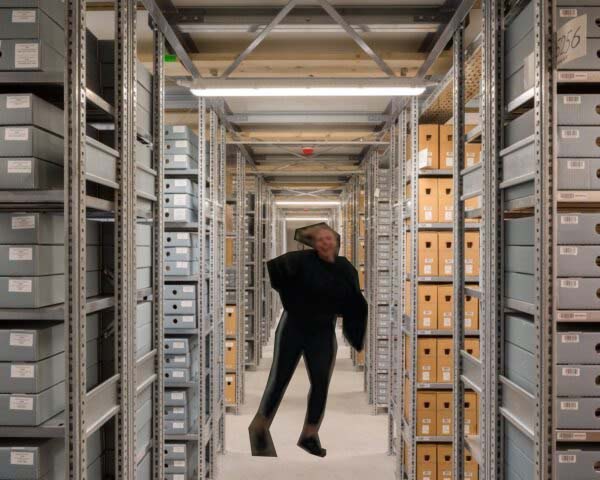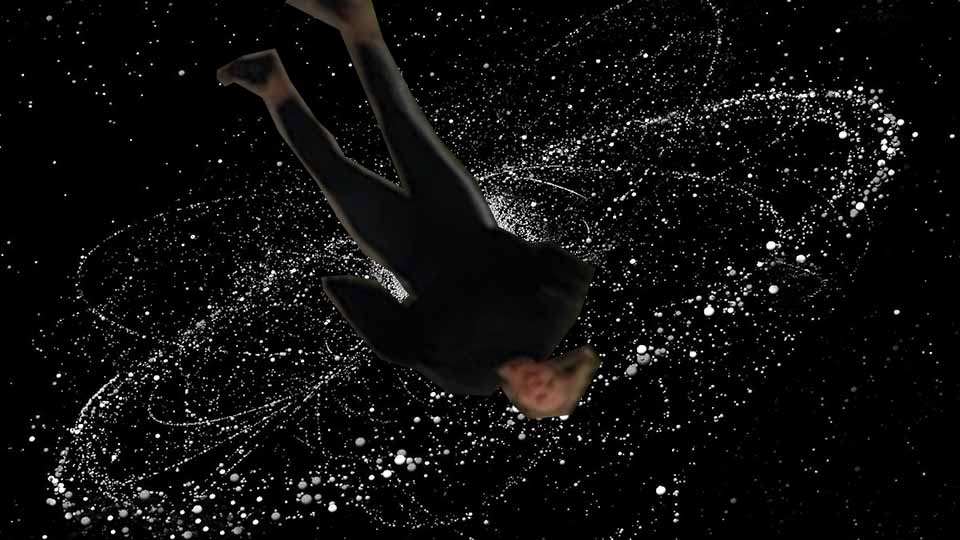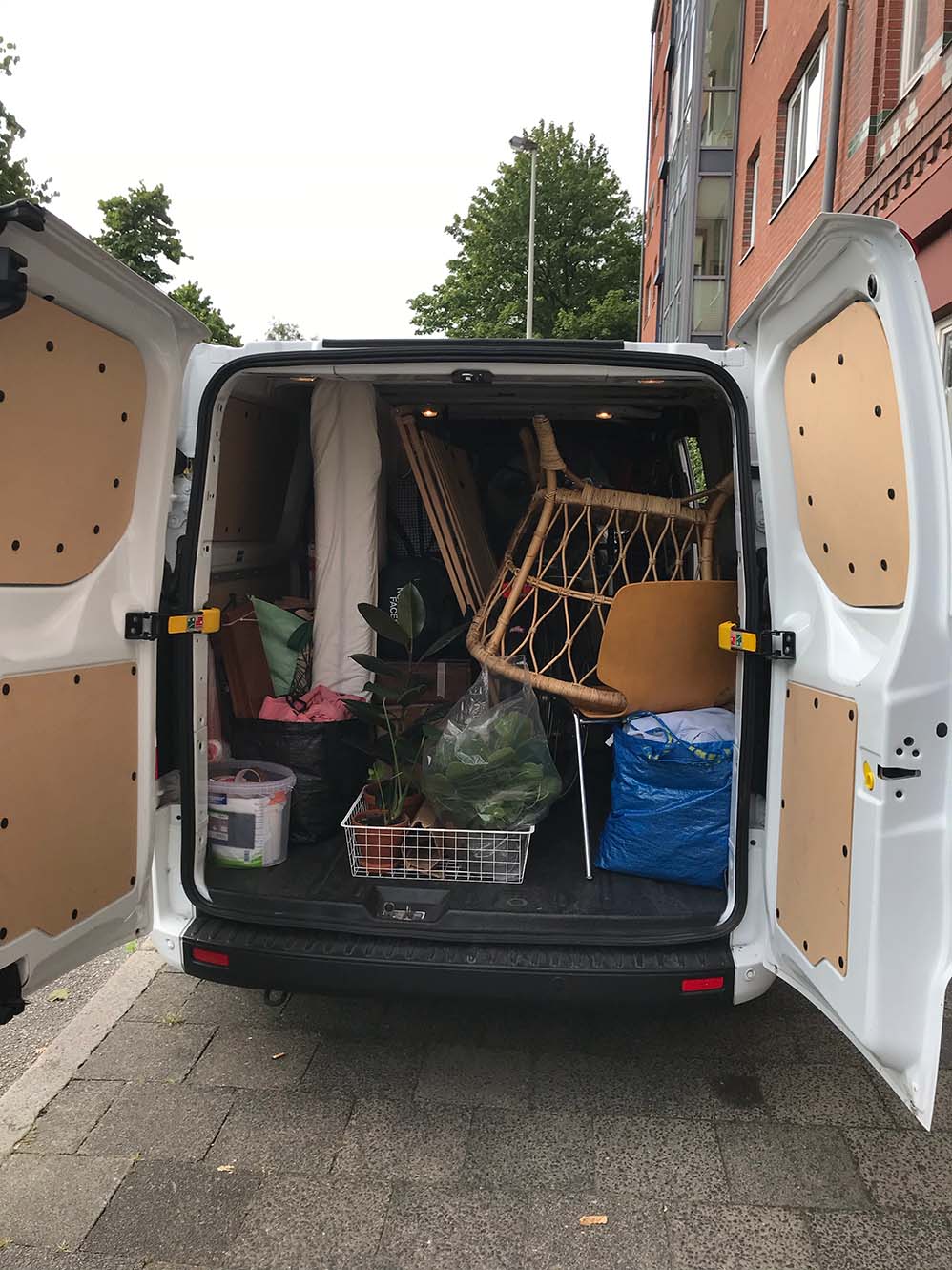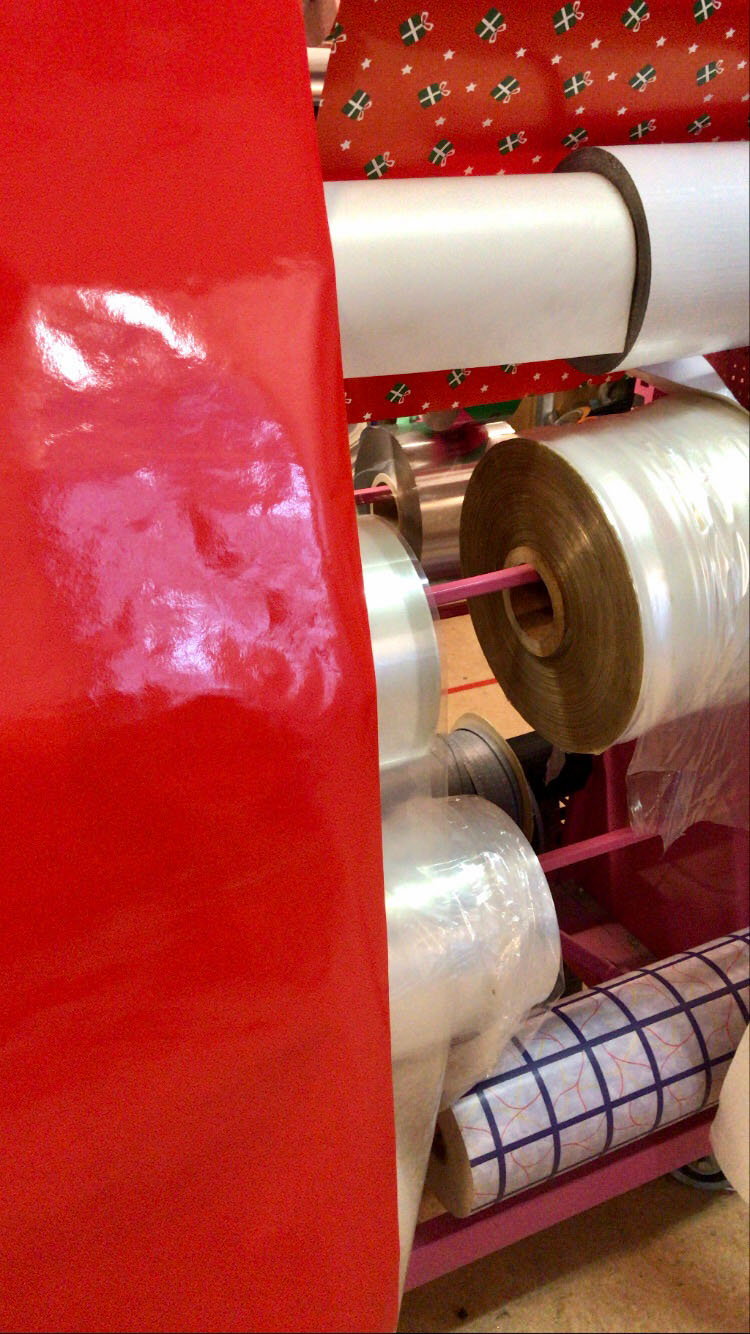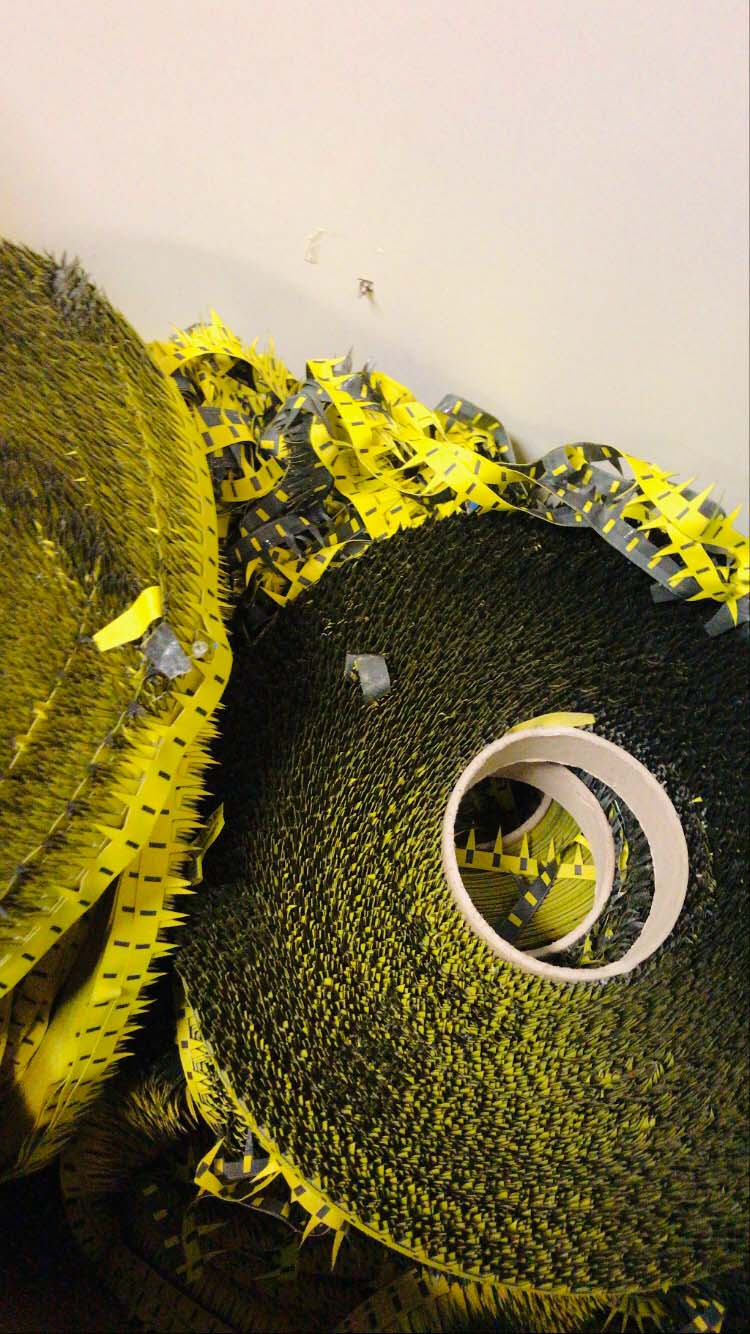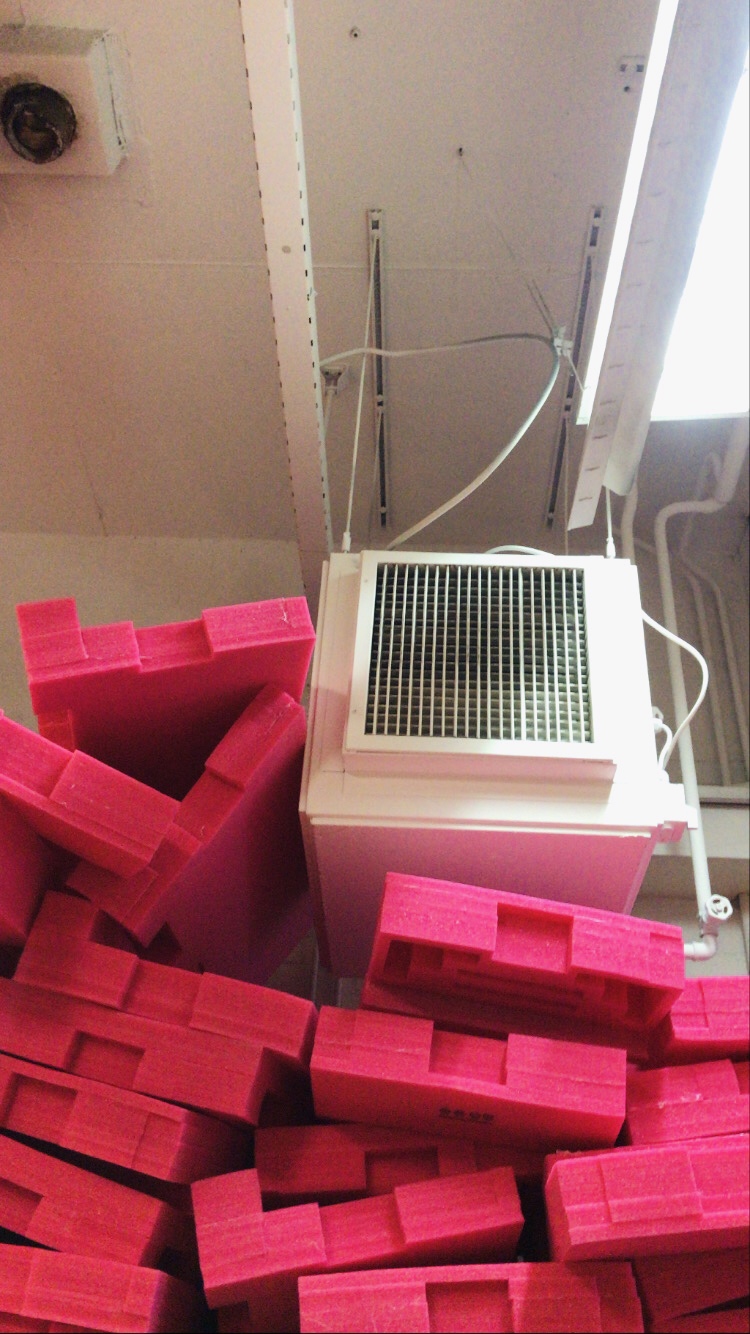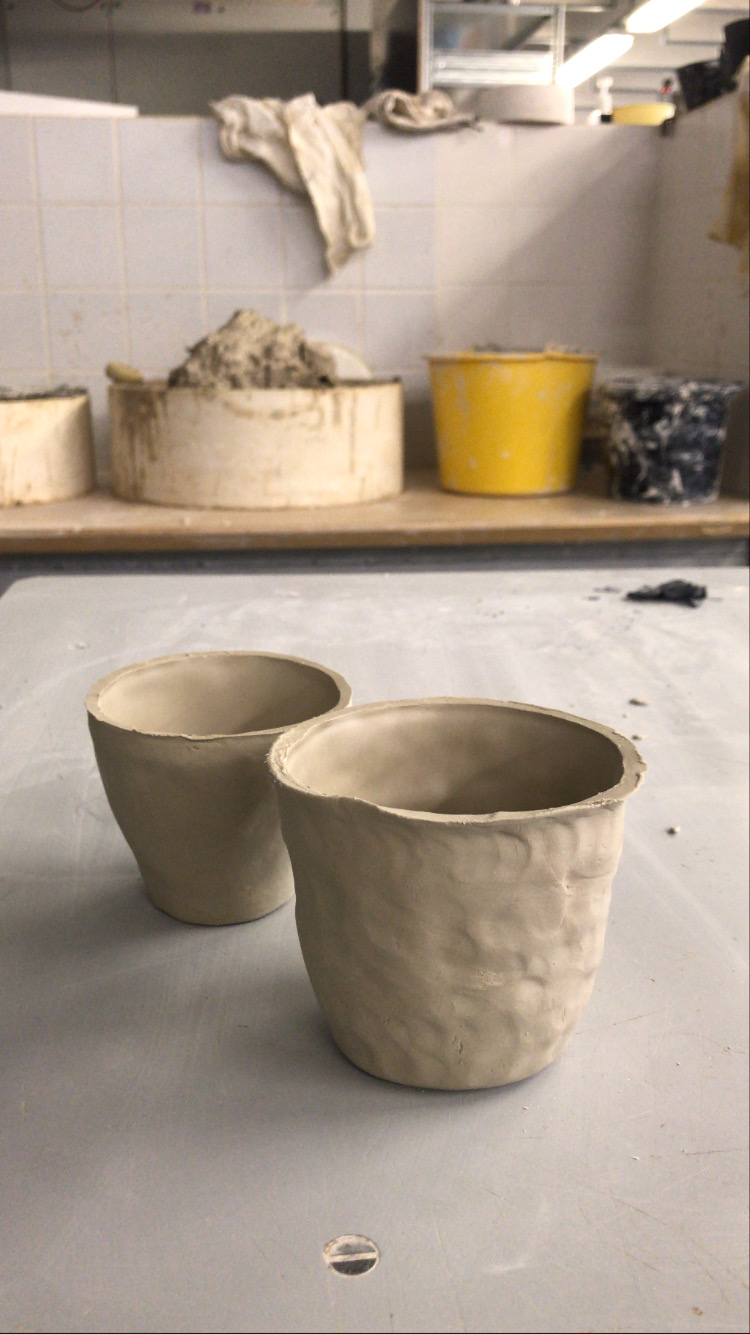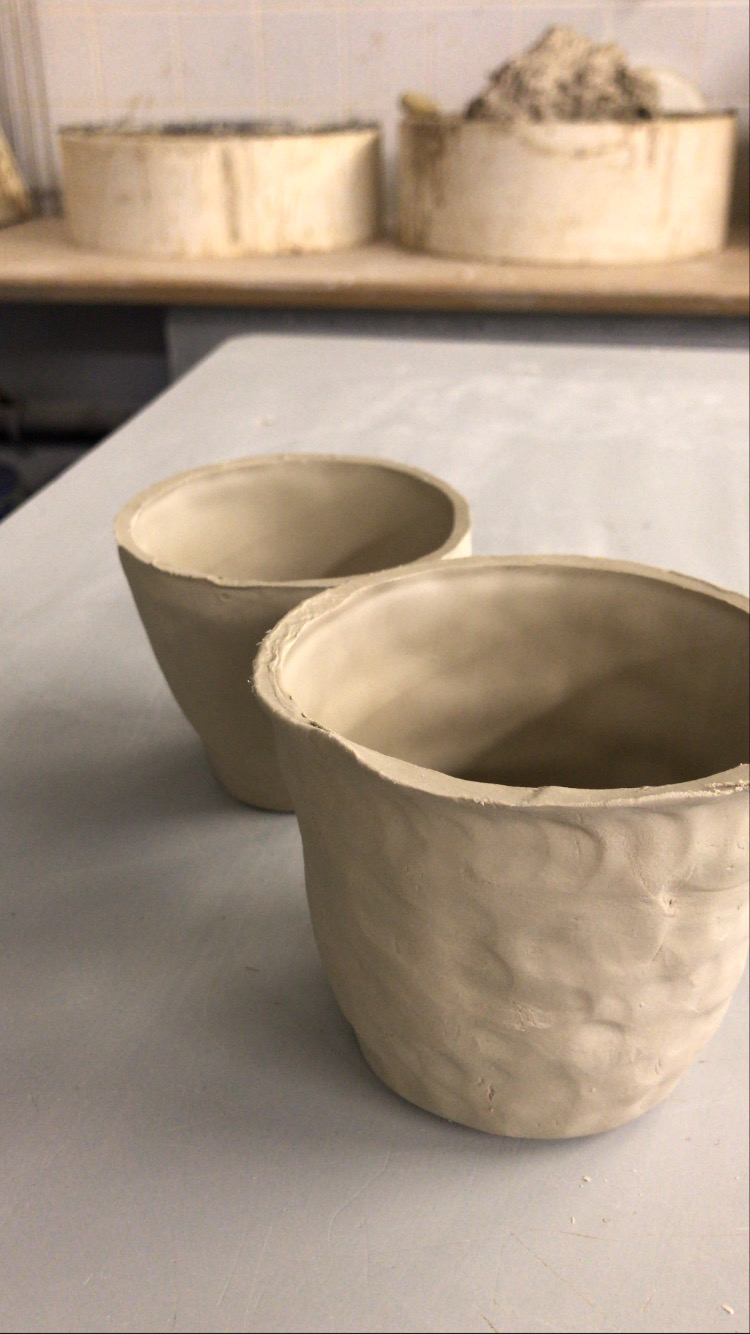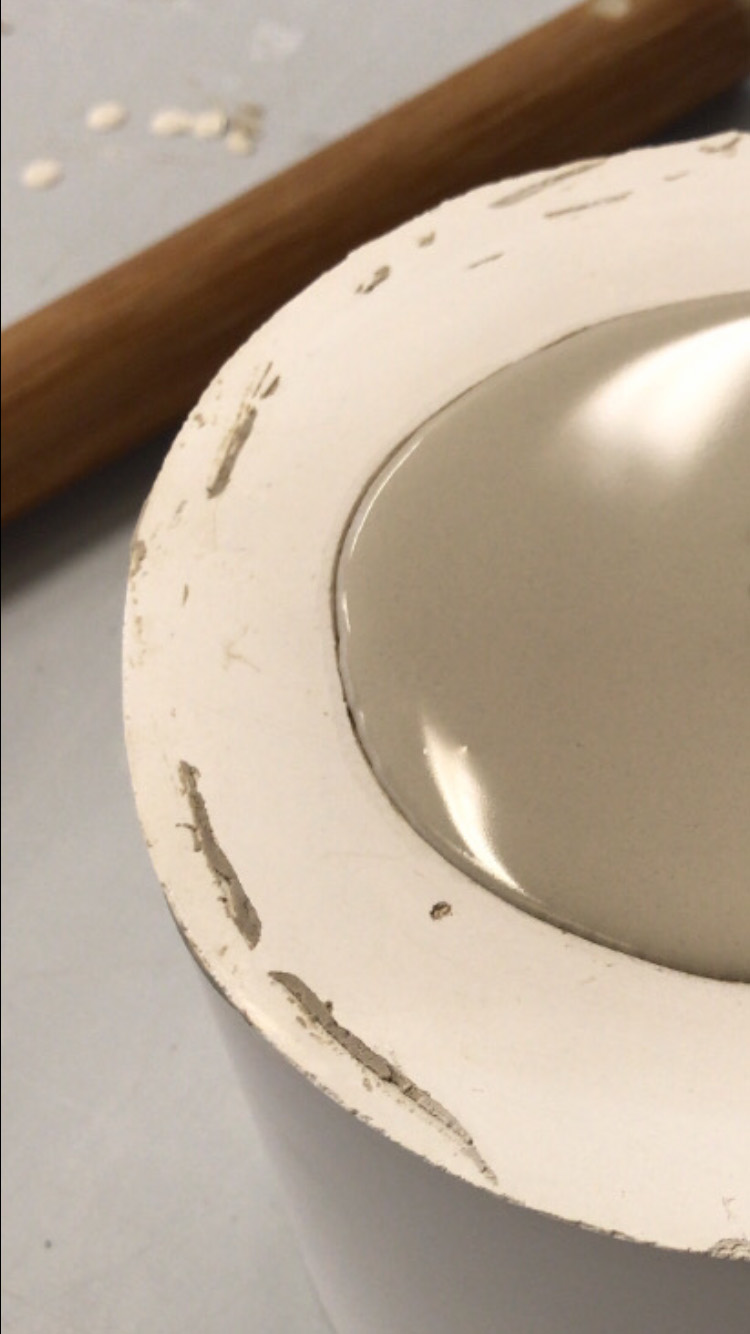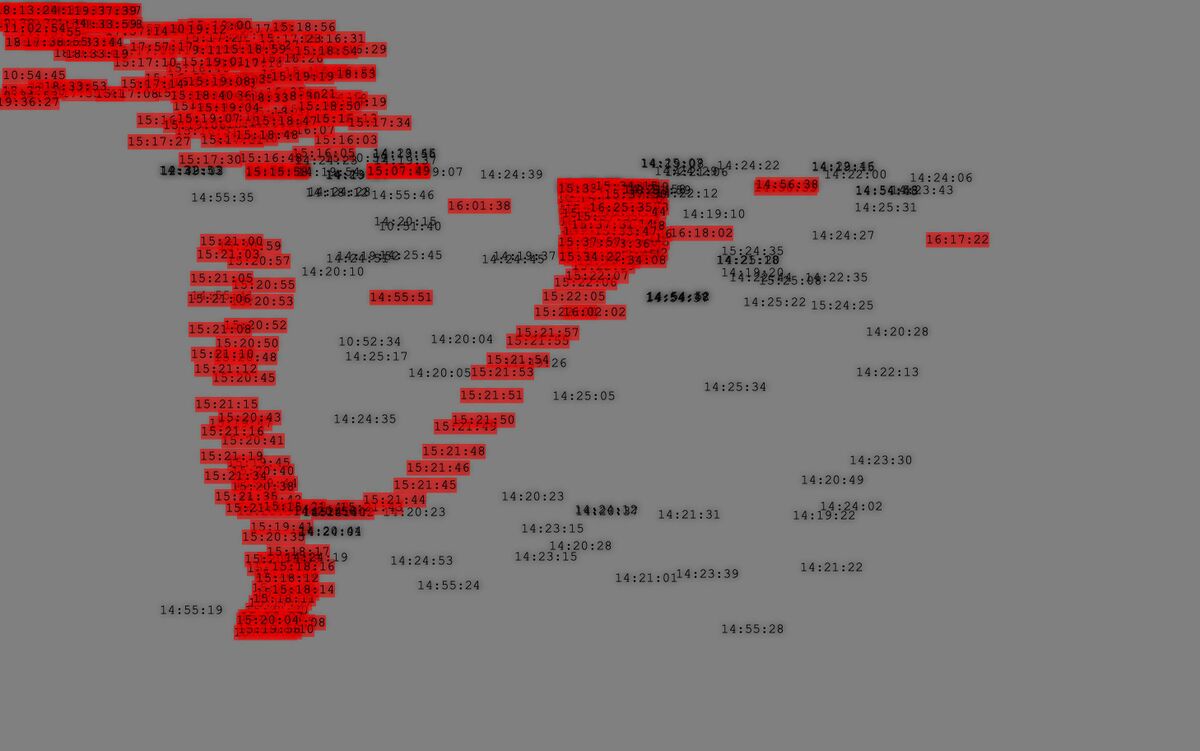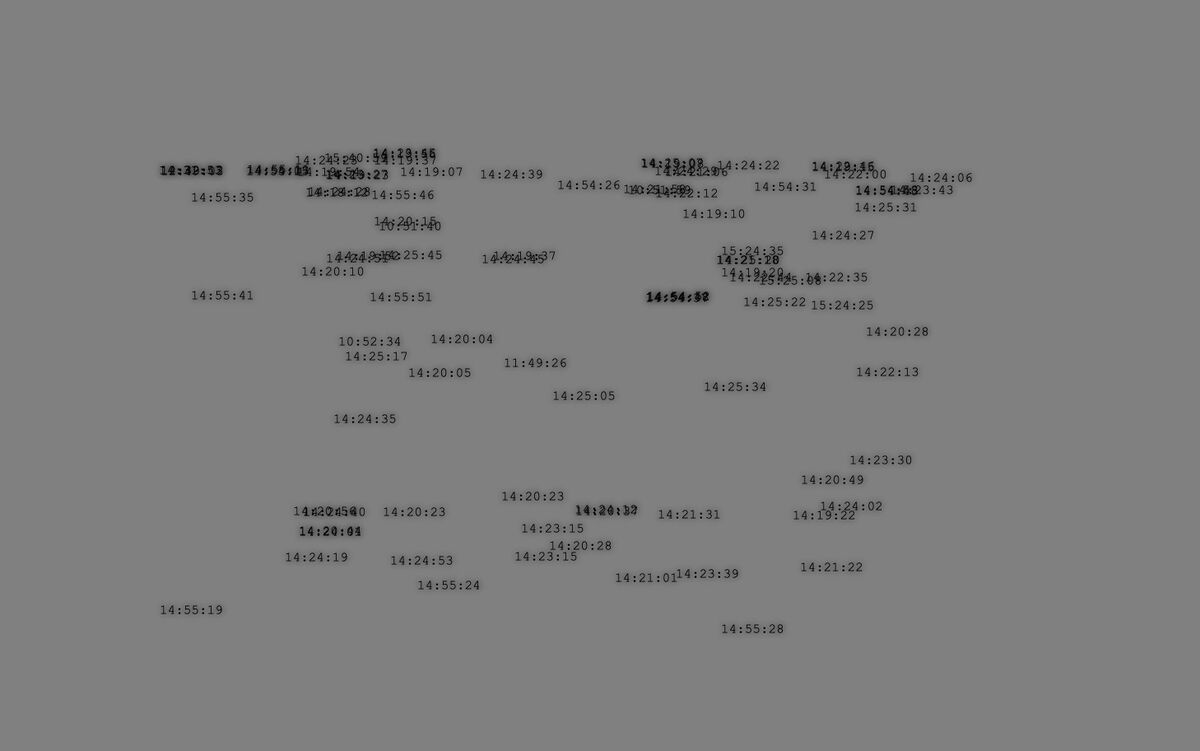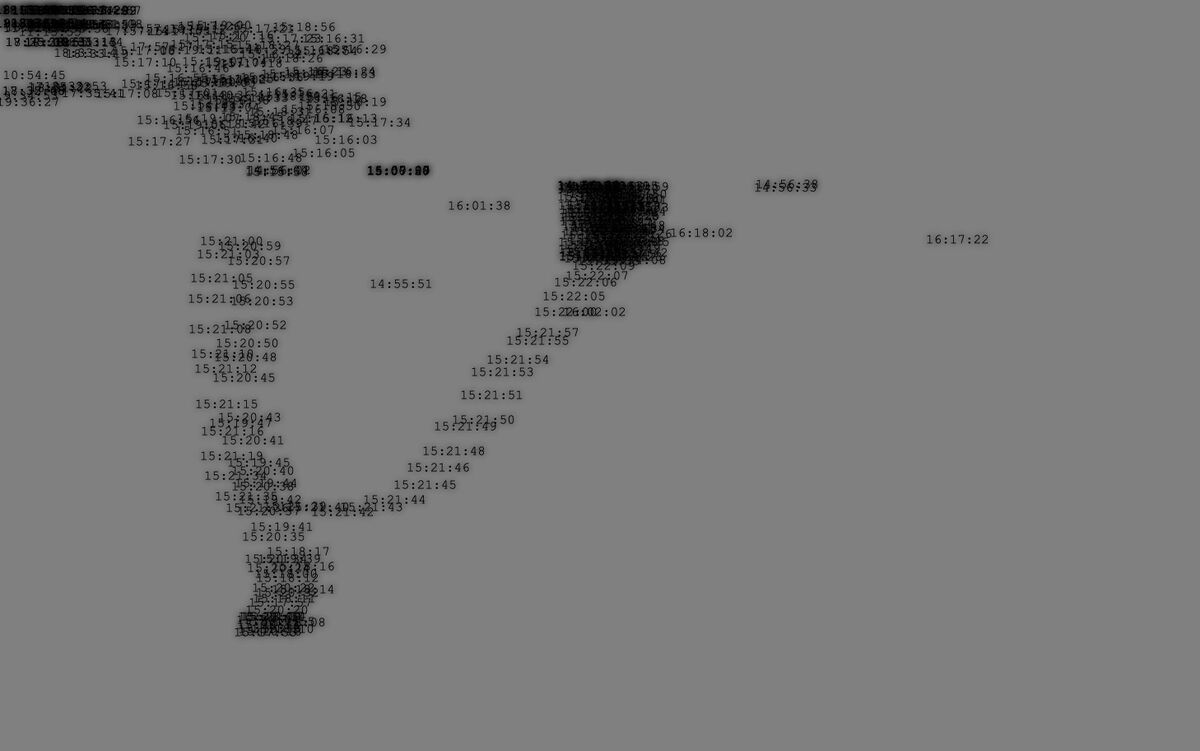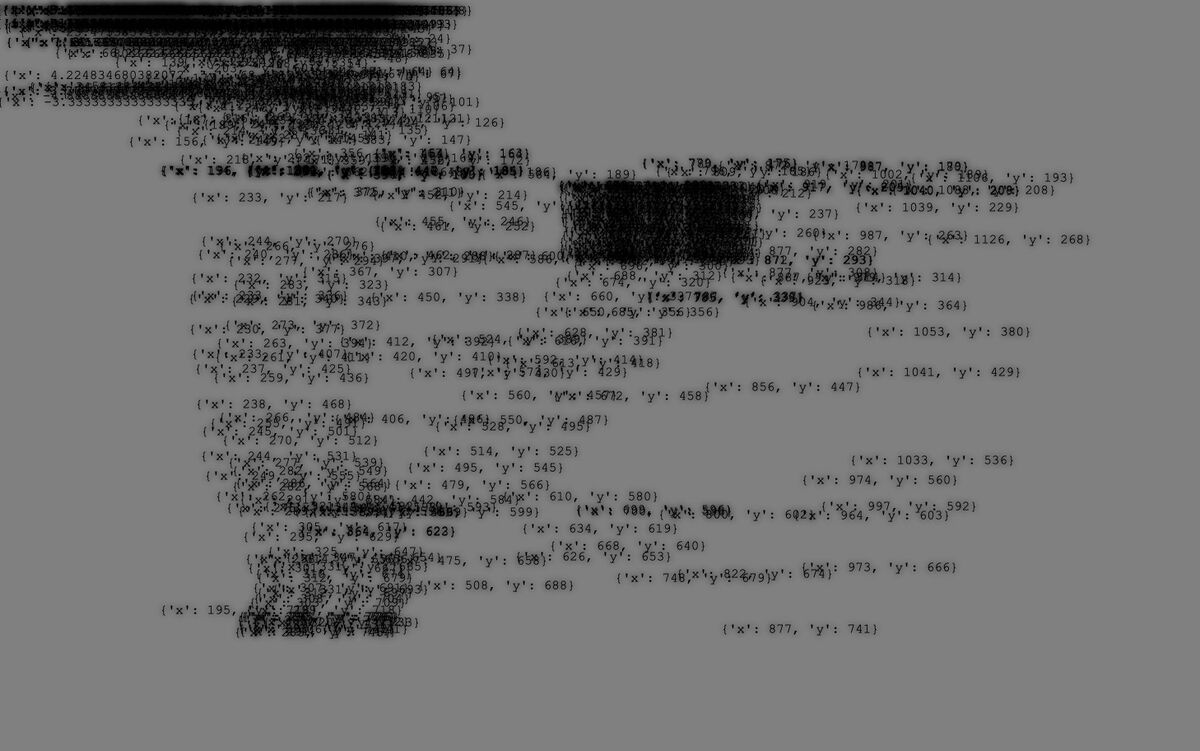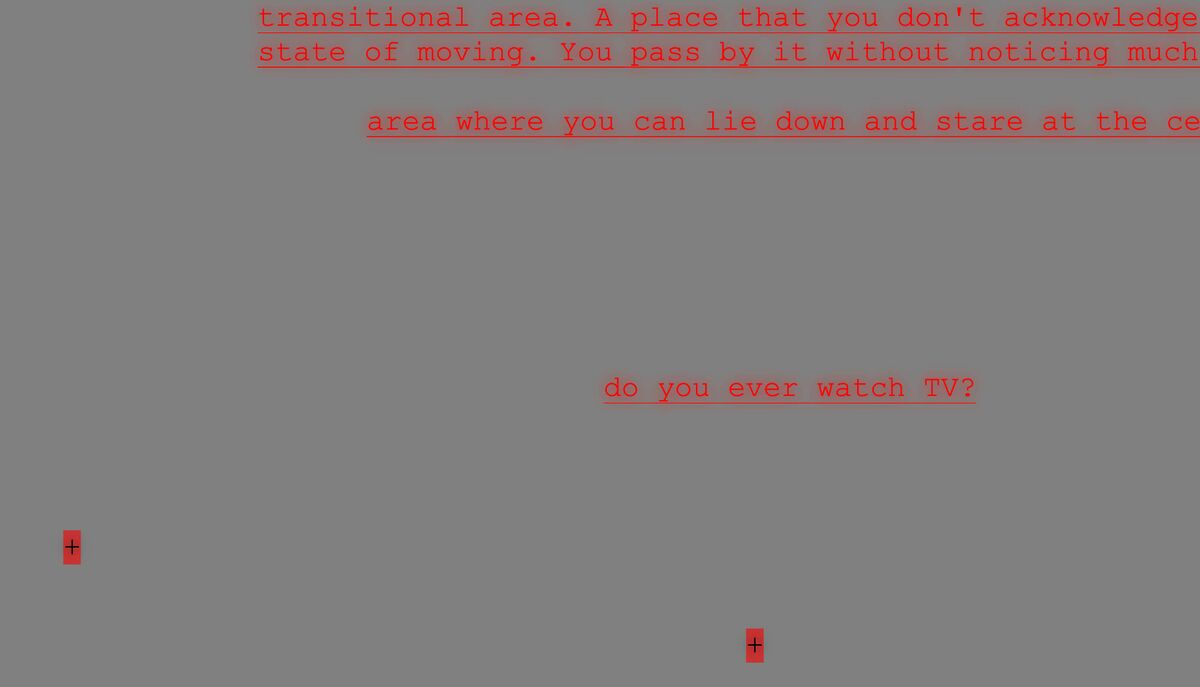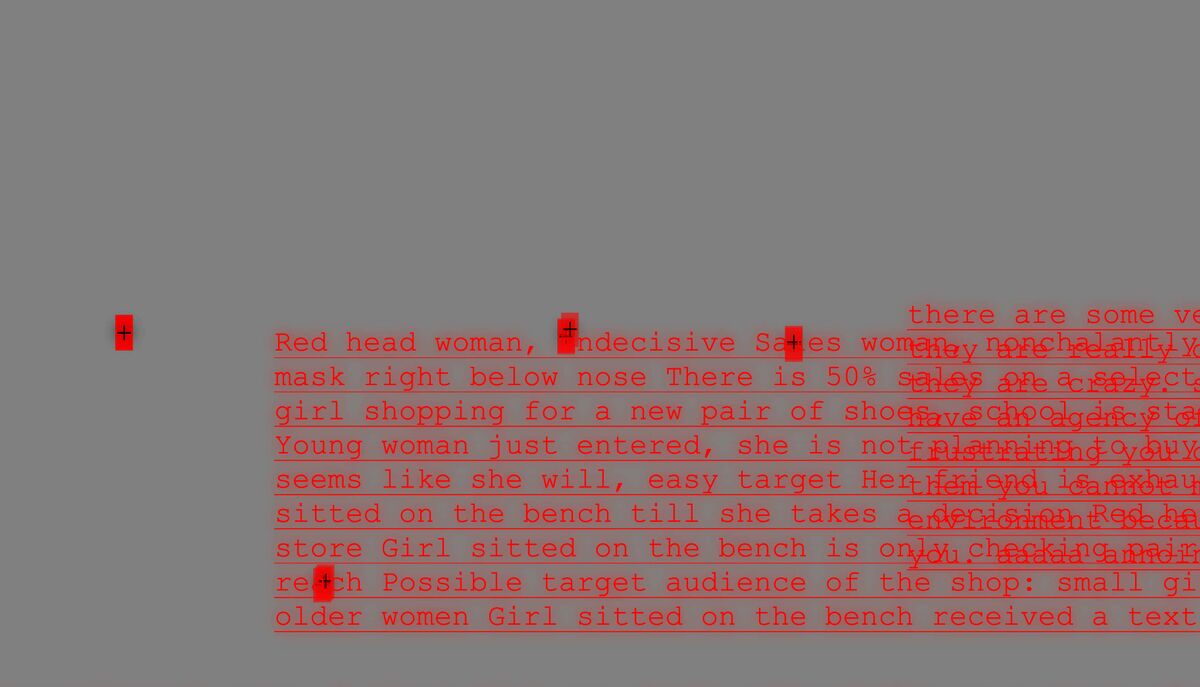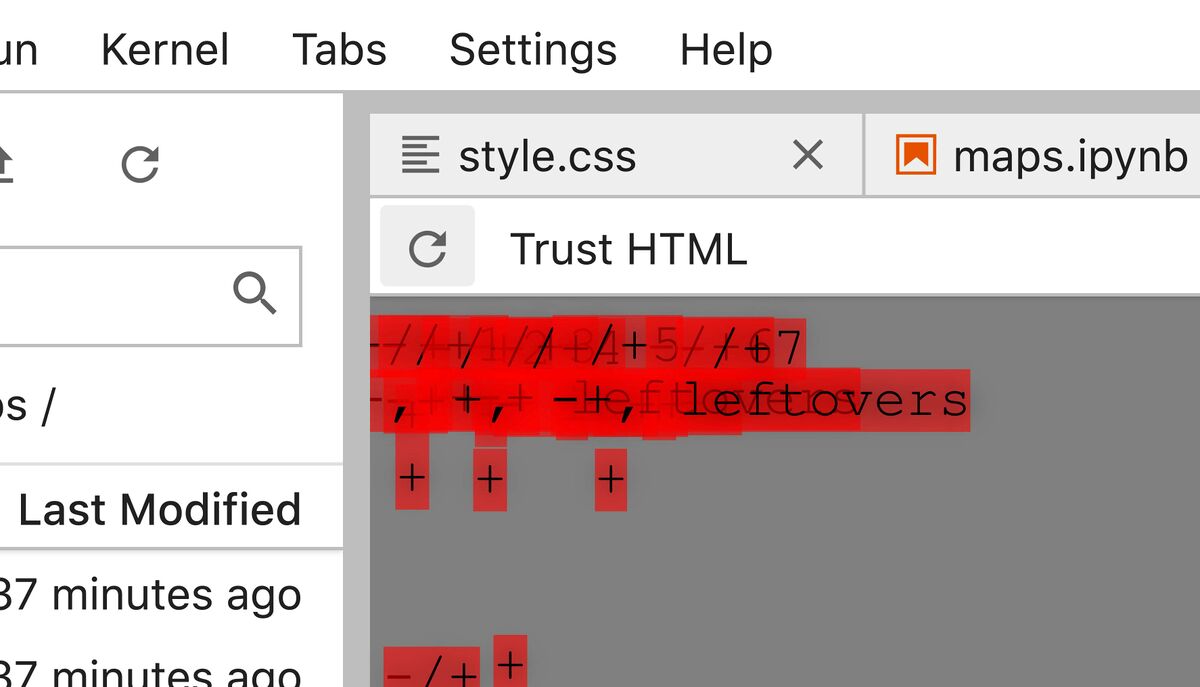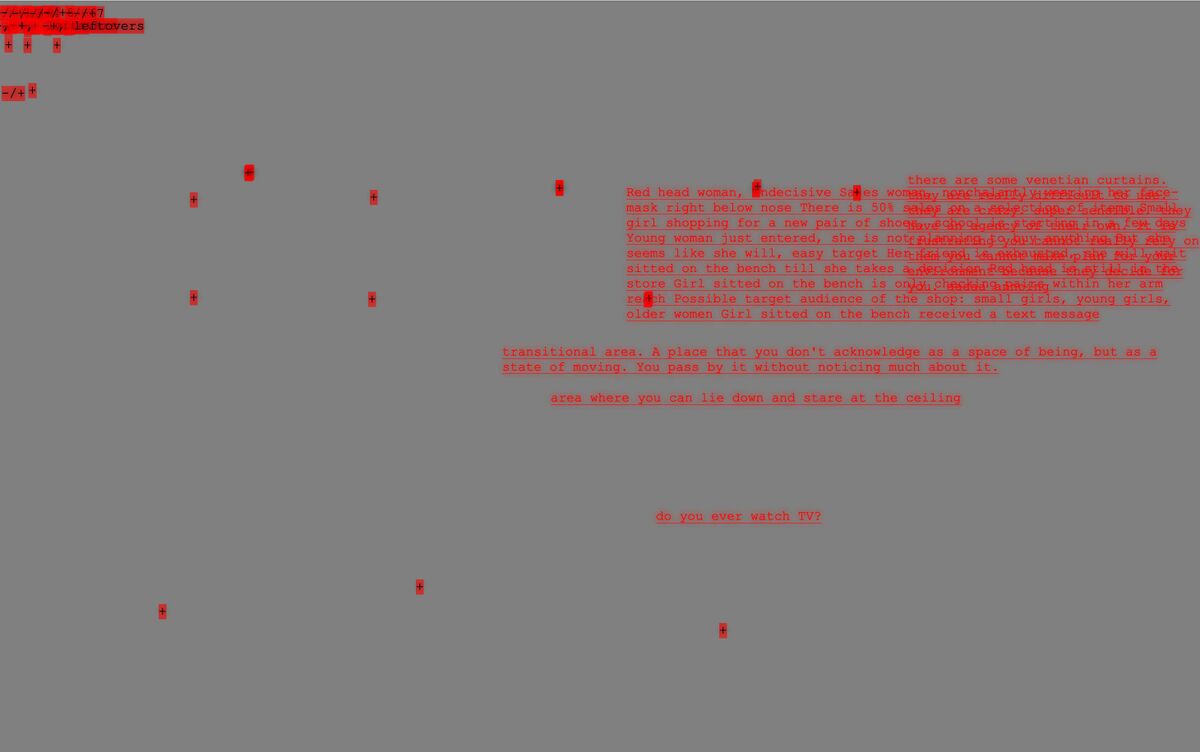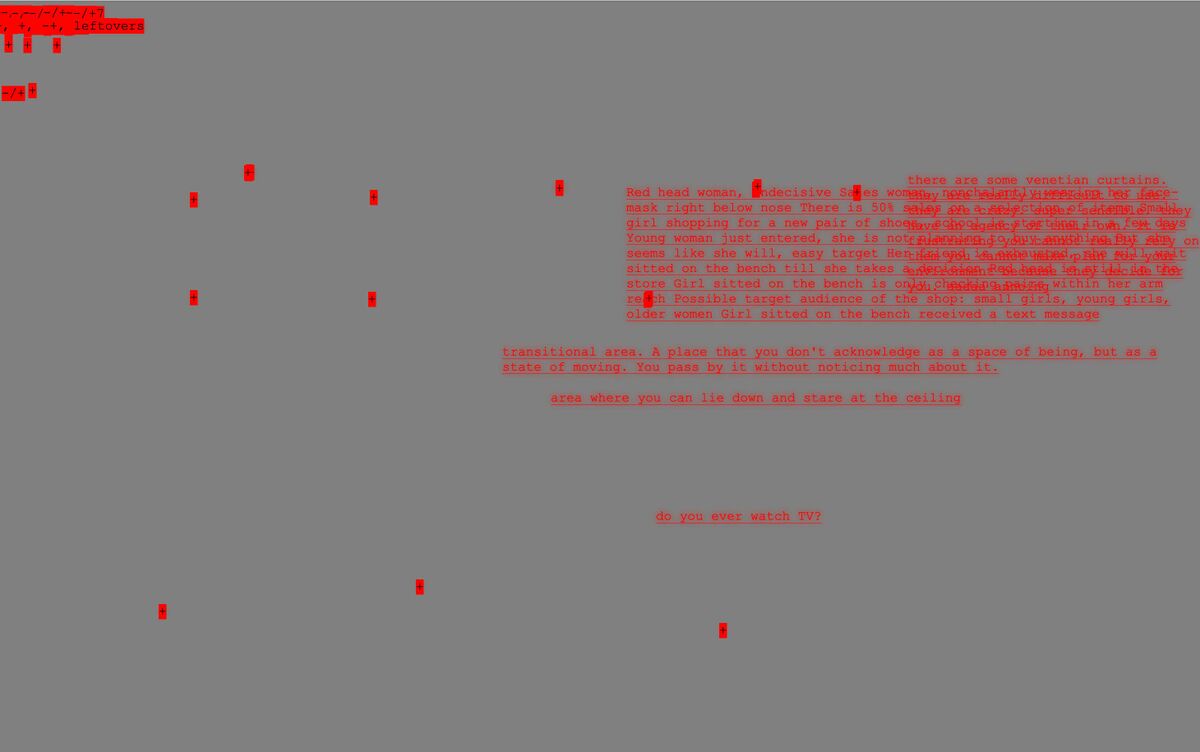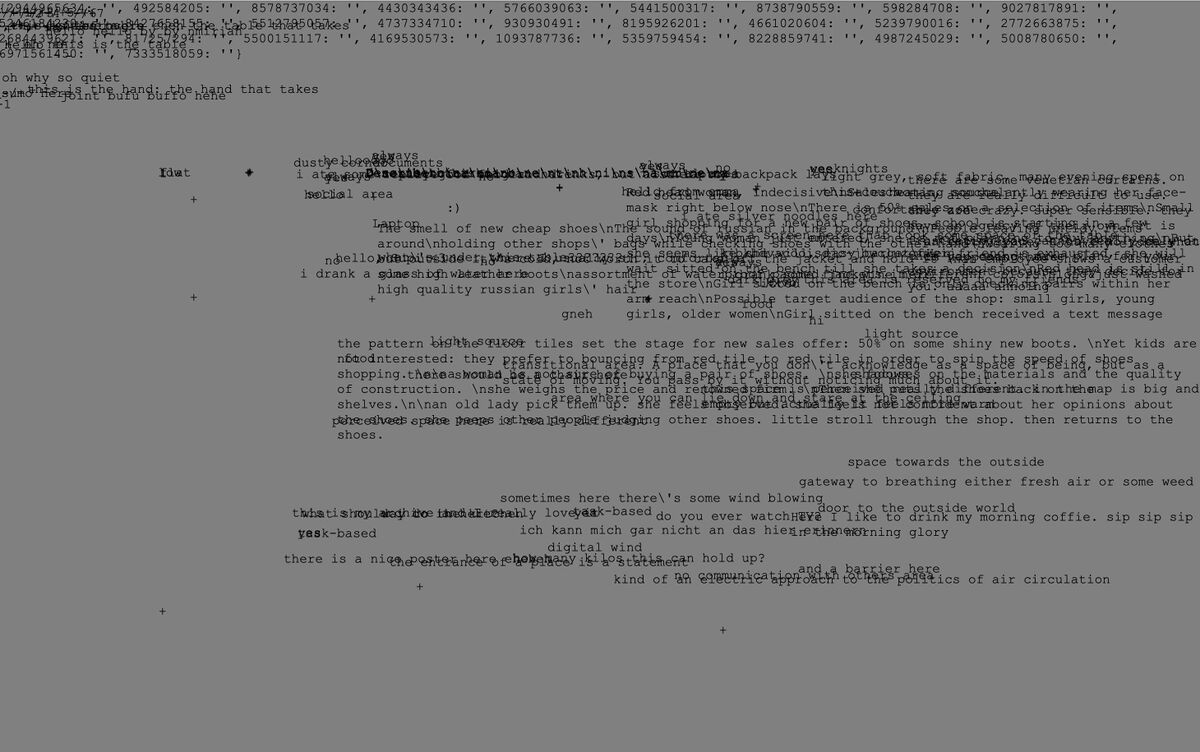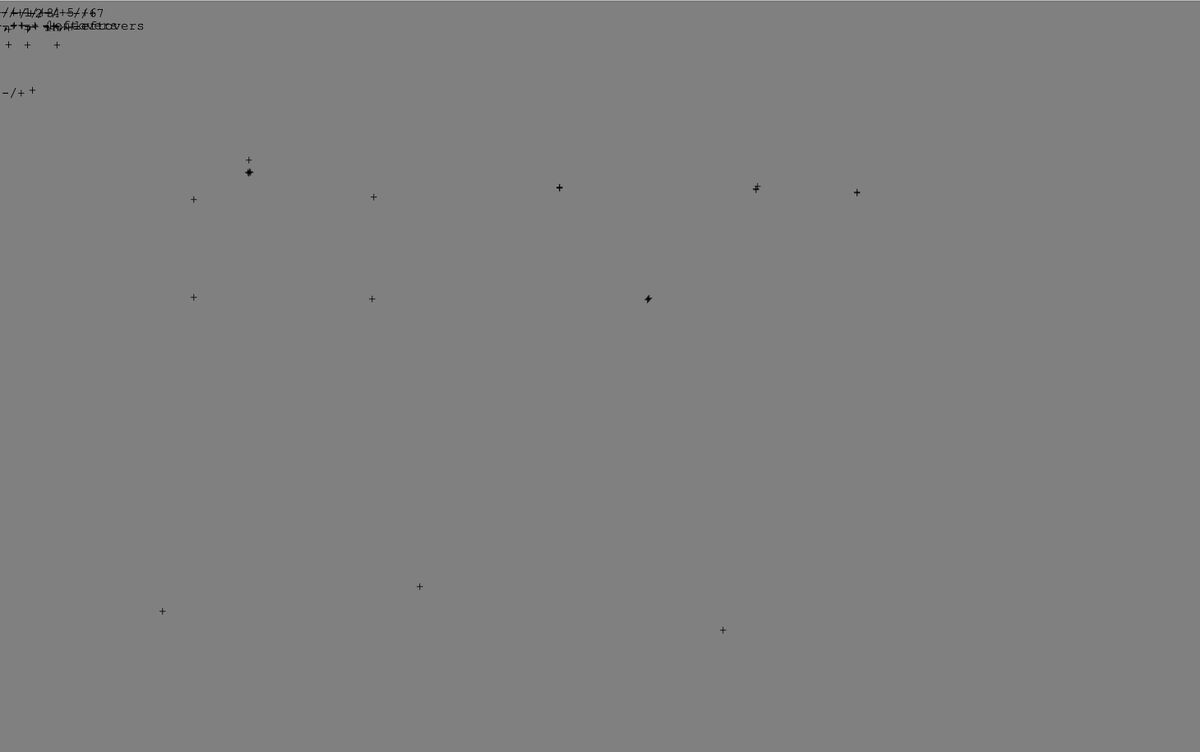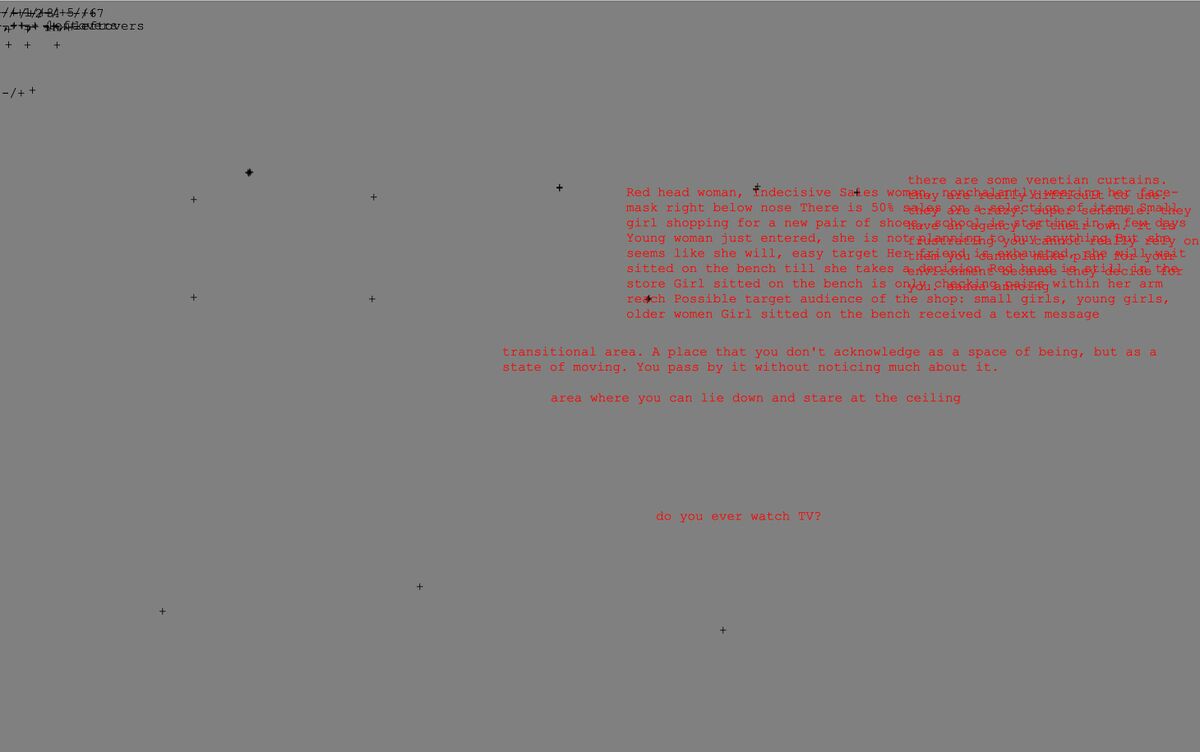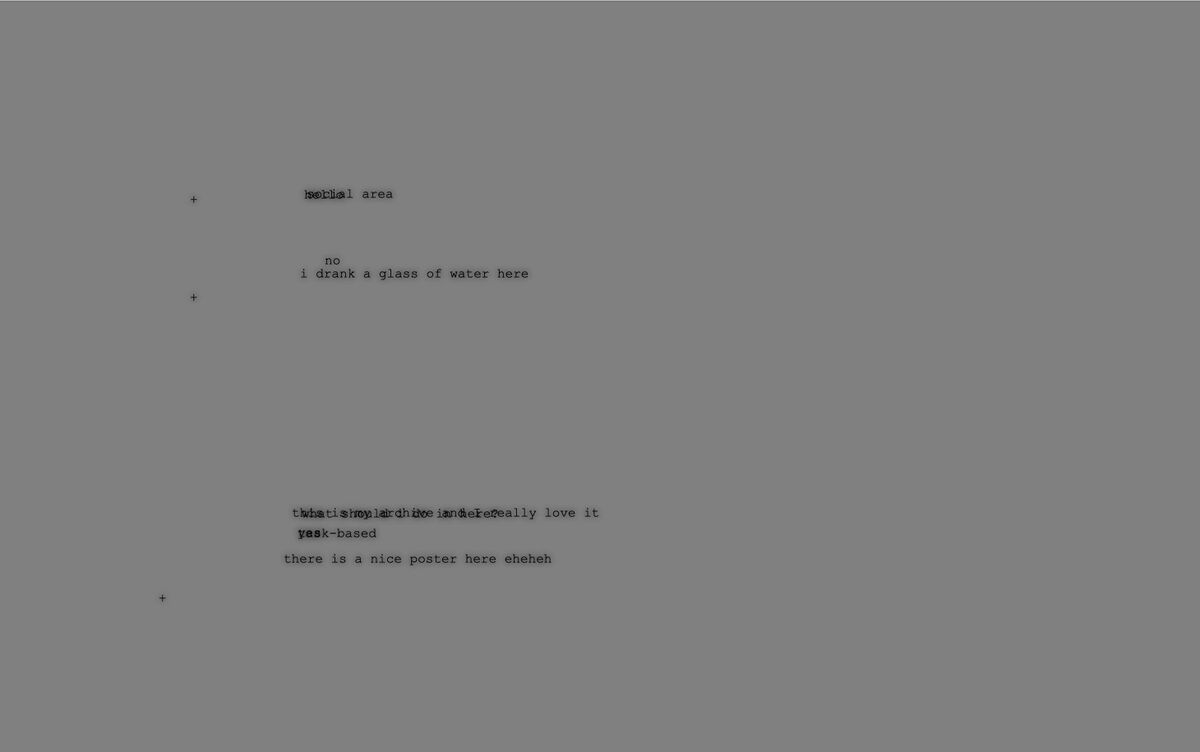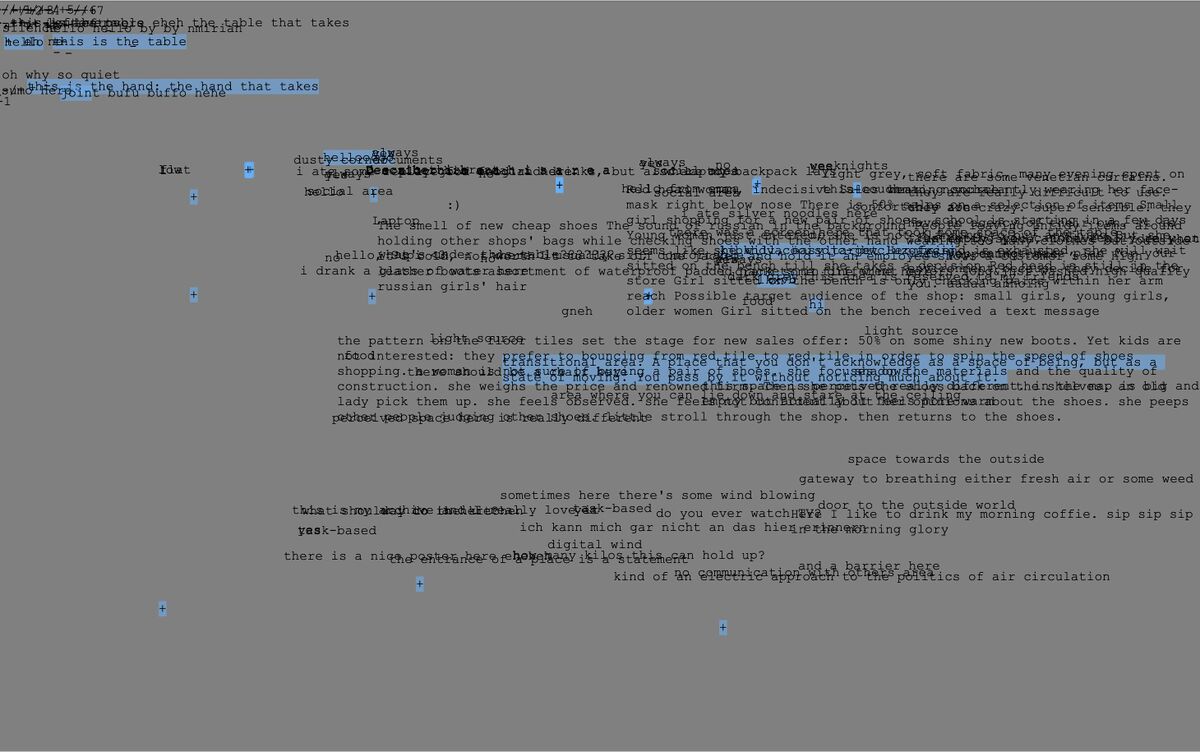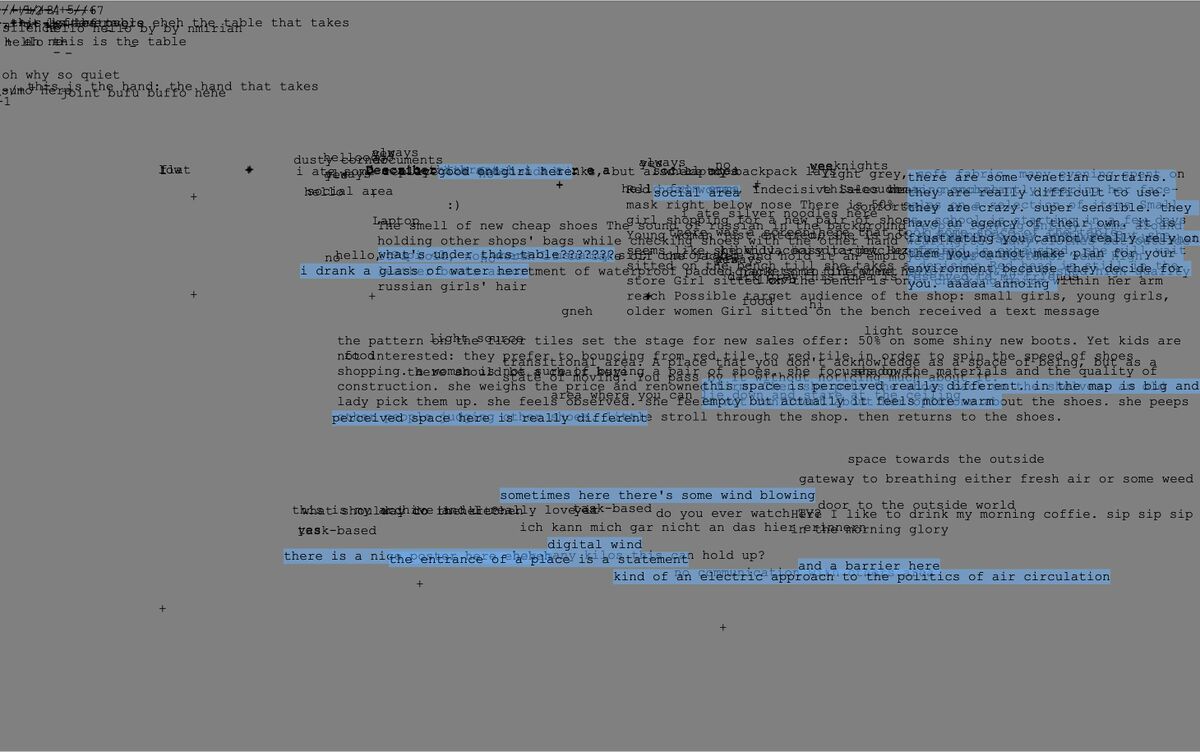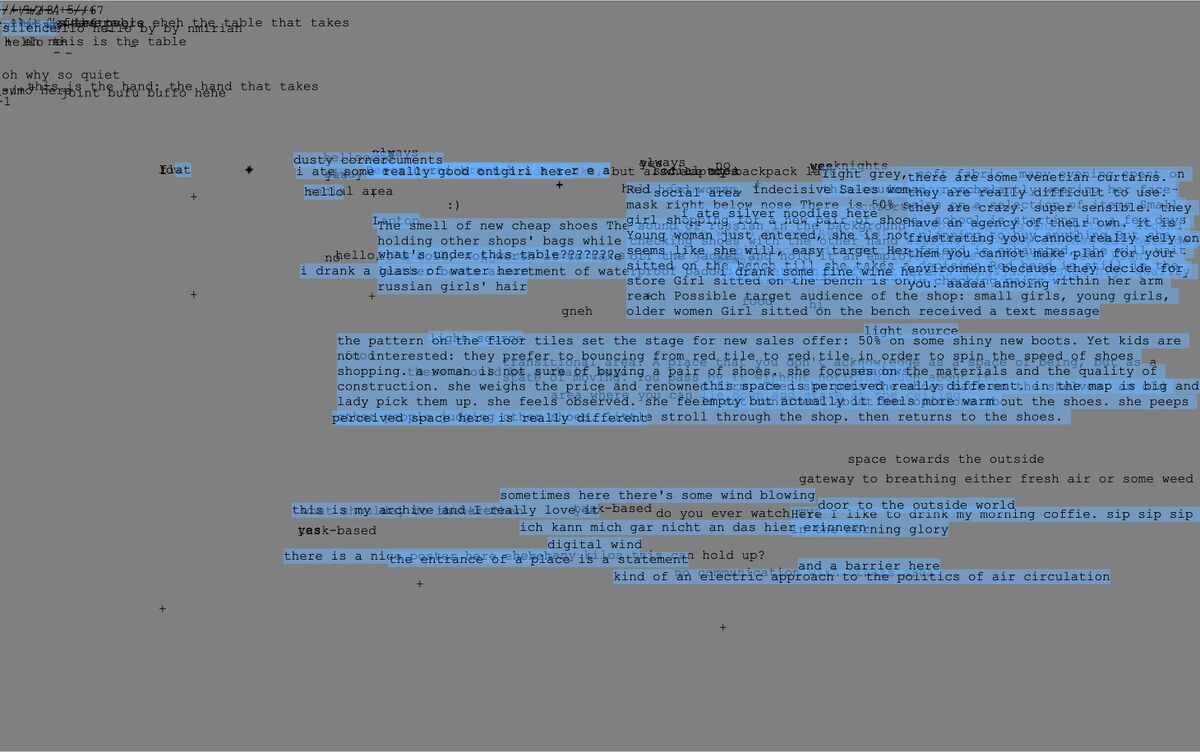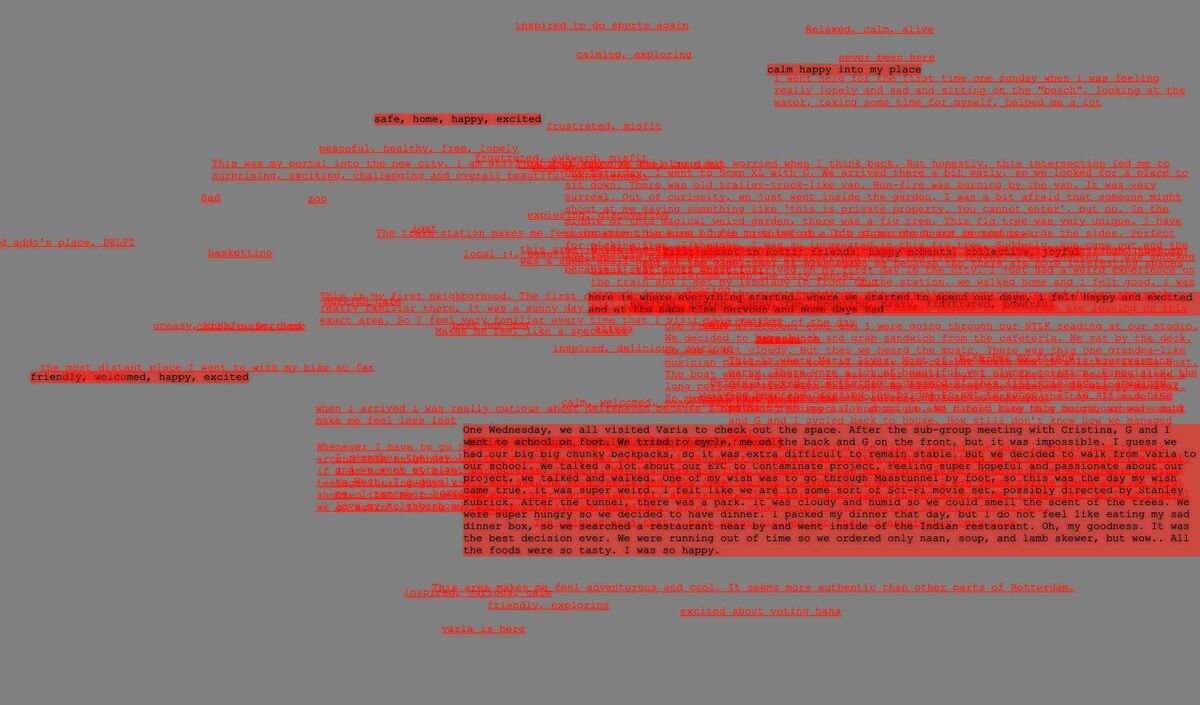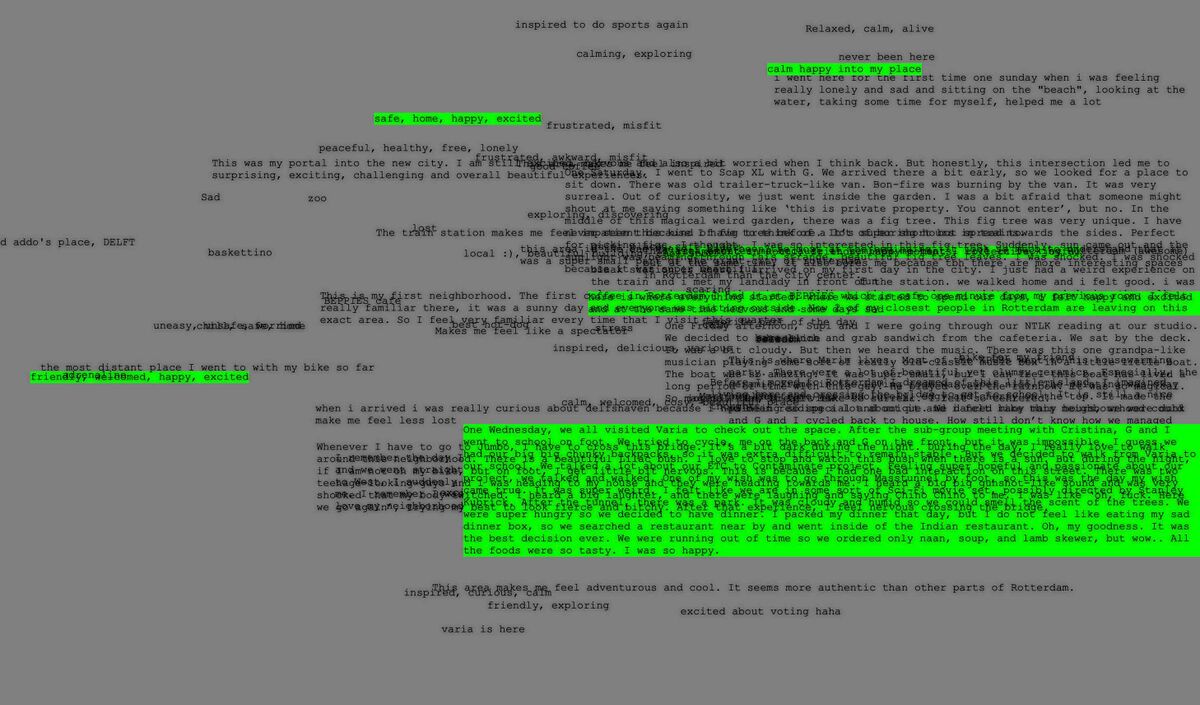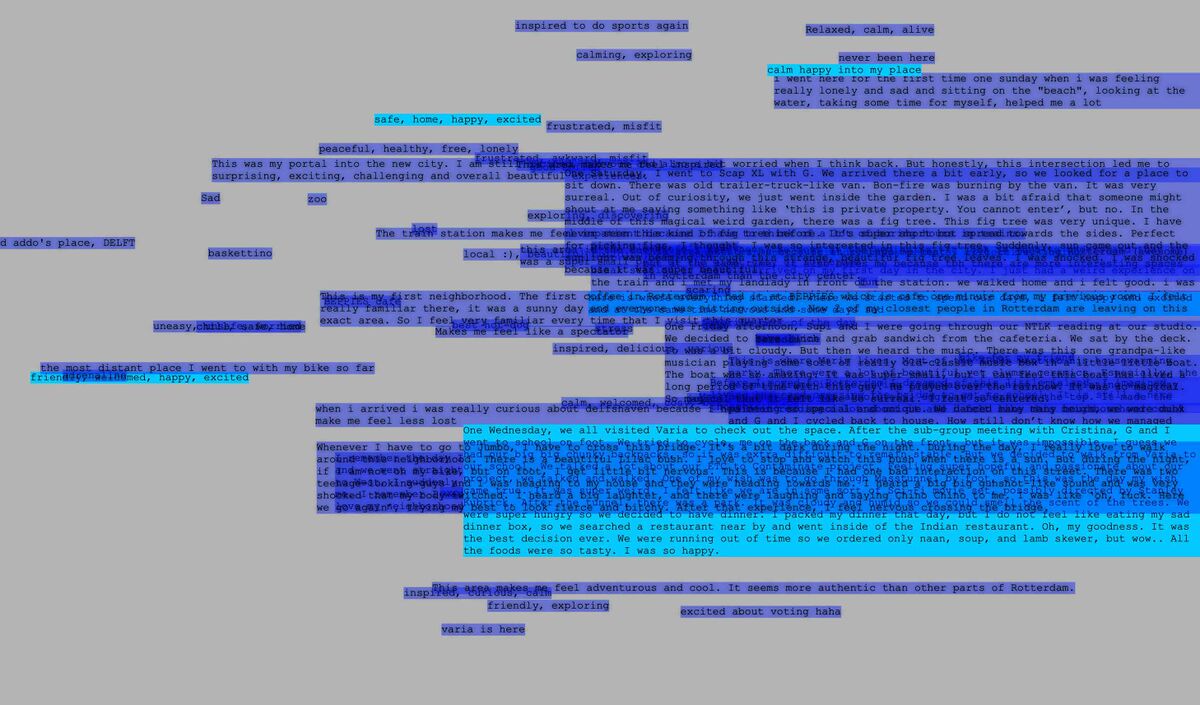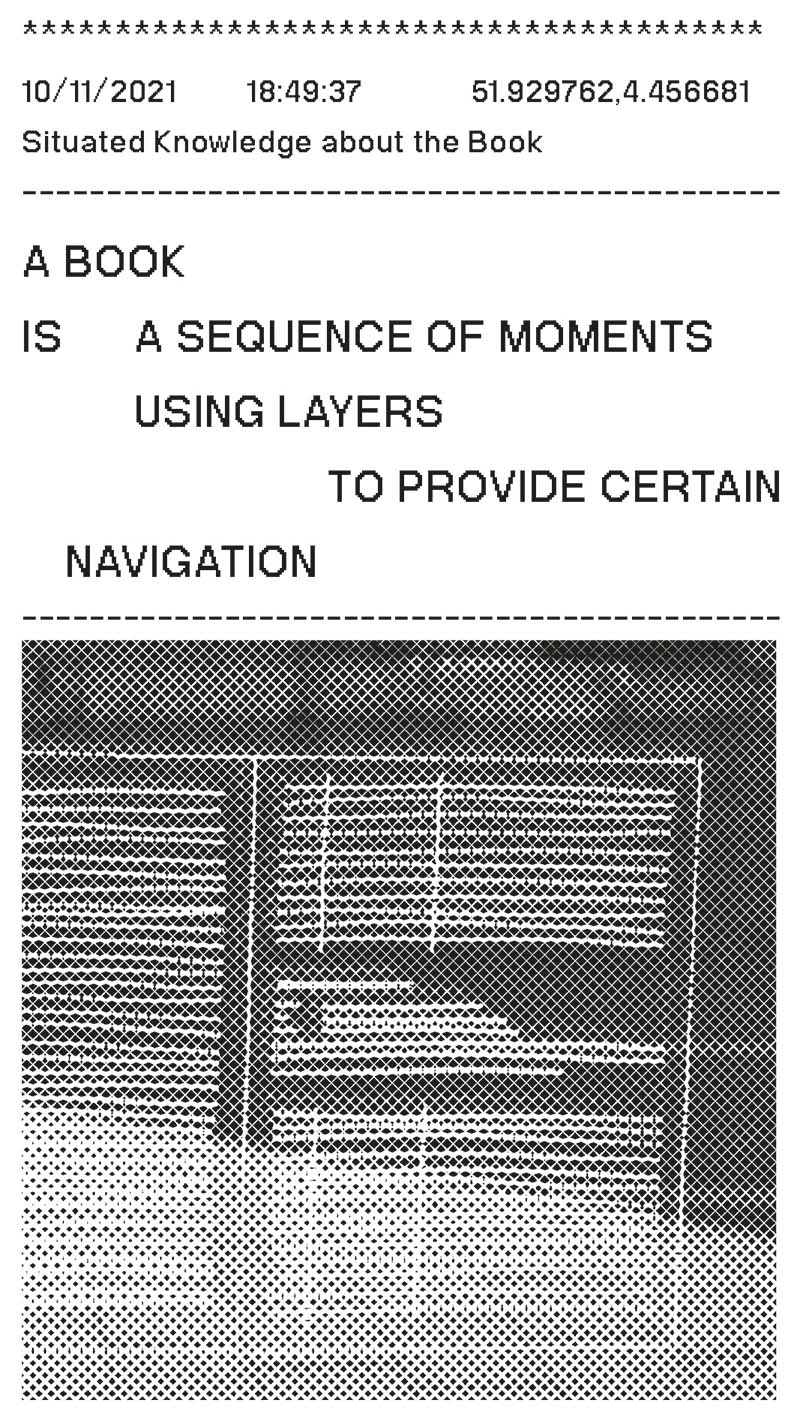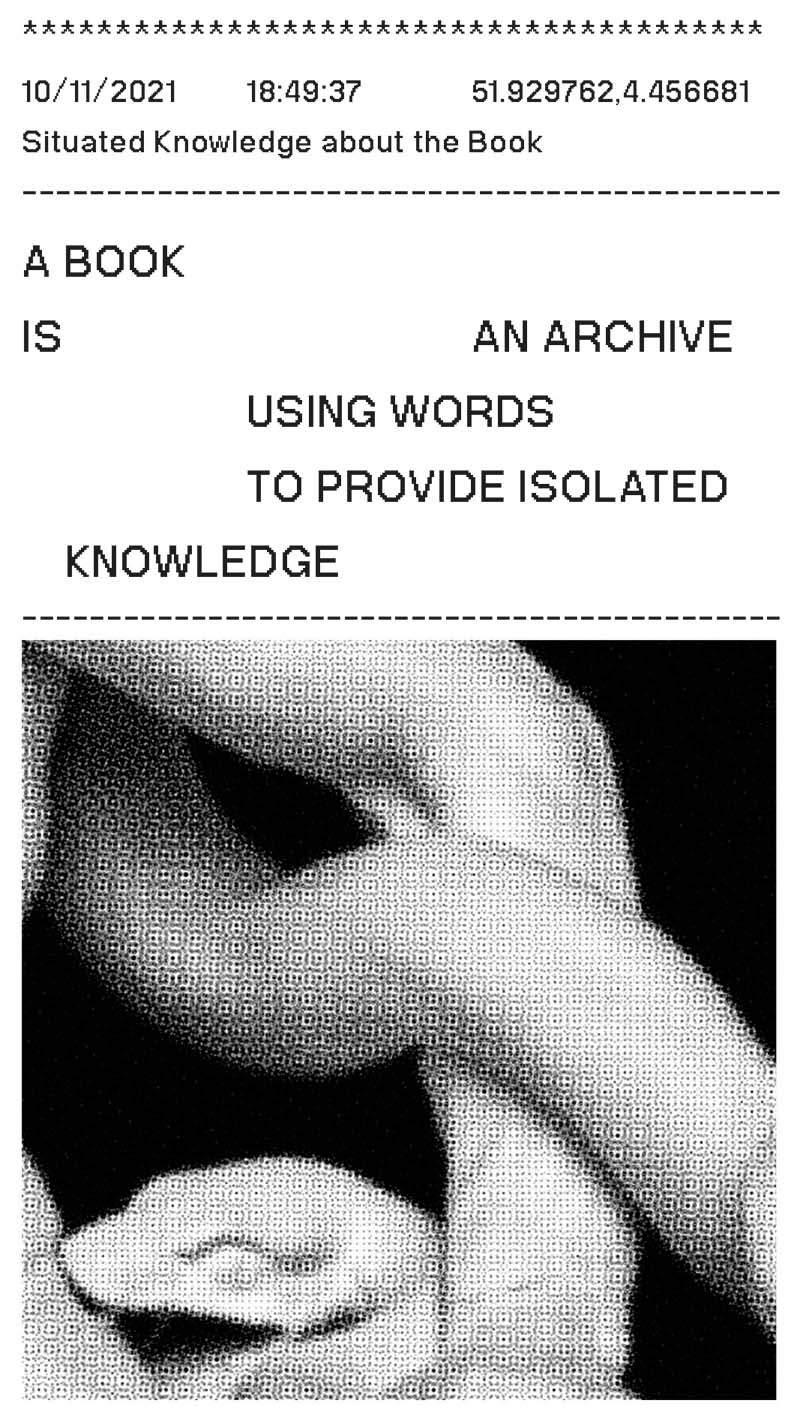User:Ohjian: Difference between revisions
| Line 2,190: | Line 2,190: | ||
===<p style="font-family: Garmond; font-weight: normal; color:#bbbbbb; text-shadow: 10px 10px 18px #FFB6C1, 10px 10px 18px #FFB6C1">Coding the Cocktail Generator</p>=== | ===<p style="font-family: Garmond; font-weight: normal; color:#bbbbbb; text-shadow: 10px 10px 18px #FFB6C1, 10px 10px 18px #FFB6C1">Coding the Cocktail Generator</p>=== | ||
This is a new version of the code, adapted to Aymerics Good Bye Party and to the Epson-Receipt-Printer that works via Ethernet instead of USB. | This is a new version of the code, adapted to Aymerics Good Bye Party and to the Epson-Receipt-Printer that works via Ethernet instead of USB. Oh, and this time the alcohol is optional … | ||
<syntaxhighlight lang="javascript"> | <syntaxhighlight lang="javascript"> | ||
| Line 2,313: | Line 2,313: | ||
<syntaxhighlight lang="javascript"> | |||
*=*=*=*=*=*=*=*=*=*=*=*=*=*=*=* | |||
*=*=*=*=*=*=*=*=*=*=*=*=*=*=*=* | |||
* * | |||
* GOOD BYE FOR NOW, * | |||
* AYMERIC!! * | |||
* * | |||
*=*=*=*=*=*=*=*=*=*=*=*=*=*=*=* | |||
*=*=*=*=*=*=*=*=*=*=*=*=*=*=*=* | |||
150 ml MANGO JUICE | |||
1 oz LIME JUICE | |||
0.5 oz AGAVE SYRUP | |||
2 LEAVES BASIL | |||
1 UMBRELLA | |||
*=*=*=*=*=*=*=*=*=*=*=*=*=*=*=* | |||
OPTIONAL: | |||
2 oz TEQUILA | |||
*=*=*=*=*=*=*=*=*=*=*=*=*=*=*=* | |||
. | |||
. . | |||
|^ . | |||
\O___.____ / | |||
\ . / | |||
\ ,/ | |||
[] | |||
[] | |||
[] | |||
-------- | |||
SEE YOU LATER ALLIGATOR, | |||
AFTER A WHILE CROCODILE! | |||
*=*=*=*=*=*=*=*=*=*=*=*=*=*=*=* | |||
*=*=*=*=*=*=*=*=*=*=*=*=*=*=*=* | |||
</syntaxhighlight> | |||
===<p style="font-family: Garmond; font-weight: normal; color:#bbbbbb; text-shadow: 10px 10px 18px #FFB6C1, 10px 10px 18px #FFB6C1">How to change file on Raspberry Pi</p>=== | ===<p style="font-family: Garmond; font-weight: normal; color:#bbbbbb; text-shadow: 10px 10px 18px #FFB6C1, 10px 10px 18px #FFB6C1">How to change file on Raspberry Pi</p>=== | ||
Revision as of 21:49, 17 February 2022
o h j i a n
Intro
_ _ _ _ _ _ _ _
___ | |__ (_|_) __ _ _ __ | |__ __ _ _ __ _ __ _ _ ___ | |__ (_|_) __ _ _ __ ___ ___ __ _ _ __ ___ __| |
/ _ \| '_ \ | | |/ _` | '_ \ | '_ \ / _` | '_ \| '_ \| | | | / _ \| '_ \ | | |/ _` | '_ \ / __|/ __/ _` | '__/ _ \/ _` |
| (_) | | | || | | (_| | | | | | | | | (_| | |_) | |_) | |_| | | (_) | | | || | | (_| | | | | \__ \ (_| (_| | | | __/ (_| |
\___/|_| |_|/ |_|\__,_|_| |_| |_| |_|\__,_| .__/| .__/ \__, | \___/|_| |_|/ |_|\__,_|_| |_| |___/\___\__,_|_| \___|\__,_|
|__/ |_| |_| |___/ |__/
! echo ohjian happy ohjian scared | figlet
Special Issue #16
Getting Started
Moving to Rotterdam
Intro Week
Readings
[ ] "Situated Knowledges. The Science Question in Feminism and the Privilege of Partial Perspective", Donna Haraway
[ ] "Orientation in a big world", Patricia Reed
[ ] "Vernacular Order, Official Order / Vernacular and Official Ways of 'Knowing'", James C. Scott
[ ] "Queer Phenomenology. Orientations, Objects, Others", Sara Ahmed
[ ] "Vernacular Values", Ivan Illich
[ ] "This Is Not an Atlas - A Global Collection of Counter-Cartographies", Kollektiv Orangotango+
[ ] "Control and Freedom. Power and Paranoia in the Age of Fiber Optics", Wendy Hui Kyong Chun
[ ] "Post-Digital Print. The Mutation of Publishing since 1894", Alessandro Ludovico
[ ] "Sprache und sein", Kübra Gümüşay
[ ] "Performative Materiality and Theoretical Approaches to Interface", Johanna Drucker
References
[ ] "A Rose is a Rose is a rose", Gertrude Stein
[ ] Oulipu
[ ] George perec
[ ] "Dictionary of Winds", Ivetta Gerasimchuk
[ ] "This Variation", Tino Sehgal
[ ] Clusterduck
[ ] "Anekdoten zu einer Topographie des Zufalls", Daniel Spoerri
[ ] "Queering the Map", Lucas laRochelle
[ ] Palestine Open Maps, Majd Al-shihabi
[ ] Learning Machines, George Maciunas
[ ] Marcel Duchamp
[ ] Lucy Lippard - C. 7,500
[ ] Anni Albers weavings
[ ] Marcel Broodthaers – musée d'art moderne département des aigles 1968–72
[ ] Aby Warburg
[ ] Snail Mail
[ ] Harals Szeeman – Documenta 5
[ ] Telemagic
[ ] OMSK Social Club
[ ] Chimeric Worlding
[ ] Hackers & Designers
Pads
| Category | YYYY/MM/DD | Title | Description | Links |
|---|---|---|---|---|
| Prototyping | 2021/09/27 | Main Pad | Link | |
| Special Issue | 2021/09/28 | My Sub Group | Text Traversion with Supi + Alex | Link |
| Reading + Writing | 2021/09/22, 09/28/2021 | Main Pad | Queer Phenomenology, Sara Ahmed | Link |
| Reading + Writing | 2021/09/22 | My Sub Group | Annotating Johanna Drucker with Kamo, Erica, Supi | Link |
| Reading + Writing | 2021/09/22 | Other Sub Group | Orientation in a Big World | Link |
| Special Issue | 2021/09/21 | Main Pad | Intro | Link |
| XPUB | 2021/09/11 | Main Pad | XPUB Infrastructure | Link |
| Reading + Writing | 2021/09/22 | Other Sub Group | Eros in the Library | Link |
| Reading + Writing | 2021/09/22 | Main Pad | Introduction to Reading, Writing and Research Methodologies | Link |
| Special Issue | 2021/09/28 | Main Pad | References and Examples | Link |
| Special Issue | 2021/10/05 | Main Pad 2 | Magic Words | Link |
| Special Issue | 2021/10/05 | Main Pad 1 | ? | Link |
| Special Issue | 2021/10/05 | My Sub Group | Text Weaving with Kamo + Emma | Link |
| Jian | 2021/10/06 | Individual Pad | Lexikon Homework | Link |
| Jian | 2021/11/12 | Individual Pad | Dutch Class | Link |
| Jian | 2021/10/05 | My Sub Group | Dutch Class with Chae + Emma | Link |
| Reading + Writing | 2021/10/06 | Main Pad | Prototype Reader | Link |
| Reading + Writing | 2021/10/06 | My Sub Group | Synopsis Glossary with Kimberly, Supi …? | Link |
| Jian | 2021/10/07 | Main Pad | Speech2Derive Workshop at Roodkapje with Kamo + Poni | Link |
| Prototyping | 2021/10/11 | Main Pad | Use your own texts with NLTK | Link |
| Special Issue | 2021/10/12 | Main Pad | Transcription Day | Link |
| Special Issue | 2021/10/12 | My Sub Group | Juno Transcription with Miriam | Link |
| Group Meeting | 2021/10/18 | Main Pad | Rejection | Link |
| Collaboration, Conflict & Consent | 2021/10/25 and 2021/10/26 | Main Pad | with Nor Greenhalgh | Link |
| Jian | 2021/10/18 | Individual Pad | Notes on Situated Knowledges | Link |
| Group Meeting | 2021/10/18 | Main Pad | Template for Meetings | Link |
| Prototyping | 2021/11/01 | My Sub Group | with Alex (these are mostly Alex notes hehe) | Link |
| Jian | 2021/11/06 | Individual Pad | E-Zine Workshop at Zine Camp Festival (these are Chaes notes) | Link |
| Special Issue | 2021/11/09 | Main Pad | The long day with Christina | Link |
| Prototyping | 2021/11/08 | Main Pad | publishing pipeline | Link |
| Group Meeting | 2021/11/10 | Main Pad | Emergency Meeting | Link |
| Group Meeting | 2021/12/08 | Main Pad | Event Launch Proposal | Link |
| Group Meeting | 2021/10/05 | Main Pad | Equipment List for Launch Event | Link |
| Group Meeting | 2021/12/05 | Main Pad | Emergency Meeting 2 | Link |
| Group Meeting | 2021/11/17 | Main Pad | Backend Dilemmas | Link |
| Prototyping | 2021/11/22 | Main Pad | API endpoints in Python/Flask, individual check-ins | Link |
| Special Issue | 2021/11/23 | Main Pad | with Christina at Varia | Link |
| Prototyping | 2021/11/29 | Main Pad | overall structure of SI16 | Link |
| Prototyping | 2021/12/06 | Main Pad | Link | |
| Group Meeting | 2021/12/06 | Main Pad | How to add functions to SI16 backend | Link |
| Special Issue | 2021/12/07 | Main Pad | Radical Efficiency Day | Link |
| Group Meeting | 2021/12/08 | Main Pad | Draft for Manifesto | Link |
| Group Meeting | 2021/12/01 | Main Pad | Group Meeting | Link |
| Group Meeting | 2021/12/09 | Main Pad | Physical Event Launch Proposal | Link |
| Sub Group | 2021/12/09 | Main Pad | Annotation Compass – Draft for about Text | Link |
| Group Meeting | 2021/10/18 | Main Pad | Rejection Glossary | Link |
| Jian | 2021/12/15 | Individual Pad | Draft for Rejection Map Text (with help from Christina) | Link |
| Prototyping | 2021/10/04 | Main Pad | ? | Link |
| Prototyping | 2021/11/01 | Main Pad | ? | Link |
| Special Issue | 2021/11/02 | Main Pad | Lecture Clara Balaguer | Link |
| Special Issue | 2021/11/10 | Main Pad | Editorial Meeting | Link |
| Prototyping | 2021/11/15 | Main Pad | Link | |
| Special Issue | 2021/11/26 | Main Pad | Danny van der Kleij | Link |
| Special Issue | 2021/11/30 | Main Pad | ? | Link |
| Special Issue | 2022/01/22 | Main Pad | Reflection / Debrief Special Issue 16 | Link |
| Group Meeting | 2022/01/? | Main Pad | Reflection / what to fix on Special Issue 16 | Link |
Words of interest
[ ] Archive
[ ] Artifact
[ ] Atlas
[ ] Book
[ ] Collective
[ ] Context
[ ] Darkness
[ ] Destination
[ ] Dimension
[ ] Direction
[ ] Echoe
[ ] Encyclopedia
[ ] Ephemer
[ ] Gesture
[ ] Ghost
[ ] Index
[ ] Interrelations
[ ] Language
[ ] Lexikon
[ ] Local
[ ] Lacolization
[ ] Map
[ ] Memory
[ ] Miscelenious
[ ] Mobility
[ ] Movement
[ ] Multiverse
[ ] Multilayers
[ ] Navigation
[ ] Navigator
[ ] Orientation
[ ] Question Mark
[ ] Record
[ ] Rejection
[ ] Relation
[ ] Relic
[ ] Selection
[ ] Space
[ ] Territory
[ ] Time
[ ] Toolkit
[ ] Topography
[ ] Trace
[ ] Unknown
[ ] Weaving
[ ] Vernacular
Notes
Readings for Prototyping class
Wiki Page Prototyping Class SI 16
Exploratory Programming for the Arts and Humanities by Nick Montfort
[ 4 ] Calculating and Using Jupiter Notebook
calculator (to calculate) / computer (to compute) / ordinateur (French, to order, to organize)
Python is a programming language
Jupiter Notebook is an interpreter of Python
Syntax vs. Semantics in programming languages like Python or Processing:
[ ] If the Syntax is correct, the code is formally correct, it is valid.
[ ] If the code does what it is supposed to do, it is intentional.
[ ] Intentional programs are always valid.
[ ] Valid programs are not always intentional.
Syntax and Semantics in HTML (Hypertext Markup Language):
[ ] HTML is not a programming language
[ ] JavaScript is a program
[ ] HMTL does not encode instructions
[ ] Web Browser are forgiving and will also render invalid pages whenever possible. Just because a page is looks intentional in a web browser it doesn't mean it's valid code. So maybe other or future web browsers will struggle to show the intended page. Use Validators like validator.w3c.org to make sure your code is valid.
! Dont ever replace the content of a a cell in Python once it has successfully run, even if the outcome is not intentional. Instead copy to a new cell to change the content !
[ 5 ] Double, Double
Indentation is important! Use 4 spaces instead of a tab!
[ ] Function: a bundle of computation 7 it must be provided exactly one argument / a function accepts arguments as well as returns values
[ ] Interface: Schnittstelle / the specific way in which a function accepts an argument and returns values defines the interface to a function
[ ] Argument: Ausgangswert? / Information that is passed into a function / The arguments to the function hold the values that the function needs to do its work. It sends back the answer aas return value
[ ] Value: Ergebnis / Result that is returned by the function
[ ] Sequence: data that is given as an argument
[ ] Element: a sequence can have several elements, a list [element, element, element]
[ 6 ] Programming Fundamentals
Types of Abstraction:
[ ] iteration = generalize a computation over a sequence / looping / allows repeated computation
[ ] polymorphism = a code that applies to data of different types
there are different types of data, for example:
[ ] integral numbers = int
[ ] strings of characters = str
[ ] lists of integers = int
[ ] Boolean value = True/False
some functions or operator only work with certain types of data, other are polymorph and work with different types of data
types of data can be converted = casting
inner and outer universe / scope: variable have a certain value in a function, but outside of the function the same variable can have a different value
Reflection moment
I was re-reading what we have to prepare for Christinas class and realized I misunderstood it the first time. I guess we are not supposed to bring even more new texts/material to elaborate, but rather bring examples of processing methods. So as far as I understand we should focus on different ways to approach a text or material, how to process/play/manipulate/work with it …
I think I will try to come up with maybe 3 different processing methods and use any text or material (old or new) to exemplify these methods. A method could be a complex annotation system but also a super simple and playful manipulation (i.e. get rid of all the punctuation in a text and see what happens).
What do you think? Should we just play around with this and then present our favorites in class?
Template for group meetings
////////////////////////////////////////////////////////////////////////////////////////////////////
//// XPUB 1 –– SPECIAL ISSUE 16 //// XPUB 1 –– SPECIAL ISSUE 16 //// XPUB 1 –– SPECIAL ISSUE 16 ////
////////////////////////////////////////////////////////////////////////////////////////////////////
Date: DD/MM/YYYY
Time: 00:00 – 00:00
Participants:
Guardian of the Clock:
Guardian of the Pad:
Schedule for today´s meeting:
00:00-00:00 Opening
00:00-00:00 Part 1
00:00-00:00 Check-in round
00:00-00:00 Break
00:00-00:00 Part 2
00:00-00:00 Check-in round
00:00-00:00 Closing
Link to pad from previous group meeting:
Possible topics for today (paste from previous pad):
–
Topics for today´s meeting:
1. Topic A
2. Topic B
3.
////////////////////////////////////////////////////////////////////////////////////////////////////
//// XPUB 1 –– SPECIAL ISSUE 16 //// XPUB 1 –– SPECIAL ISSUE 16 //// XPUB 1 –– SPECIAL ISSUE 16 ////
////////////////////////////////////////////////////////////////////////////////////////////////////
OPENING
References / Examples:
–
////////////////////////////////////////////////////////////////////////////////////////////////////
PART 1
1. Topic A
–
2. Topic B
–
3. Topic C
–
////////////////////////////////////////////////////////////////////////////////////////////////////
CHECK-IN ROUND
One by one:
Do you want to ask / say / add / comment on something?
Try to limit your speaking time and try to be precise!
No interruptions please!
////////////////////////////////////////////////////////////////////////////////////////////////////
BREAK
////////////////////////////////////////////////////////////////////////////////////////////////////
PART 2
4. Topic D
–
5. Topic E
–
6. Topic F
–
////////////////////////////////////////////////////////////////////////////////////////////////////
CHECK-IN ROUND
One by one:
Do you want to ask / say / add / comment on something?
Try to limit your speaking time and try to be precise!
No interruptions please!
////////////////////////////////////////////////////////////////////////////////////////////////////
CLOSING
––> Summary of the meeting by the Guardian of the Pad
List of topics to discuss in the next meeting:
–
Homework / to do:
–
Schedule next meeting:
Date:
Time:
Guardian of the Pad next time:
////////////////////////////////////////////////////////////////////////////////////////////////////
//// XPUB 1 –– SPECIAL ISSUE 16 //// XPUB 1 –– SPECIAL ISSUE 16 //// XPUB 1 –– SPECIAL ISSUE 16 ////
////////////////////////////////////////////////////////////////////////////////////////////////////
How to use the Terminal
[ ] pwd = shows where you are [ ] ls = lists all files in the folder [ ] cd Name = takes you to the named folder [ ] cd .. = takes you one step back / up in the hierarchy of folders [ ] cd = takes you to home folder [ ] python Name = runs the named py-file [ ] ls -hl = lists the files + information (permission r stands for read, rw stands for read + write) [ ] clear = clear all previous commands [ ] man + command = explains how the command works [ ] sudo shutdown now
Electric Zine Maker
Workshop at the Zine Camp Festival
https://alienmelon.itch.io/electric-zine-maker
Links to funny tools:
[ ] http://alienmelon.com/talk/zinecamp/tooldemo.html
[ ] https://itch.io/c/235488/cool-tools
[ ] https://tinytools.directory/
Confused Notes
As a creative tool / process / rejection toolkit ~ Rejection = Ablehnung, Zurückweisung, Abstoßung, Abweisung, Abwehr, Aussortierung, aber auch Verwerfen ~ ignorieren, vergessen, verwerfen ~ generieren (produzieren), verwerfen (entscheiden) / entwerfen/verwerfen ~ Summerschool! also: Rejection as a collektive process? ~ Chronisten vs. Anemophile: Entwürfe aufbewahren oder verwerfen? ~ Talmud: keine Umschreibung, Überschreibung, Neuschreibung ~ Deutungen/ Ideen / Entwürfe bleiben parallel bestehen: multiperspektivisch (situated knowledge?) ~ to define the book limits the book ~ collect or select ~ curation: change context by selecting (and rejecting) certain things ~ responsibility ~ unpublished! ~ rejection as choice ~ definition generator just as book? ~ or: (because its easier I think): definition of curating, including rejection ~ rejection process changes vernacular language into formal language? ~ bleed ~ annotations / references / pagina ~ artifacts ~ stream of consciousness (in words or images) ~ our conscience can only focus on one thing and rejects the others? ~ selection by choice, by data, by association ~ Found items ~ Rejected items ~ Leaving a trace ~ Rejection toolkit ~ Topographie des Zufalls ~ Kill your darlings ~ Souvenirs of thinking processes ~ Remnants of the process ~ Embracing the unpublished / rejected ~ Extract ~ mapping / delineate ~ lost traces / ephemere ~ relic ~ ghost ~ echoes, memories ~ record, permanent form ~ vernacular memories ~ collective memories ~ Delinetae the unknown ~ Delineate the ephemeral ~ Delineate situated knowledges / language / action / memories ~ Delineating the situated ~ Delineate the vernacular ~ miscelenious ~ Connotation / context / curating ~ Rejection as categorization (libraries, archives) ~ … in Rejection ~ Topography of the Book ~ Delineating the Book ~ Rejection as Delineation ~ Rejection as tool, responsibility, curating ~ Experiment: have one collection of items and let at least two individuals select, organize, contextualize, curate them (also by adding new things?)
Queering the Map / Lucas laRochelle
Lecture at H&D Fall Talks
[ ] Express subjectivity
[ ] Incommensurability
[ ] Being together while aknowledging differences
[ ] Fluidity
[ ] Multiplicity
[ ] Situated
[ ] Embodied
[ ] Opacity
[ ] Transparency
[ ] Anecdotal
[ ] Glimmer, shimmers, traces
[ ] Singularities flow into the common
[ ] embrace multiple ways of knowing and feeling of the world
[ ] Anonymus participative, but no troll
[ ] Catching the ephemeral
[ ] Validates experience
[ ] Fills blanks of what isn’t officially documented
Mapping (dis)orientation / Majd al-shihabi
Lecture at H&D Fall Talks on Palestine open maps
[ ] Erasures when it comes to mapping
[ ] Catalogue of traces, archival work
[ ] Archives and erasure
[ ] Mappathon
[ ] Collaborators of new dataset that becomes ours
[ ] Since it’s not mine but ours I have to give it out
[ ] What permission to outsiders to use the data?
Setting up my brand new Raspberry Pi / Christmas 2021
Setup Notes for Beginners (yes, that´s me!)
[ ] put Sd card in your computer [ ] download Raspberry Pi Imager (software that helps with an easy setup on the sd card ) [ ] Video turotial [ ] open Raspberry Pi imager software [ ] choose operating system (in this case Raspberry Pi OS 32-BIT) [ ] select the sd card [ ] configurate username, password and wifi: ctrl + shift + x
[ ] (default) settings: [ ] Hostname = raspberrypi.local [ ] activate ssh [ ] password for „pi“: raspberry [ ] = pi@raspberrypi.local
[ ] setup wifi
[ ] write to sd card (the sd card is now named „boot“) [ ] eject sd card and put it in the Raspberry Pi [ ] connect the pi to power (wait until the light stops blinking) [ ] to test ssh connection: connect Raspberry Pi and computer via ethernet cable [ ] open terminal and write: ssh pi@raspberry.local [ ] password: raspberry [ ] if it give "WARNING: POSSIBLE DNS SPOOFING DETECTED!" go to finder [ ] "command + shift + ." to show hidden files [ ] go to folder jianhaake and delete the ".ssh" folder [ ] go back to terminal and try again: ssh pi@raspberrypi.local [ ] confirm with yes and give password
Setup Notes Advanced (maybe later … )
The complete setup is done manually using the terminal.
Helpful links:
The_Ultimate_RPi_Installation_Guide#Setting_up_SD_Card
https://www.raspberrypi.com/software/operating-systems/
https://pihw.wordpress.com/guides/direct-network-connection/
Experiments
Collective Annotation
[ Supi, Kamo, Erica, Jian ]
Annotating a text by Johanna Drucker
https://pad.xpub.nl/p/Performative_Materiality_and_Theoretical_Approache
🌰🥝🌪🥟
[ excerpt ]
If every reading produces a text anew🌪remember Bergson!🌪 then the production of a text is the fundamental work of reading 🥝 is it possible to write without reading at the same time ? ? ? 🥝 🥟 imagining an interface where you can't see what you're writing until you're "done" -- how does this affect / change your thinking process or the end product🥟🥝we could prototype it ehe🥝🌪Roland Barthes writes about "The Death of the Author" which basically says that the author has no control over the reception of a text and therefore is of minor importance. the text is produced by the reader🌪🥟what happens when there's no reader?🥟🥝and sometimes neither on the text itself🥝 — this is a truism of every theoretical development since New Criticism.🌰 https://en.wikipedia.org/wiki/New_Criticism🌰 Eye-tracking software and studies of user experience support this assertion just as surely as the deconstructionist theoretical approaches to text, in a curious meeting of empirical and theoretical investigations from very different parts of the intellectual universe. Steve Krug’s Don’t Make Me Think [Krug 2000], diagramming the ways individuals hop around on a web page in accord with motivations and whims, meets Stanley Fish’s Is there a text in the class [Fish 1980], in the weird science hybrid analysis of readerly work. In each case, the performance constructs meaning as a result of engagement, the text is performed🥟why is everything a performance🥟,🥝it reminds me about john locke tabula rasa, your pre conception about something colliding with the informations about that things while you are perceiving it🥝🌪it is a performance because a text is a text is a text but it (meaning the perception) changes over time or depending on the person who reads it 🌪🌪a rose is a rose is a rose (Gertrude Stein)🌪 rather than received. Materiality provokes the performance, and this is true whether we are talking about the workings of distributed systems in which resistance, voltage, and allocation of resources perform in accord with other processes and decisions, or whether we are referring to the reading of a poem. 🌰so what is this performance?? how is it intended?🌰🌪something happening in the moment? The act of doing something?🌪 🥝 WHAT IS PERFORMANCE? an act within a context? within a set of rules? within a material condition? 🥝
Ghost Glyphs
for character in text:
if character.isalpha() or character.isalnum():
print((len(character) * ' '), end='')
else:
print(character, end='')
- . , . , . . ? , . . , , , , . ’ , , ’ . , , . . . , , . ; , . , . . , , , ; , . : , , , . , , . , . - ’ , , . , , , ; , , , . ? , , , ' ' . , , : . . . , , . , ; . , , , . . ; ( ) , , , .- ? . , , . , . . . ( , ? ?) . . .
Text Patterns
[ Supi, Jian ]
output = []
for word in text1:
for character in word:
output = output + [character.upper()]
output = output + [len(word) * ' ']
pattern = "".join(output)
print(pattern)
THE TWO OF US WROTE ANTI-OEDIPUS TOGETHER. SINCE EACH OF US WAS SEVERAL, THERE WAS ALREADY QUITE A CROWD. HERE WE HAVE MADE USE OF EVERYTHING THAT CAME WITHIN RANGE, WHAT WAS CLOSEST AS WELL AS FARTHEST AWAY. WE HAVE ASSIGNED CLEVER PSEUDONYMS TO PREVENT RECOGNITION. WHY HAVE WE KEPT OUR OWN NAMES? OUT OF HABIT, PURELY OUT OF HABIT. TO MAKE OURSELVES UNRECOGNIZABLE IN TURN. TO RENDER IMPERCEPTIBLE, NOT OURSELVES, BUT WHAT MAKES US ACT, FEEL, AND THINK. ALSO BECAUSE IT’S NICE TO TALK LIKE EVERYBODY ELSE, TO SAY THE SUN RISES, WHEN EVERYBODY KNOWS IT’S ONLY A MANNER OF SPEAKING. TO REACH, NOT THE POINT WHERE ONE NO LONGER SAYS I, BUT THE POINT WHERE IT IS NO LONGER OF ANY IMPORTANCE WHETHER ONE SAYS I. WE ARE NO LONGER OURSELVES. EACH WILL KNOW HIS OWN. WE HAVE BEEN AIDED, INSPIRED, MULTIPLIED. A BOOK HAS NEITHER OBJECT NOR SUBJECT; IT IS MADE OF VARIOUSLY FORMED MATTERS, AND VERY DIFFERENT DATES AND SPEEDS. TO ATTRIBUTE THE BOOK TO A SUBJECT IS TO OVERLOOK THIS WORKING OF MATTERS, AND THE EXTERIORITY OF THEIR RELATIONS. IT IS TO FABRICATE A BENEFICENT GOD TO EXPLAIN GEOLOGICAL MOVEMENTS. IN A BOOK, AS IN ALL THINGS, THERE ARE LINES OF ARTICULATION OR SEGMENTARITY, STRATA AND TERRITORIES; BUT ALSO LINES OF FLIGHT, MOVEMENTS OF DETERRITORIALIZATION AND DESTRATIFICATION. COMPARATIVE RATES OF FLOW ON 3 4 INTRODUCTION: RHIZOME THESE LINES PRODUCE PHENOMENA OF RELATIVE SLOWNESS AND VISCOSITY, OR, ON THE CONTRARY, OF ACCELERATION AND RUPTURE. ALL THIS, LINES AND MEASURABLE SPEEDS, CONSTITUTES AN ASSEMBLAGE. A BOOK IS AN ASSEMBLAGE OF THIS KIND, AND AS SUCH IS UNATTRIBUTABLE. IT IS A MULTIPLICITY-BUT WE DON’T KNOW YET WHAT THE MULTIPLE ENTAILS WHEN IT IS NO LONGER ATTRIBUTED, THAT IS, AFTER IT HAS BEEN ELEVATED TO THE STATUS OF A SUBSTANTIVE. ONE SIDE OF A MACHINIC ASSEMBLAGE FACES THE STRATA, WHICH DOUBTLESS MAKE IT A KIND OF ORGANISM, OR SIGNIFYING TOTALITY, OR DETERMINATION ATTRIBUTABLE TO A SUBJECT; IT ALSO HAS A SIDE FACING A BODY WITHOUT ORGANS, WHICH IS CONTINUALLY DISMANTLING THE ORGANISM, CAUSING ASIGNIFYING PARTICLES OR PURE INTENSITIES TO PASS OR CIRCULATE, AND ATTRIBUTING TO ITSELF SUBJECTS THAT IT LEAVES WITH NOTHING MORE THAN A NAME AS THE TRACE OF AN INTENSITY. WHAT IS THE BODY WITHOUT ORGANS OF A BOOK? THERE ARE SEVERAL, DEPENDING ON THE NATURE OF THE LINES CONSIDERED, THEIR PARTICULAR GRADE OR DENSITY, AND THE POSSIBILITY OF THEIR CONVERGING ON A 'PLANE OF CONSISTENCY' ASSURING THEIR SELECTION. HERE, AS ELSEWHERE, THE UNITS OF MEASURE ARE WHAT IS ESSENTIAL: QUANTIFY WRITING. THERE IS NO DIFFERENCE BETWEEN WHAT A BOOK TALKS ABOUT AND HOW IT IS MADE. THEREFORE A BOOK ALSO HAS NO OBJECT. AS AN ASSEMBLAGE, A BOOK HAS ONLY ITSELF, IN CONNECTION WITH OTHER ASSEMBLAGES AND IN RELATION TO OTHER BODIES WITHOUT ORGANS. WE WILL NEVER ASK WHAT A BOOK MEANS, AS SIGNIFIED OR SIGNIFIER; WE WILL NOT LOOK FOR ANYTHING TO UNDERSTAND IN IT. WE WILL ASK WHAT IT FUNCTIONS WITH, IN CONNECTION WITH WHAT OTHER THINGS IT DOES OR DOES NOT TRANSMIT INTENSITIES, IN WHICH OTHER MULTIPLICITIES ITS OWN ARE INSERTED AND METAMORPHOSED, AND WITH WHAT BODIES WITHOUT ORGANS IT MAKES ITS OWN CONVERGE. A BOOK EXISTS ONLY THROUGH THE OUTSIDE AND ON THE OUTSIDE. A BOOK ITSELF IS A LITTLE MACHINE; WHAT IS THE RELATION (ALSO MEASURABLE) OF THIS LITERARY MACHINE TO A WAR MACHINE, LOVE MACHINE, REVOLUTIONARY MACHINE, ETC.-AND AN ABSTRACT MACHINE THAT SWEEPS THEM ALONG? WE HAVE BEEN CRITICIZED FOR OVERQUOTING LITERARY AUTHORS. BUT WHEN ONE WRITES, THE ONLY QUESTION IS WHICH OTHER MACHINE THE LITERARY MACHINE CAN BE PLUGGED INTO, MUST BE PLUGGED INTO IN ORDER TO WORK. KLEIST AND A MAD WAR MACHINE, KAFKA AND A MOST EXTRAORDINARY BUREAUCRATIC MACHINE . . . (WHAT IF ONE BECAME ANIMAL OR PLANT THROUGH LITERATURE, WHICH CERTAINLY DOES NOT MEAN LITERARILY? IS IT NOT FIRST THROUGH THE VOICE THAT ONE BECOMES ANIMAL?) LITERATURE IS AN ASSEMBLAGE. IT HAS NOTHING TO DO WITH IDEOLOGY. THERE IS NO IDEOLOGY AND NEVER HAS BEEN.
output1 = []
for word in text1:
for character in word:
output1 = output1 + [character.upper()]
output1 = output1 + [len(word) * ' ']
print(output1)
['T', 'H', 'E', ' ', 'T', 'W', 'O', ' ', 'O', 'F', ' ', 'U', 'S', ' ', 'W', 'R', 'O', 'T', 'E', ' ', 'A', 'N', 'T', 'I', '-', 'O', 'E', 'D', 'I', 'P', 'U', 'S', ' ', 'T', 'O', 'G', 'E', 'T', 'H', 'E', 'R', '.', ' ', 'S', 'I', 'N', 'C', 'E', ' ', 'E', 'A', 'C', 'H', ' ', 'O', 'F', ' ', 'U', 'S', ' ', 'W', 'A', 'S', ' ', 'S', 'E', 'V', 'E', 'R', 'A', 'L', ',', ' ', 'T', 'H', 'E', 'R', 'E', ' ', 'W', 'A', 'S', ' ', 'A', 'L', 'R', 'E', 'A', 'D', 'Y', ' ', 'Q', 'U', 'I', 'T', 'E', ' ', 'A', ' ', 'C', 'R', 'O', 'W', 'D', '.', ' ', 'H', 'E', 'R', 'E', ' ', 'W', 'E', ' ', 'H', 'A', 'V', 'E', ' ', 'M', 'A', 'D', 'E', ' ', 'U', 'S', 'E', ' ', 'O', 'F', ' ', 'E', 'V', 'E', 'R', 'Y', 'T', 'H', 'I', 'N', 'G', ' ', 'T', 'H', 'A', 'T', ' ', 'C', 'A', 'M', 'E', ' ', 'W', 'I', 'T', 'H', 'I', 'N', ' ', 'R', 'A', 'N', 'G', 'E', ',', ' ', 'W', 'H', 'A', 'T', ' ', 'W', 'A', 'S', ' ', 'C', 'L', 'O', 'S', 'E', 'S', 'T', ' ', 'A', 'S', ' ', 'W', 'E', 'L', 'L', ' ', 'A', 'S', ' ', 'F', 'A', 'R', 'T', 'H', 'E', 'S', 'T', ' ', 'A', 'W', 'A', 'Y', '.', ' ', 'W', 'E', ' ', 'H', 'A', 'V', 'E', ' ', 'A', 'S', 'S', 'I', 'G', 'N', 'E', 'D', ' ', 'C', 'L', 'E', 'V', 'E', 'R', ' ', 'P', 'S', 'E', 'U', 'D', 'O', 'N', 'Y', 'M', 'S', ' ', 'T', 'O', ' ', 'P', 'R', 'E', 'V', 'E', 'N', 'T', ' ', 'R', 'E', 'C', 'O', 'G', 'N', 'I', 'T', 'I', 'O', 'N', '.', ' ', 'W', 'H', 'Y', ' ', 'H', 'A', 'V', 'E', ' ', 'W', 'E', ' ', 'K', 'E', 'P', 'T', ' ', 'O', 'U', 'R', ' ', 'O', 'W', 'N', ' ', 'N', 'A', 'M', 'E', 'S', '?', ' ', 'O', 'U', 'T', ' ', 'O', 'F', ' ', 'H', 'A', 'B', 'I', 'T', ',', ' ', 'P', 'U', 'R', 'E', 'L', 'Y', ' ', 'O', 'U', 'T', ' ', 'O', 'F', ' ', 'H', 'A', 'B', 'I', 'T', '.', ' ', 'T', 'O', ' ', 'M', 'A', 'K', 'E', ' ', 'O', 'U', 'R', 'S', 'E', 'L', 'V', 'E', 'S', ' ', 'U', 'N', 'R', 'E', 'C', 'O', 'G', 'N', 'I', 'Z', 'A', 'B', 'L', 'E', ' ', 'I', 'N', ' ', 'T', 'U', 'R', 'N', '.', ' ', 'T', 'O', ' ', 'R', 'E', 'N', 'D', 'E', 'R', ' ', 'I', 'M', 'P', 'E', 'R', 'C', 'E', 'P', 'T', 'I', 'B', 'L', 'E', ',', ' ', 'N', 'O', 'T', ' ', 'O', 'U', 'R', 'S', 'E', 'L', 'V', 'E', 'S', ',', ' ', 'B', 'U', 'T', ' ', 'W', 'H', 'A', 'T', ' ', 'M', 'A', 'K', 'E', 'S', ' ', 'U', 'S', ' ', 'A', 'C', 'T', ',', ' ', 'F', 'E', 'E', 'L', ',', ' ', 'A', 'N', 'D', ' ', 'T', 'H', 'I', 'N', 'K', '.', ' ', 'A', 'L', 'S', 'O', ' ', 'B', 'E', 'C', 'A', 'U', 'S', 'E', ' ', 'I', 'T', '’', 'S', ' ', 'N', 'I', 'C', 'E', ' ', 'T', 'O', ' ', 'T', 'A', 'L', 'K', ' ', 'L', 'I', 'K', 'E', ' ', 'E', 'V', 'E', 'R', 'Y', 'B', 'O', 'D', 'Y', ' ', 'E', 'L', 'S', 'E', ',', ' ', 'T', 'O', ' ', 'S', 'A', 'Y', ' ', 'T', 'H', 'E', ' ', 'S', 'U', 'N', ' ', 'R', 'I', 'S', 'E', 'S', ',', ' ', 'W', 'H', 'E', 'N', ' ', 'E', 'V', 'E', 'R', 'Y', 'B', 'O', 'D', 'Y', ' ', 'K', 'N', 'O', 'W', 'S', ' ', 'I', 'T', '’', 'S', ' ', 'O', 'N', 'L', 'Y', ' ', 'A', ' ', 'M', 'A', 'N', 'N', 'E', 'R', ' ', 'O', 'F', ' ', 'S', 'P', 'E', 'A', 'K', 'I', 'N', 'G', '.', ' ', 'T', 'O', ' ', 'R', 'E', 'A', 'C', 'H', ',', ' ', 'N', 'O', 'T', ' ', 'T', 'H', 'E', ' ', 'P', 'O', 'I', 'N', 'T', ' ', 'W', 'H', 'E', 'R', 'E', ' ', 'O', 'N', 'E', ' ', 'N', 'O', ' ', 'L', 'O', 'N', 'G', 'E', 'R', ' ', 'S', 'A', 'Y', 'S', ' ', 'I', ',', ' ', 'B', 'U', 'T', ' ', 'T', 'H', 'E', ' ', 'P', 'O', 'I', 'N', 'T', ' ', 'W', 'H', 'E', 'R', 'E', ' ', 'I', 'T', ' ', 'I', 'S', ' ', 'N', 'O', ' ', 'L', 'O', 'N', 'G', 'E', 'R', ' ', 'O', 'F', ' ', 'A', 'N', 'Y', ' ', 'I', 'M', 'P', 'O', 'R', 'T', 'A', 'N', 'C', 'E', ' ', 'W', 'H', 'E', 'T', 'H', 'E', 'R', ' ', 'O', 'N', 'E', ' ', 'S', 'A', 'Y', 'S', ' ', 'I', '.', ' ', 'W', 'E', ' ', 'A', 'R', 'E', ' ', 'N', 'O', ' ', 'L', 'O', 'N', 'G', 'E', 'R', ' ', 'O', 'U', 'R', 'S', 'E', 'L', 'V', 'E', 'S', '.', ' ', 'E', 'A', 'C', 'H', ' ', 'W', 'I', 'L', 'L', ' ', 'K', 'N', 'O', 'W', ' ', 'H', 'I', 'S', ' ', 'O', 'W', 'N', '.', ' ', 'W', 'E', ' ', 'H', 'A', 'V', 'E', ' ', 'B', 'E', 'E', 'N', ' ', 'A', 'I', 'D', 'E', 'D', ',', ' ', 'I', 'N', 'S', 'P', 'I', 'R', 'E', 'D', ',', ' ', 'M', 'U', 'L', 'T', 'I', 'P', 'L', 'I', 'E', 'D', '.', ' ', 'A', ' ', 'B', 'O', 'O', 'K', ' ', 'H', 'A', 'S', ' ', 'N', 'E', 'I', 'T', 'H', 'E', 'R', ' ', 'O', 'B', 'J', 'E', 'C', 'T', ' ', 'N', 'O', 'R', ' ', 'S', 'U', 'B', 'J', 'E', 'C', 'T', ';', ' ', 'I', 'T', ' ', 'I', 'S', ' ', 'M', 'A', 'D', 'E', ' ', 'O', 'F', ' ', 'V', 'A', 'R', 'I', 'O', 'U', 'S', 'L', 'Y', ' ', 'F', 'O', 'R', 'M', 'E', 'D', ' ', 'M', 'A', 'T', 'T', 'E', 'R', 'S', ',', ' ', 'A', 'N', 'D', ' ', 'V', 'E', 'R', 'Y', ' ', 'D', 'I', 'F', 'F', 'E', 'R', 'E', 'N', 'T', ' ', 'D', 'A', 'T', 'E', 'S', ' ', 'A', 'N', 'D', ' ', 'S', 'P', 'E', 'E', 'D', 'S', '.']
A Small Lexikon on Terms of Interest Wip
Whip of a small lexikon after reading:
[ ] "Situated Knowledges", Donna Haraway
[ ] "Orientation in a big world", Patricia Reed
[ ] "Vernacular Order, Official Order / Vernacular and Official Ways of 'Knowing'", James C. Scott
Terms to add:
[ ] destination
[ ] dimension
[ ] direction
[ ] interrelations
[ ] localization
[ ] map
[ ] mobility
[ ] movement
[ ] territory
[ ] time
… more Words of Interest
BOOK
A book has neither object nor subject; it is made of variously formed matters, and very different dates and speeds. To attribute the book to a subject is to overlook this working of matters, and the exteriority of their relations. It is to fabricate a beneficent God to explain geological movements. In a book, as in all things, there are lines of articulation or segmentarity, strata and territories; but also lines of flight, movements of deterritorialization and destratification.
A BOOK
IS THE PHYSICAL SUPPORT OF TEXT
USING A RECOMBINANT STRUCTURE
TO PROVIDE SEQUENTIAL
NAVIGATION
A BOOK
IS AN ARCHIVE
USING WORDS
TO PROVIDE ISOLATED
KNOWLEDGE
A BOOK
IS A PORTABLE DATA STORAGE
USING NODES AND LINKS
TO PROVIDE PERFORMATIVE
TRUTH
A BOOK
IS A SEQUENCE OF MOMENTS
USING NODES AND LINKS
TO PROVIDE PERFORMATIVE
MEANING
A BOOK
IS A SEQUENCE OF MOMENTS
USING LAYERS
TO PROVIDE CERTAIN
NAVIGATION
A BOOK
IS AN INTIMATE SPACE
USING JUXTAPOSITIONS
TO PROVIDE RANDOM
INFORMATION
A BOOK
IS AN ARTIFACT
USING A SYSTEM OF KNOTTED STRINGS
TO PROVIDE NAVIGATIONAL
NEGOTIATION
A BOOK
IS AN INTIMATE SPACE
USING A RECOMBINANT STRUCTURE
TO PROVIDE PRECISE
THOUGHTS
A BOOK
IS AN EVENT
USING NODES AND LINKS
TO PROVIDE SEQUENTIAL
ACCESS
A BOOK
IS AN INTERFACE
USING ANY NUMBERS OF PHYSICAL FORMS
TO PROVIDE ISOLATED
KNOWLEDGE
A BOOK
IS A SEQUENCE OF ROOMS
USING INTERCONNECTIONS
TO PROVIDE CERTAIN
NEGOTIATION
A BOOK
IS AN OBJECT
USING LAYERS
TO PROVIDE SPECIFIC
KNOWLEDGE
A BOOK
IS A SEQUENCE OF MOMENTS
USING A SYSTEM OF KNOTTED STRINGS
TO PROVIDE SPECIFIC
MEANING
DARKNESS

Tino Sehgal – This Variation
First performed in 2012 at Documenta 13 in Kassel
How do you navigate in a dark space? Listen. Smell. Touch.
NAVIGATION
is not destination, but it is not entirely divorced from destination either. It’s a movement of inclination requiring markers of orientation. If navigation requires inclination to lend a functional or affective valence of direction to mobility, the politics of navigation are bound to claims on constructing these points of referential orientation, as well as making them sensible, intelligible, and shareable. Second, navigation is reliant on extra-local, mental diagrams of space and time that are continually cross-referenced with situated localization. In this way navigation embodies the continuum between the conceptual and the material; and it is due to this weaving that navigators can continually revise and adapt their choreography and markers of orientation over time. As the saying goes, the map is not the territory. However, arresting this thought in its purely oppositional state undermines the crucial, synthetic dynamic wherein the map (understood as a conceptual artifact) partially shapes:
- the perception and perceptibility of the territory or system,
- how that territory or system is thought to exist beyond immediate sensory feedback (if it is sensible at all),
- the possibility space of its imagined tractability, and
- the understanding of causal interrelations, which contribute to pictures of agency.
ORIENTATION
We can only find our way in a dark room if we know the difference of the sides of the body. Space then becomes a question of „turning“, of directions taken which allow us to find our way through the world by situating ourselves in relation to such things.
SPACE
is the boundless three-dimensional extent in which objects and events have relative position and direction. In classical physics, physical space is often conceived in three linear dimensions, although modern physicists usually consider it, with time, to be part of a boundless four-dimensional continuum known as spacetime.
WEAVING
Weaving is a method of textile production in which two distinct sets of yarns or threads are interlaced at right angles to form a fabric or cloth. Other methods are knitting, crocheting, felting, and braiding or plaiting.

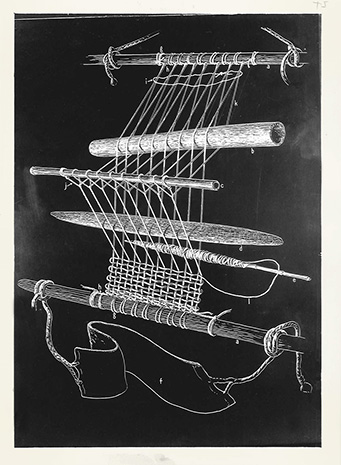
The term can also be used to describe the structure of a text:
"The book weaves together four stories."
Text Weaving
[ Emma, Kamo and Jian ]
How to weave two texts to create new meaning following a pattern?
Text Weaving
Text A: AA AA AA AA
Text B: BB BB BB BB
Patterns:
AB AB AB AB AB AB AB AB AA BB AA BB AA BB AA BB AB BA BA AB AB BA BA AB AB AB AB AB AB AB AB AB AA BB AA BB AA BB AA BB AB BA BA AB AB BA BA AB
Inspiration:
Anni Albers Weaving Patterns
Ideas, thoughts, process:
https://pad.xpub.nl/p/replacing_cats
Ceramics
Transcription Exercise
[ Miriam, Jian ]
Juno: I´m pregnant.
Juno: I'm pregnant.
Mum: Oh Good *quiet*
Mum: Oh god.
Juno: But uh i aaah ieh - I´m gonna give it up for adoption! – Aaan I already found the perfect couple! They pay for the medical expenses an everything, – an an an in whu what 40 odd weeks we can just pretend that this never happened! *nervous, fast*
Silence
Juno: But uh ah I'm gonna give it up for adoption and I already found the perfect couple; they're gonna pay for the medical expenses and everything and and wh- wh- what - 30 odd weeks we can just pretend that this never happened [fast and nervous breathing]
Dad: Your pregnant?
Dad: You're pregnant?
Juno: I´m sorryy. I´m sorry! And if it is any concellation I have heartburn that is radiating my kneecaps – an i haven´t taken a dump since Wednesday – Morning … I
Juno: I'm sorry. I'm sorry and if it is any consolation: I have heart burn that is radiating in my knee caps and I haven't taken a dump since - uh - Wednesday... morning ah!
Mum: I ddn´t even know you were sexually active!?
Mum: I didn't even know you were sexually active!
Juno: I...
Dad: Who is the kid?
Dad: Who is the kid?
Juno: The baby? I don´t really know much about it other than – it has fingernails alledgedly
Juno: T-the baby? I don't really know much about it other than, I mean, it has finger nails, l-l-logically -
Mum: Nails, really?
Mum: Finger nails, really?
Juno: Yeah!
Juno: Yeah!
Dad: no I no I mean – who is the father, Juno?
Dad: No, I don -, I mean, who's the father, Juno?
Juno: Uhm … It´s – it´s Pauli Bleaker. *quiet*
Juno: Uhm... it's Paulie Bleeker?
Dad: Pauli Bleaker? *surprised*
Juno: What? *offended*
Juno: What?
Dad: I ddn´t think he had it in him! *smurking*
Dad: I didn't think he had it in him
Friend: [laughs quietly]
Sister. huhuhu no –right? hehehe *laughing*
Friend: [giggles] I know, right? Hehehe
Dad: Right it´s not a laughing matter.
Dad: Right, this is no laughing matter
Juno: No it´s not! *offended* – You know and Pauli is actually great – in uh –
Juno: No, it's not. And you know, Paulie is actually great in a, in -
Dad: Okay!
Dad: - Okay -
Juno: in share
Juno: In share
Dad: You thinking baout adoption?
Dad: You thinking about adoption?
Juno: Yeah! yeah … an uh … there is this couple … they haven´t had – you know – they´ve been trying to have a kid for five years
Juno: Yeah, yeah. And - uh - there's this couple and they haven't had, you know, they - they've been trying to have a kid for like five years.
Sister: You find them in the pennysaver next to the exotic birds? *saracastic*
Friend: We found them in the penny saver next to the exotic birds.
Juno: And they have – a legitimate lawyer – an i was gonna go meet with them next weekend
Juno: And they have a legitimate lawyer and I was gonna go meet with him next weekend.
Mum: Juno that is a tough tough thing to do it´s probably tougher than n you can understand right now.
Mum: Jun-Bug, that is a tough, tough thing to do. It's probably tougher than you can understand right now.
Juno. I know. pause – An uh it´s just that I´m not ready to be a mum.
Juno: No, I - I know, and I - it's just that I'm not ready to be a mum.
Dad: *outraged sound* Damns good that you be not! You dont even remember Liberty Bella her breathing meds! *outraged*
Dad: [hawks] Damn, skippy, you're not. You don't even remember to give Liberty Beller breathing meds!
Juno: That was ONCE and she did not die if you recall?!
Juno: Uh, that was once and she did not die if you recall.
Mum: Honey … have you considered – you know – the alternative?
Mum: Honey, have you considered, you know, the alternative?
Juno: No
Juno: No.
Mum: Well … You´re a little VIKING!
Mum: Wow. You're a little viking!
Juno: *sighs*
Juno: Ahhh [sighs]
Mum: First things first. Alright, we have to get you healthy. You need prenatal vitamins – incidently they do incredible things for your nails – so, that´s a plus! Oh en we need to schedule a doctor´s appointment figure out where you gonna deliver
Mum: First things first: Alright, we have to get you healthy! You need pre-natal vitamins and [incomprehensible], they do incredible things for your nails, so that's a plus. Oh, and we need to schedule a doctor's appointment [breathes out] to figure out where you're gonna deliver
Dad: D you know I´m coming with you to meet this … adoption … couple … Your just a kid I dont want you ripped of by
Dad: You know, I'm coming with you to meet this - adoption couple. You're just a kid, I don't want you to get ripped off by a couple of baby-starved wing-nuts.
Juno: Thanks, dad.
Dad: But I thought you were the kind of girl who knew when to say when [uncomfortable silence for a few seconds]
Juno: I don't really know what kinda girl I am.
Pimp my Soupboat
After HTML and CSS Workshop with Erica & Kamo
WIP for my Soupboat page
Reload the page for random outcome!
My first use of javascript:
const container = document.getElementById("container");
// console.log(container.children);
let contents = Array.from(container.children);
// console.log(images);
contents.forEach((item) => {
console.log(item);
left = Math.random() * 100;
top = Math.random() * 100;
zIndex = Math.round(Math.random() * 1000);
item.style.left = left + "%";
item.style.top = top + "%";
item.style.zIndex = zIndex;
});
Selection Process / Annotation Compass
[ Kamo, Supi, Kim, Emma, Alex, Jian ]
Ideas, thoughts, process
Link to our pad:
https://pad.xpub.nl/p/sunday
Experiment 1
For this experiment, four of us were gathered in a living-room.
[ ] Number of participants: 4
[ ] Location: Supi's living room
[ ] Aim: Map out each participant's impressions of the living room.
[ ] Material: The living room's floor plan, computers, InDesign
[ ] Time-frame: 5 minutes
[ ] Instructions: individually annotate the floor plan with impressions of the living room
After removing the floor plan and looking at the subjective annotations of this experiment, we observed that each outcome forms another 'space'. Each person's set of annotations brings a unique perspective of the living room , an 'individual map'. We then layered the individual maps and the compilation resulted in a vernacular picture of the space. This alternative understanding of the space can only be given to a reader through those descriptions.
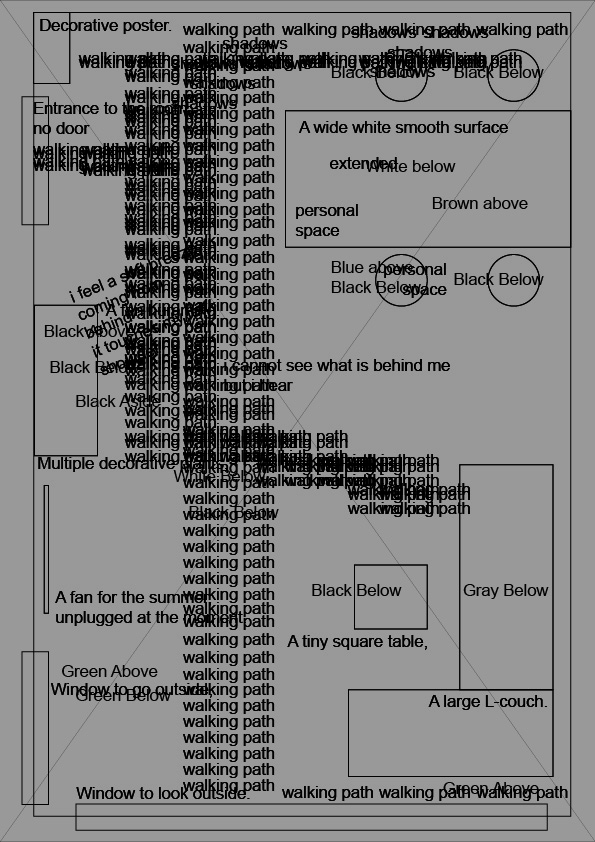
–––––––––––––––––––––––––––––––––––––––––––––––––––––––––––––––––––––––
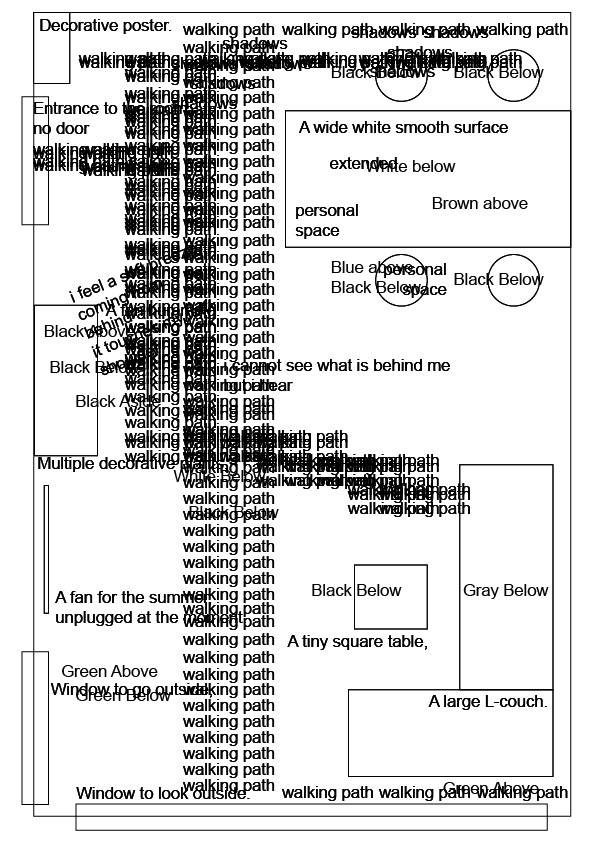
–––––––––––––––––––––––––––––––––––––––––––––––––––––––––––––––––––––––
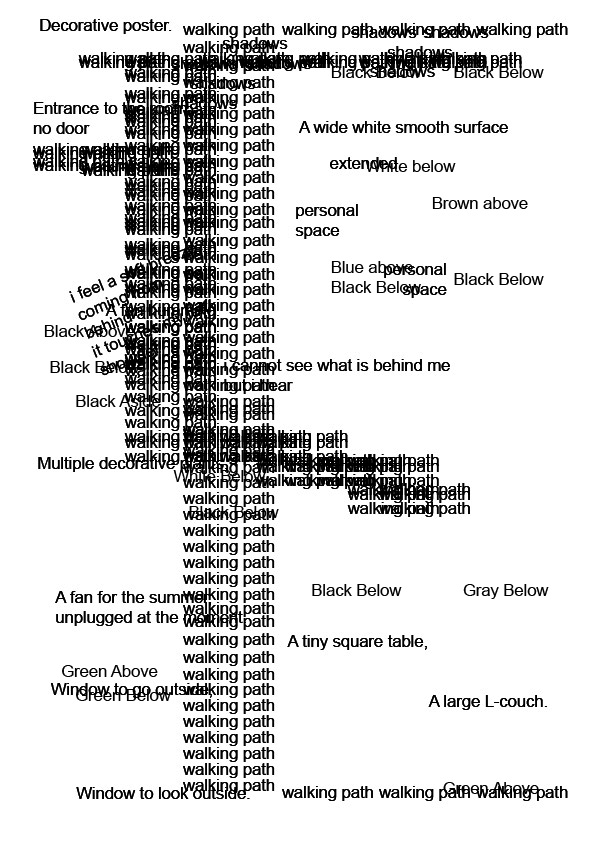
–––––––––––––––––––––––––––––––––––––––––––––––––––––––––––––––––––––––
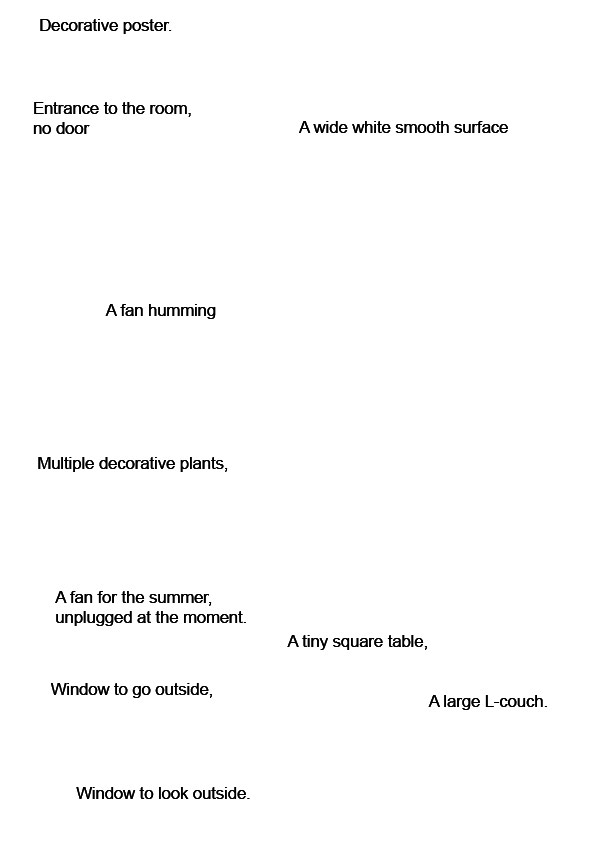
–––––––––––––––––––––––––––––––––––––––––––––––––––––––––––––––––––––––
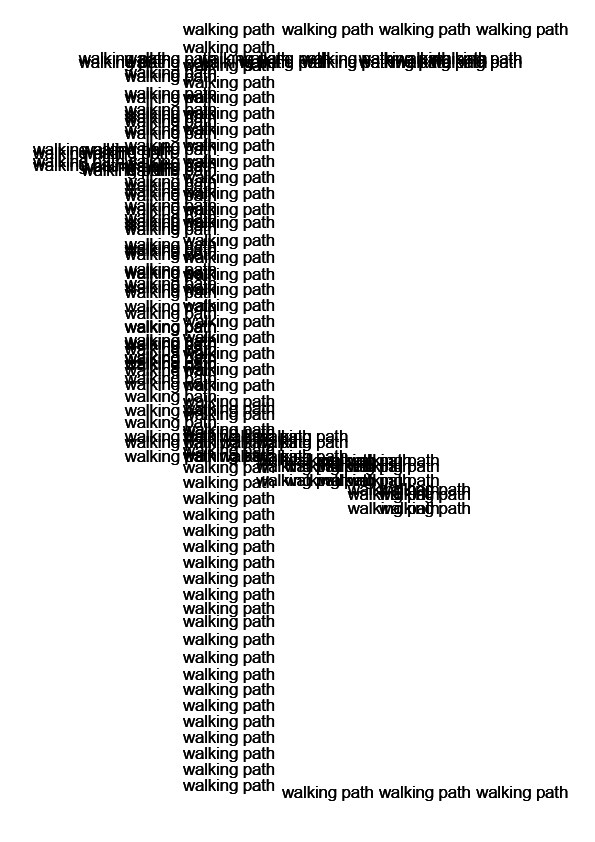
–––––––––––––––––––––––––––––––––––––––––––––––––––––––––––––––––––––––
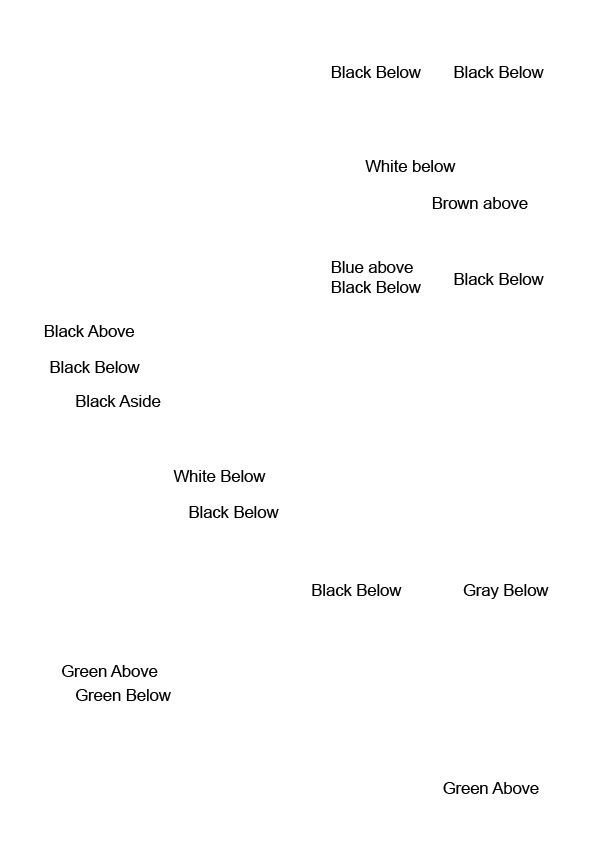
–––––––––––––––––––––––––––––––––––––––––––––––––––––––––––––––––––––––
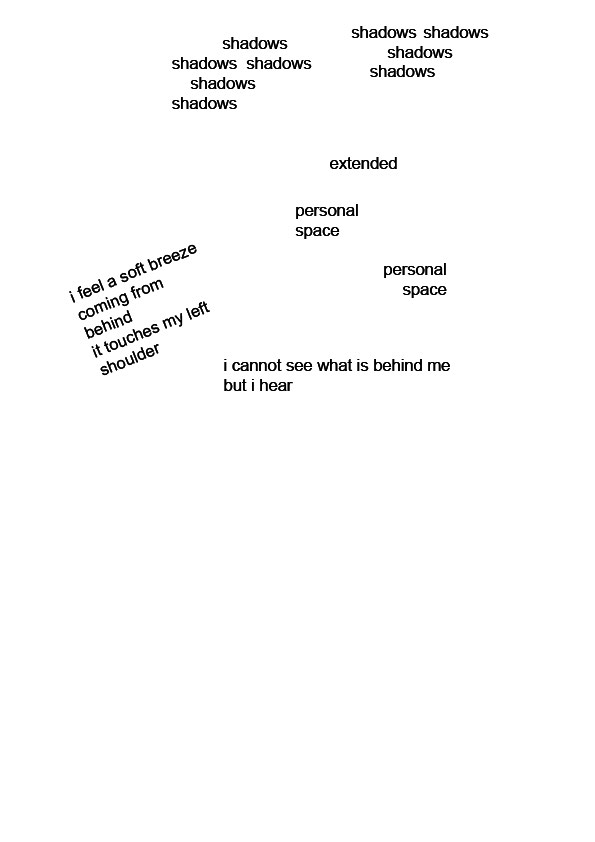
–––––––––––––––––––––––––––––––––––––––––––––––––––––––––––––––––––––––
Experiment 2
For this experiment, four of us were gathered in a room.
[ ] Number of participants: 4
[ ] Location: Supi's living room
[ ] Aim: Map out each participant's impressions of a photograph of an unknown room
[ ] Material: photograph of an unknown room (shown on a display), sticky notes in 4 colours, pens
[ ] Time-frame: 5 minutes
[ ] Instructions: individually annotate the photograph with impressions of the unknown room
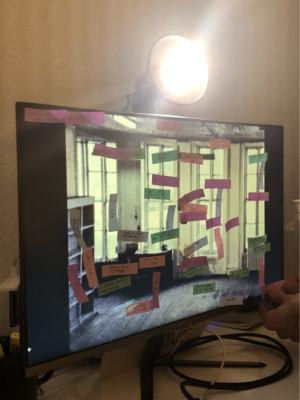
––––––––––––––––––––––––––––––––––––
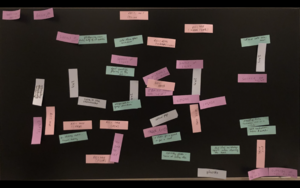
––––––––––––––––––––––––––––––––––––
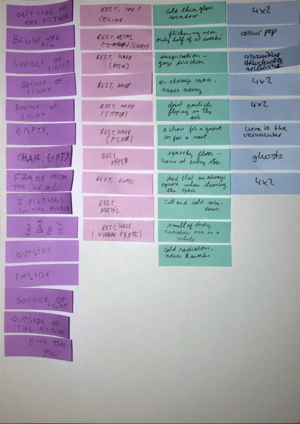
––––––––––––––––––––––––––––––––––––
Each of us used a different set of coloured sticky notes and took 5 minutes to physically annotate the picture on the same surface. The picture was then removed from the background, resulting in a similar outcome as the experiment described above.
From these observations, our interest on subjective annotations that could flow in a common understanding of an image grew. As a tool to collect situated impressions, we elaborated the idea of the Annotation Compass.
On a given surface, such as an image, the tool facilitates the collection of annotations and their coordinates from various users simultaneously. These annotations represent individual knowledges and perspectives in regards to the given surface.
Visual Experiments
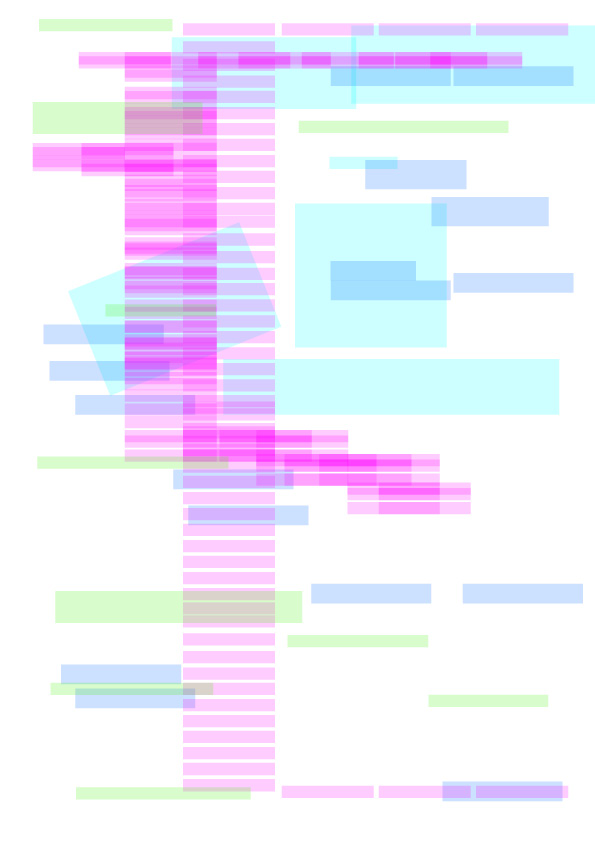
–––––––––––––––––––––––––––––––––––––––––––––––––––––––––––––––––––––––
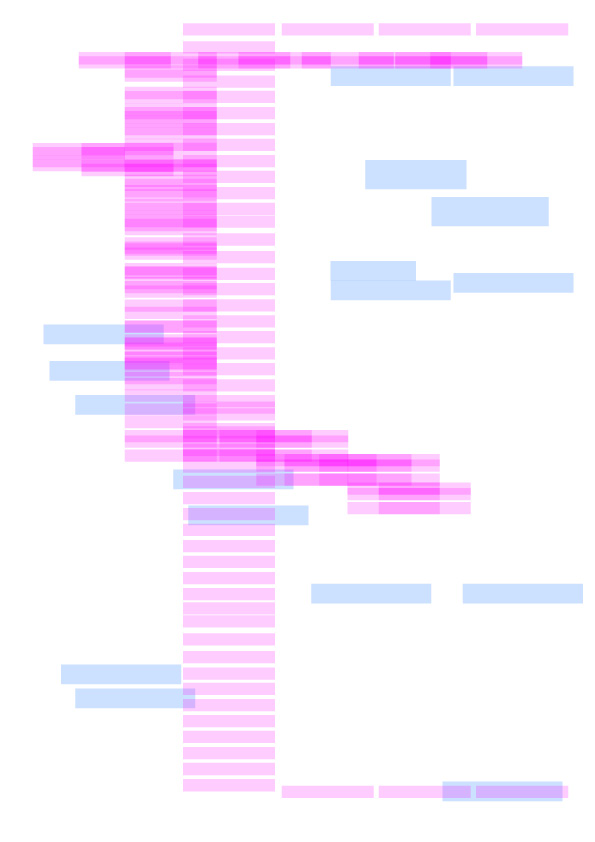
–––––––––––––––––––––––––––––––––––––––––––––––––––––––––––––––––––––––
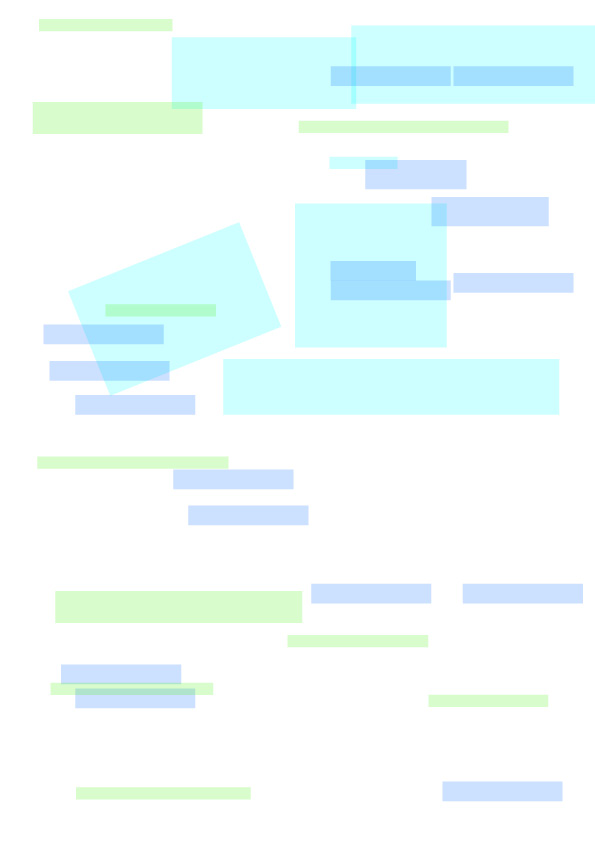
–––––––––––––––––––––––––––––––––––––––––––––––––––––––––––––––––––––––
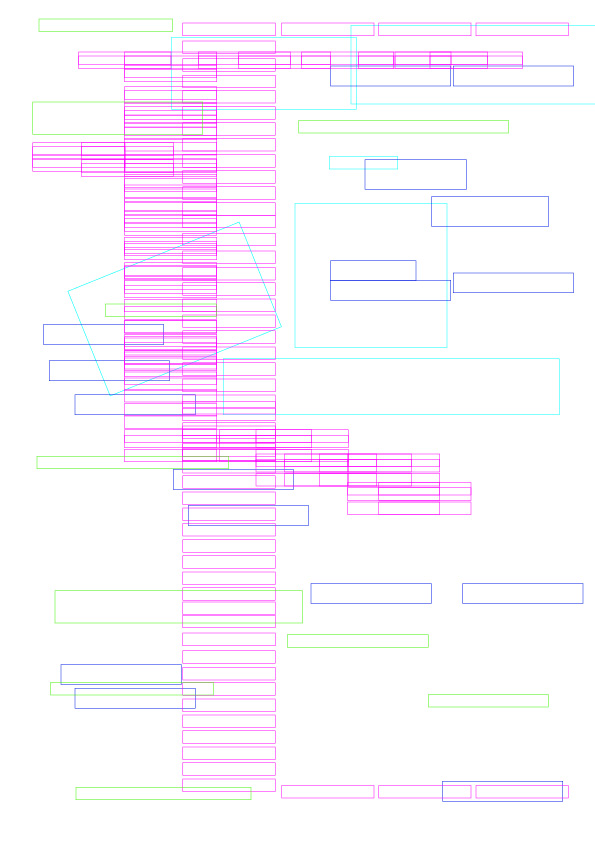
–––––––––––––––––––––––––––––––––––––––––––––––––––––––––––––––––––––––
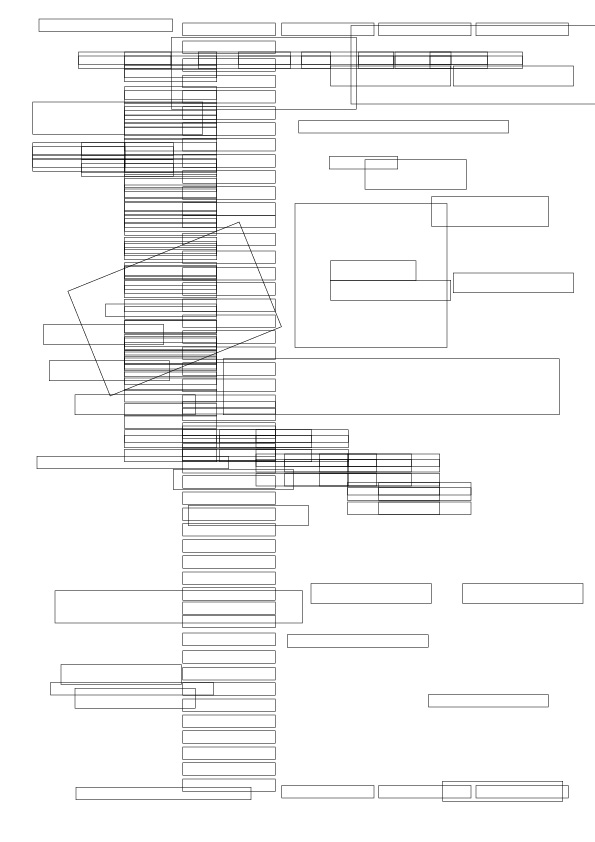
–––––––––––––––––––––––––––––––––––––––––––––––––––––––––––––––––––––––
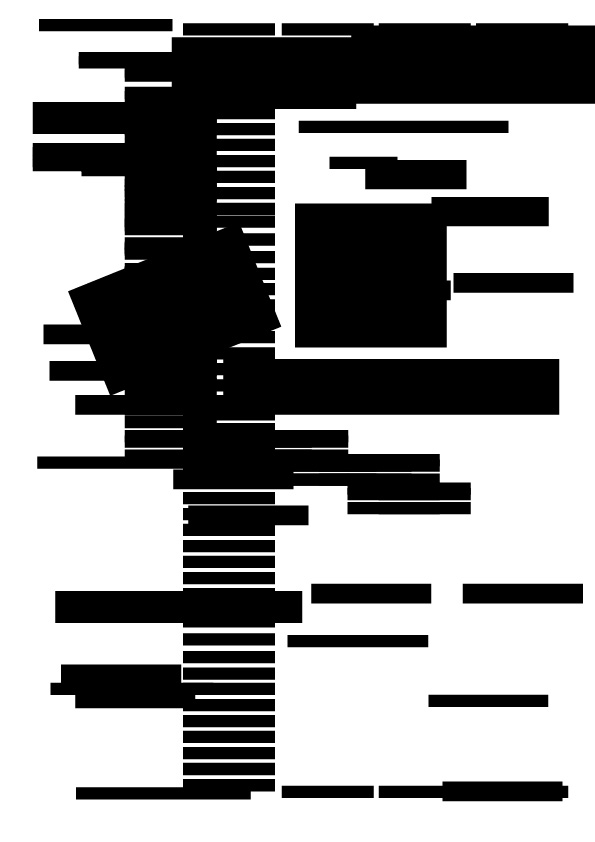
–––––––––––––––––––––––––––––––––––––––––––––––––––––––––––––––––––––––
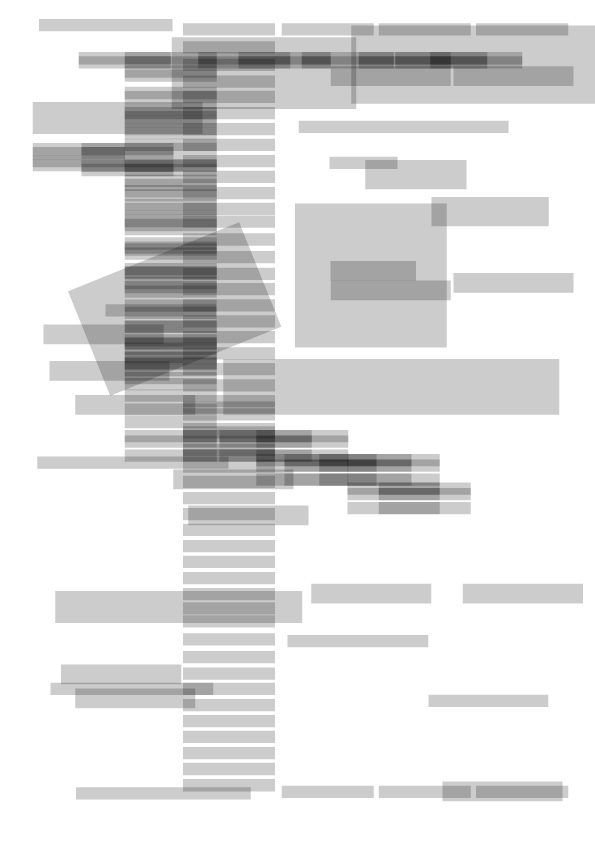
–––––––––––––––––––––––––––––––––––––––––––––––––––––––––––––––––––––––
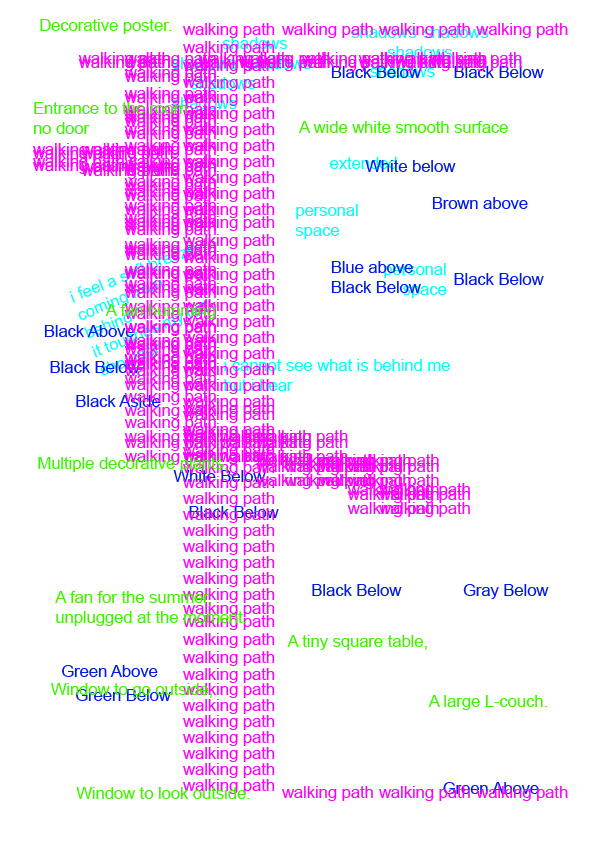
–––––––––––––––––––––––––––––––––––––––––––––––––––––––––––––––––––––––
The Annotation Compass as part of Special Issue #16
In the end we came up with a tool, the "Annotation Compass":
Annotation Compass
The Annotation Compass as part of Special Issue #16
Rejection Map
Rough Notes
[ ] Being together and share space while acknowledging differences
[ ] Share experiences while acknowledging different backgrounds
[ ] embrace multiple ways of knowing and feeling of the world
[ ] Rejection map of Rotterdam
[ ] Ask you to share moments of rejection and
[ ] Second of acceptance
[ ] Where you experienced or witnessed
[ ] Since a lot is happening online you can still locate it
[ ] Try to really situate it (is it a specific house or a whole neighborhood)
[ ] Not only you but witness
[ ] It can be related to housing, relationship, school or job, to you being new in the city, new in traffic, community, language
[ ] It can be only one word describing the situation or your feelings, or a little anecdote
[ ] Use you very own words, nothing is expected from you
[ ] It can be cryptic (eg using slang, your mother tongue, only glyphs not words) if you dont want it to be a secret
[ ] Reflection or memories, but you can also overwrite it with something new, hopes
[ ] Where you rejected a thought
[ ] Create non existing landscapes
Functions
All of the following functions were built for a project where individuals are invited to add their annotations on a map using the Annotation Compass. Each annotation-label is stored in a json-file and includes the annotation-text itself, but also the name of the image-file as well as the position, size, index, timestamp and userID of the annotation.
Example for a label:
{'image': 'map.jpg',
'position': {'x': 12, 'y': 97},
'size': {'width': 43, 'height': 18},
'text': 'This is a text! Is this a text?',
'timestamp': 'Wed, 01 Dec 2021 14:04:00 GMT',
'userID': 5766039063}
individual_maps()
https://hub.xpub.nl/soupboat/si16/functions/html_tag/
If interested in all annotations of one or more specific users, individual_map() can help. The function needs a string with the name of the of the image-file that was annotated with the annotation compass tool as well as one or more specific userIDs to target. The output is a list of all labels from the users of interest.
def individual_map(image: str, users: list ) -> list:
"""give a string with the name of the image-file that was annotated with the Annotation Compass; Select one or more specific users and return a list of all labels from these users."""
from urllib.request import urlopen
import json
url = f"https://hub.xpub.nl/soupboat/si16/annotation-compass/get-labels/{image}/"
response = urlopen(url)
data_json = json.loads(response.read())
filtered_map = []
for label in data_json['labels']:
for user in users:
if label['userID'] == user:
filtered_map.append(label)
return filtered_map
vernacular_map()
https://hub.xpub.nl/soupboat/si16/functions/vernacular_map/
If interested in all annotations vernacular_map() can help. The function needs a string with the name of the of the image-file that was annotated with the annotation compass tool. The output is a string that includes all annotation-texts plus html-tags that place them back into their original position.
def vernacular_map(image: str) -> str:
"""Give a string with the name of the image-file that was annotated with the Annotation Compass; Return a string that includes all annotation-texts plus html-tags that place them back into their original position."""
from urllib.request import urlopen
import json
url = f"https://hub.xpub.nl/soupboat/si16/annotation-compass/get-labels/{image}/"
response = urlopen(url)
data_json = json.loads(response.read())
filtered_map = '<link rel="stylesheet" href="/soupboat/si16/static/css/jian.css">'
for label in data_json['labels']:
html_tag = f'<p style="left: {label["position"]["x"]}%; top: {label["position"]["y"]}%; position: absolute;">{ label["text"] }</p>'
filtered_map = filtered_map + html_tag
return filtered_map
area_map()
https://hub.xpub.nl/soupboat/si16/functions/area_map/
If interested in the annotations in a specific area of the map, area_map() can help. The function needs a string with the name of the of the image-file that was annotated with the annotation compass tool as well as four specific values to define the left, right, top and bottom outlines of the selected area. The output is a list of all labels in the defined area of interest.
def area_map(image: str, left: int, right: int, top: int, bottom: int ) -> list:
"""Give a string with the name of the image-file that was annotated with the Annotation Compass; Select a specific area of the image, return a list of all labels in that specific area."""
from urllib.request import urlopen
import json
url = f"https://hub.xpub.nl/soupboat/si16/annotation-compass/get-labels/{image}/"
response = urlopen(url)
data_json = json.loads(response.read())
filtered_map = []
for label in data_json['labels']:
if left <= (label['position']['x']) <= right and top <= (label['position']['y']) <= bottom:
filtered_map.append(label)
return filtered_map
target_map()
https://hub.xpub.nl/soupboat/si16/functions/target_map/
If interested in all annotations that include one or more specific targets, target_map() can help. The function needs a string with the name of the of the image-file that was annotated with the annotation compass tool as well as one or more specific targets. The output is a list of all labels that include these targets.
def target_map(image: str, targets: list ) -> list:
"""Give a string with the name of the image-file that was annotated with the Annotation Compass; Select one or more specific targets and return a list of all labels that include these targets."""
from urllib.request import urlopen
import json
url = f"https://hub.xpub.nl/soupboat/si16/annotation-compass/get-labels/{image}/"
response = urlopen(url)
data_json = json.loads(response.read())
filter_map = []
for label in data_json['labels']:
for target in targets:
if target in label['text']:
filter_map.append(label)
return filter_map
highlight_map()
https://hub.xpub.nl/soupboat/si16/functions/highlight_map/
If interested in all annotations that include a specific target, highlight_map() can help. The function needs a string with the name of the of the image-file that was annotated with the annotation compass tool and a target-word. The output is a string that includes all annotation-texts plus html-tags that place them back into their original position while highlighting the annotation-texts that include the target.
def highlight_map(image: str, target: str ) -> str:
"""Give a string with the name of the image-file that was annotated with the Annotation Compass; Give a target-word; Return a string that includes all annotation-texts plus html-tags that place them back into their original position while highlighting the annotation-texts that include the target."""
from urllib.request import urlopen
import json
url = f"https://hub.xpub.nl/soupboat/si16/annotation-compass/get-labels/{image}/"
response = urlopen(url)
data_json = json.loads(response.read())
filtered_map = '<link rel="stylesheet" href="/soupboat/si16-app/static/css/jian.css">'
for label in data_json['labels']:
if target in label['text']:
highlight_tag = f'<p class="highlight" style="left: {label["position"]["x"]}%; top: {label["position"]["y"]}%; position: absolute;">{ label["text"] }</p>'
filtered_map = filtered_map + highlight_tag
else:
html_tag = f'<p class="lowlight" style="left: {label["position"]["x"]}%; top: {label["position"]["y"]}%; position: absolute;">{ label["text"] }</p>'
filtered_map = filtered_map + html_tag
return filtered_map
ghost_map()
https://hub.xpub.nl/soupboat/si16/functions/ghost_map/
If interested in the traces the annotations leave, ghost_map() can help. The function needs a string with the name of the of the image-file that was annotated with the annotation compass tool as well as a ghost-glyph that will replace all characters of the annotation-texts. The output is a string that includes all replaced annotation-texts plus html-tags that place them back into their original position.
def ghost_map(image: str, ghost_glyph: str ) -> str:
"""give a string with the name of the image-file that was annotated with the Annotation Compass; Replace all characters of all annotation-texts with a ghost-glyph and return a string that includes all replaced annotation-texts plus html-tags that place them back into their original position."""
from urllib.request import urlopen
import json
url = f"https://hub.xpub.nl/soupboat/si16/annotation-compass/get-labels/{image}/"
response = urlopen(url)
data_json = json.loads(response.read())
filtered_map = '<link rel="stylesheet" href="/soupboat/si16/static/css/jian.css">'
for label in data_json['labels']:
replaced_text = ''
for char in label['text']:
replaced_char = char
if not char.isspace():
replaced_char = ghost_glyph
replaced_text = replaced_text + replaced_char
html_tag = f'<p class="lowlight" style="left: {label["position"]["x"]}%; top: {label["position"]["y"]}%; position: absolute;">{ replaced_text }</p>'
filtered_map = filtered_map + html_tag
return filtered_map
html_tag()
https://hub.xpub.nl/soupboat/si16/functions/html_tag/
The following functions need to be combined with the HTML-tag-function to generate visual outcome:
[ ] individual_map()
[ ] area_map()
[ ] target_map()
If interested in the position, text, timestamp and/or userID of all annotations, html_tag() can help. The function needs a string with the name of the of the image-file that was annotated with the annotation compass tool as well as four Boolean Values that define which information is of interest. The output is a string that can include the position, text, timestamp and/or userID of all labels plus html-tags that place them back into their original position.
def html_tag(image: str, position: bool, text: bool, timestamp: bool, userID: bool ) -> str:
"""Give a string with the name of the image-file that was annotated with the Annotation Compass; Return a string that can include the position, text, timestamp and/or userID of all labels plus html-tags that place them back into their original position."""
from urllib.request import urlopen
import json
url = f"https://hub.xpub.nl/soupboat/si16/annotation-compass/get-labels/{image}/"
response = urlopen(url)
data_json = json.loads(response.read())
html_tags = '<link rel="stylesheet" href="/soupboat/si16/static/css/jian.css">'
for label in data_json['labels']:
html_tags = html_tags + f'<p style="left: {label["position"]["x"]}%; top: {label["position"]["y"]}%; position: absolute;">'
if position == True:
html_position = f'{ label["position"] } '
html_tags = html_tags + html_position
if text == True:
html_text = f'{ label["text"] } '
html_tags = html_tags + html_text
if timestamp == True:
html_timestamp = f'{ label["timestamp"] } '
html_tags = html_tags + html_timestamp
if userID == True:
html_userID = f'{ label["userID"] } '
html_tags = html_tags + html_userID
html_tags = html_tags + '</p>'
return html_tags
How the functions are used for the Rejection Map:
https://hub.xpub.nl/soupboat/si16/projects/annotation-compass/rejection_map/
Visual Experiments
Rejection Map of Rotterdam as part of the Special Issue #16
Rejection Map of Rotterdam as part of the Special Issue #16
What the book is
Investigate the holonym-meronym relations for the book
NLTK wordnet: There are three kinds of holonym-meronym relations:
[ ] member_meronyms()
[ ] part_meronyms()
[ ] substance_meronyms()
[ ] member_holonyms()
[ ] part_holonyms()
[ ] and substance_holonyms()
from nltk.corpus import wordnet as wn
wn.synsets('book')
[Synset('book.n.01'),
Synset('book.n.02'),
Synset('record.n.05'),
Synset('script.n.01'),
Synset('ledger.n.01'),
Synset('book.n.06'),
Synset('book.n.07'),
Synset('koran.n.01'),
Synset('bible.n.01'),
Synset('book.n.10'),
Synset('book.n.11'),
Synset('book.v.01'),
Synset('reserve.v.04'),
Synset('book.v.03'),
Synset('book.v.04')]
wn.synset('book.n.02').lemma_names()
['book', 'volume']
wn.synset('book.n.02').definition()
'physical objects consisting of a number of pages bound together'
sorted(lemma.name() for synset in types_of_book for lemma in synset.lemmas())
['album',
'coffee-table_book',
'folio',
'hardback',
'hardcover',
'journal',
'notebook',
'novel',
'order_book',
'paper-back_book',
'paperback',
'paperback_book',
'picture_book',
'sketch_block',
'sketch_pad',
'sketchbook',
'soft-cover',
'soft-cover_book',
'softback',
'softback_book']
[synset.name() for synset in paths[0]]
['entity.n.01',
'physical_entity.n.01',
'object.n.01',
'whole.n.02',
'artifact.n.01',
'creation.n.02',
'product.n.02',
'book.n.02']
wn.synset('book.n.02').part_meronyms()
[Synset('binding.n.05'), Synset('fore_edge.n.01'), Synset('spine.n.04')]
for synset in wn.synsets('book', wn.NOUN):<br>
print(synset.name() + ':', synset.definition())
book.n.01: a written work or composition that has been published (printed on pages bound together)
book.n.02: physical objects consisting of a number of pages bound together
record.n.05: a compilation of the known facts regarding something or someone
script.n.01: a written version of a play or other dramatic composition; used in preparing for a performance
ledger.n.01: a record in which commercial accounts are recorded
book.n.06: a collection of playing cards satisfying the rules of a card game
book.n.07: a collection of rules or prescribed standards on the basis of which decisions are made
koran.n.01: the sacred writings of Islam revealed by God to the prophet Muhammad during his life at Mecca and Medina
bible.n.01: the sacred writings of the Christian religions
book.n.10: a major division of a long written composition
book.n.11: a number of sheets (ticket or stamps etc.) bound together on one edge
Coding the book generator
with open('/dev/usb/lp0', 'w') as lp:
import datetime
now = datetime.datetime.now()
#print ("Current date and time : ")
print('////////////////////////////////', file = lp)
print('////////////////////////////////', file = lp)
print('////////////////////////////////', file = lp)
print('', file = lp)
print (now.strftime("%Y-%m-%d %H:%M:%S"), file = lp)
print('', file = lp)
print('////////////////////////////////', file = lp)
from random import choice
thing = ["A BOOK"]
item = ["AN OBJECT", "AN ARTIFACT", "A KNOT", "A COLLECTION", "AN ARCHIVE", "A PORTABLE DATA STORAGE",
"THE PHYSICAL SUPPORT OF TEXT", "AN INTIMATE SPACE", "AN IDEA", "A PERFROMANCE", "AN EVENT", "A PHENOMENON OF SPACE AND TIME",
"A SEQUENCE OF ROOMS", "A SEQUENCE OF MOMENTS", "AN INTERFACE", "A DEVICE", "AN ITEM", "AN EXHIBITION", "A STAGE", "A FRAMEWORK", "AN ENTITY"]
structure = ["A SYSTEM OF KNOTTED STRINGS", "LAYERS", "NODES AND LINKS", "INTERCONNECTIONS","A VARIETY OF MATERIALS",
"JUXTAPOSITIONS", "A RECOMBINANT STRUCTURE", "THE POWER OF PUBLICATION", "ANY NUMBERS OF PHYSICAL FORMS", "WORDS",
"WHITE SPACE AND BLACK SPACE"]
action = ["TO PROVIDE", "TO SHOW", "TO PUBLISH", "TO CONSERVE", "TO PRESENT", "TO EXCHANGE", "TO FIND", "TO CREATE", "TO PRODUCE", "TO EXPERIENCE", "TO OFFER",
"TO TRANSFER", "TO DELINEATE", "TO PROCESS"]
attribute = ["RANDOM", "SEQUENTIAL", "ISOLATED", "CERTAIN", "PRECISE", "NAVIGATIONAL", "CONTEXTUAL", "SPECIFIC", "PERFORMATIVE", "SITUATED", "SUBJECTIVE",
"OBJECTIVE", "USEFUL", "UNIVERSAL", "DIVERSE", "EXCITING", "COMPLEX", "ABSTRACT", "DISTINCT", "NEW"]
purpose = ["ACCESS", "KNOWLEDGE", "EXPERIENCE", "EXPECTATION", "ORIENTATION", "THOUGHTS", "NAVIGATION", "DISCURSE", "INFORMATION", "MEANING", "PURPOSE", "COMMUNICATION", "INTERACTION", "NEGOTIATION", "INCARNATIONS", "TRUTH"]
print('', file = lp)
print('', file = lp)
print('A BOOK', file = lp)
print('', file = lp)
print('IS ' + choice(item), file = lp)
print('', file = lp)
print(' USING ' + choice(structure), file = lp)
print('', file = lp)
print(' ' + choice(action), file = lp)
print('', file = lp)
print(' ' + choice(attribute), file = lp)
print('', file = lp)
print('' + choice(purpose), file = lp)
print('', file = lp)
print('', file = lp)
print('', file = lp)
2022-02-05 16:26:08
A BOOK
IS A PORTABLE DATA STORAGE
USING WORDS
TO PROVIDE
COMPLEX
EXPECTATION
2022-02-05 16:26:56
A BOOK
IS AN ARCHIVE
USING THE POWER OF PUBLICATION
TO PROCESS
SEQUENTIAL
DISCURSE
2022-02-05 16:27:05
A BOOK
IS A DEVICE
USING LAYERS
TO FIND
COMPLEX
ACCESS
2022-02-05 16:27:14
A BOOK
IS AN OBJECT
USING WHITE SPACE AND BLACK SPACE
TO PRODUCE
COMPLEX
KNOWLEDGE
2022-02-05 16:27:22
A BOOK
IS A PORTABLE DATA STORAGE
USING JUXTAPOSITIONS
TO FIND
OBJECTIVE
TRUTH
Visual Experiments
Cocktail Generator
Coding the Cocktail Generator
Randomly chooses ingredients from a menu for a nice cocktail recipe:
def cocktail_generator(alcohol: list, decor: list) -> str:
"""randomly chooses ingredients from a menu for a nice cocktail recipe"""
import datetime
from datetime import timedelta
now = datetime.datetime.now() + timedelta(hours=1)
from random import choice
base = ["ORANGE JUICE", "PINEAPPLE JUICE", "APPLE JUICE", "MANGO JUICE", "FRIZZY WATER", "GRAPEFRUIT JUICE", "TONIC WATER"]
sour = ["LEMON JUICE", "LIME JUICE", "PASSION FRUIT"]
sweet = ["AGAVE SIRUP", "SUGAR SIRUP", "MAPLE SIRUP"]
omph = ["1 SLICE GINGER", "2 LEAVES MINT", "1 SLICE CUCUMBER", "1 STICK CINNAMON", " SALT RIM"]
snack = ["CHIPS", "SALTED CORN", "PRETZELS", "SALTED NUTS"]
XPUB1 = [" (*(*(*(*(*.(*.*).*)*)*)*)*)*)", " (^(^(^(^(^.(^.^).^)^)^)^)^)^)"]
drink = ["""
___,
'._.'\
_____/'-.\
| / |
|~-~/-~|
\ () /
'.__.'
||
_||_
`----` """, """
.
. .
|^ .
\O___.____ /
\ . /
\ ,/
[]
[]
[]
--------
""", """
\
.-\""""""""-.
\ \__ o . /
\/ \ o/
\__/. /
\_ _/
Y
|
_.-' '-._
`---------` """]
recipe = f"""
<pre>
*=*=*=*=*=*=*=*=*=*=*=*=*=*=*=*
*=*=*=*=*=*=*=*=*=*=*=*=*=*=*=*
* *
* CATWALKING WITH ALCOHOL *
* *
* {now.strftime("%Y-%m-%d %H:%M:%S")} *
* *
*=*=*=*=*=*=*=*=*=*=*=*=*=*=*=*
*=*=*=*=*=*=*=*=*=*=*=*=*=*=*=*
2 oz {choice(alcohol)}
150 ml {choice(base)}
1 oz {choice(sour)}
0.5 oz {choice(sweet)}
{choice(omph)}
1 {choice(decor)}
*=*=*=*=*=*=*=*=*=*=*=*=*=*=*=*
EXTRA: {choice(snack)}
*=*=*=*=*=*=*=*=*=*=*=*=*=*=*=*
___,
'._.'\
_____/'-.\
| / |
|~-~/-~|
\ () /
'.__.'
||
_||_
`----`
THANKS FOR COMING TO OUR LAUNCH!
{choice(XPUB1)}
*=*=*=*=*=*=*=*=*=*=*=*=*=*=*=*
*=*=*=*=*=*=*=*=*=*=*=*=*=*=*=*
</pre>
"""
return recipe
This function generates amazing cocktail recipes for you to try! The cocktail menu includes the categories alcohol, base, sour, sweet and omph. There is also a category for a decorative gadget and one for an extra snack. Each category has a default list of ingredients and the function randomly chooses one ingredient per category. You prefer Rum and Tequila over Vodka? Or maybe you want a non-alcoholic cocktail? Don´t worry! For the categories alcohol and decor you can insert your own ingredients to pick from. Enjoy!
Menu: default ingredients: base = ORANGE JUICE, PINEAPPLE JUICE, APPLE JUICE, MANGO JUICE, FRIZZY WATER, GRAPEFRUIT JUICE, TONIC WATER sour = LEMON JUICE, LIME JUICE, PASSION FRUIT sweet = AGAVE SIRUP, SUGAR SIRUP, MAPLE SIRUP omph = 1 SLICE GINGER, 2 LEAVES MINT, 1 SLICE CUCUMBER, 1 STICK CINNAMON, SALT RIM snack = CHIPS, SALTED CORN, PRETZELS, SALTED NUTS users ingredients: alcohol = decor =
In this exmaple the function chooses between three alcoholic ingredients and two decoratin gadgets
print(cocktail_generator(['VODKA', 'TEQUILA', 'RUM'], ['UMBRELLA', 'PALMTREE', 'FLAMINGO']))
*=*=*=*=*=*=*=*=*=*=*=*=*=*=*=*
*=*=*=*=*=*=*=*=*=*=*=*=*=*=*=*
* *
* CATWALKING WITH ALCOHOL *
* *
* 2021-12-14 14:08:04 *
* *
*=*=*=*=*=*=*=*=*=*=*=*=*=*=*=*
*=*=*=*=*=*=*=*=*=*=*=*=*=*=*=*
2 oz VODKA
150 ml GRAPEFRUIT JUICE
1 oz LEMON JUICE
0.5 oz SUGAR SIRUP
1 SLICE CUCUMBER
1 UMBRELLA
*=*=*=*=*=*=*=*=*=*=*=*=*=*=*=*
EXTRA: SALTED CORN
*=*=*=*=*=*=*=*=*=*=*=*=*=*=*=*
___,
'._.'\
_____/'-.\
| / |
|~-~/-~|
\ () /
'.__.'
||
_||_
`----`
THANKS FOR COMING TO OUR LAUNCH!
(^(^(^(^(^.(^.^).^)^)^)^)^)^)
*=*=*=*=*=*=*=*=*=*=*=*=*=*=*=*
*=*=*=*=*=*=*=*=*=*=*=*=*=*=*=*
How to change file on Raspberry Pi
To communicate and change .py-file on raspberry pi:
1. Connect both the raspberry pi and the computer to internet via ethernet (or: connect pi and compuetr to the same network) 2. Open terminal, type: ssh pi@raspberrypi.local (or, if the pi and computer are connected to the same network: ssh pi@ip-address-of-the-pi) 3. Give default password: raspberry 4. List files: ls (Should list only one python file: final.py) 5. To access the file via GNU nano: sudo nano final.py
Change code directly on the Pi (small changes) [ ] change code [ ] confirm with: control + O "Write out" [ ] enter to confirm and control X to go back to terminal
Or change code in python file on your computer (bigger changes) delete the content of the final.py file on the Pi and then copy paste the whole code from the file on your computer: [ ] To copy a file: cp original-file-name.py copied-file-name.py [ ] Removes content of the file: sudo rm final.py [ ] List files: ls (Should list only one python file: final.py) [ ] To access the empty file via GNU nano: sudo nano final.py [ ] paste the new code [ ] to delete a line: control + k [ ] confirm with: control + O "Write out" [ ] enter to confirm and control X to go back to terminal
After the changes of the file, reboot raspberry pi: sudo reboot The code should now run without using the terminal (find out why?). [ ] To run the code via the terminal: python3 final.py [ ] To stop the code via the terminal: control + c [ ] To exit the ssh without rebooting the pi: exit
Trying to setup a new Button
Message to Chae:
Lets try a very simple and easy setup that uses the new button, only without its LED light (the LED needs 12V and extra power source, so its too complicated)
1. Take photo of current setup (so that you can always go back to it!) 2. Look at the switch that comes with the new button, it should look like this (Fig. 1) 3. Leave the cable on the pins of the raspberry pi! 4. On each pin you have a female cable + a male cable that connect to the breadboard 5. Pull both males out of the breadboard 6. These two are now connected to the switch following this scheme (Fig. 2 + 3) 7. You can connect them with tape for now to test if it works! 8. The switch now has to be put into the button –it should slide in or something like that and sits behind the LED that we do not use (Fig. 4) 9. Test if it works! If yes, HURRRRAAY! If no, forget about our brillant new button, we will make it work in January and use it at the next event!
The Cocktail Generator as part of Special Issue #16
Reflection Diary
What did you like about the process of creating the Special issue 16?
[ ] getting to know all of you
[ ] the high energy level and dynamic in the group
[ ] the excitement of diving into something completely new (especially with coding and collective working)
[ ] coding
[ ] collective working
What would you like to keep in the process for the next special issue?
[ ] the high energy level and dynamic in the group
[ ] being curious and adventurous
What did you not like about the whole journey?
[ ] serious moments of frustration – sorry to everyone!
[ ] that the technical part of the special issue 16 couldnt be equally distributed (because we aimed too high?)
[ ] that we got carried away in the project-subgroups and lost the view for the whole picture
What would you like to do differently for Special Issue 17? Feel free to elaborate in more specifics.
when we started to work on the special issue 16 i thought there could be two ways to approach it:
- work on ONE in-depth project with the whole group
- work on small individual projects or experiments and bring them together in the special issue
i think we ended up doing something inbetween: three projects that are too small on their own and too big and complex to bring them together as the special issue 16. i mean – it works, but its quite messy, not consistent and doesnt carry a clear message. i feel a bit sad about it and would love to try option 1 or 2 next time! it would also mean to take responsibility for the content and the audience!
there is a whole collection:
[ ] meeting the class (most of them) at the central station for the firt time <3
[ ] the day i coded the book generator, it was the first time i realised that coding can be useful and connected to my research
[ ] the workshop series at Roodkapje – first time being introduced to an Arduino
[ ] THE LONG DAY WITH CHRISTINA, it was a milestone
[ ] the day Michael and Manetta introduced the flask application, i was super excited and frustrated at the same time
[ ] many coding moments with kamo – thanks!!!
[ ] everyones support when i needed to leave Rotterdam in the last week of the project – it wasnt easy to go and all your messages were amazing and helped me a lot!
What was the most challenging thing while working in the big group; and in the sub-groups?
[ ] to be on the same page (this refers to decision-making but also communication in general)
[ ] i think that we got carried away in the project-subgroups
What did you learn during the Prototyping classes (Michael & Manetta)? What will you keep from them?
EVERYTHING!!!!!
What did you learn during the Special issue classes (Cristina & Steve)? What will you keep from them?
[ ] how to annotate as a group
[ ] how to have check-in moments
[ ] methods for collective decision-making
How would you describe your overall experience of doing this special issue?
on the surface: AMAZING
below that: mixed feelings of "maybe we could or should have done it differently?"
How will you use what you have learned this trimester in your personal practice?
[ ] i will continue my coding journey and try to find more overlaps with my graphic-design and book-design practice
[ ] i will experiment with my arduino and the raspberry pi i got for christmas!
<3
Special Issue #17
Getting Started
[ … ]
Readings
[ ] "Rules of Play - Game Design Fundamentals", Katie Salen and Eric Zimmerman
[ ] "Taylorism 2.0: Gamification, scientific management and the capitalist appropriation of play", Jennifer Dewinter, Carly A. Kocurek and Randall Nichols
[ ] "Gamification as twenty-first-century ideology", Mathias Fuchs
[ ] "Selfwork", Karen Gregory, Kirsty Hendry, Jake Watts and Dave Young
[ ] "Well Played", Vicky Osterweil
[ ] "The Ruling Class and the Ruling Ideas", Karl Marx & Friedrich Engels
[ ] "History of the Subaltern Classes" from "Selections from the Prison Notebooks", Antonio Gramsci
[ ] "Subculture: The Meaning of Style", Dick Hebdige
[ ] "The Culture Industry: Enlightenment as Mass Deception" from "Dialectic of Enlightenment", Theodor Adorno and Max Horkheimer
[ ] "Base and Superstructure in Marxist Cultural Theory", Raymond Williams
[ ] "Notes on Deconstructing 'The Popular'", Stuart Hall
[ ] "Encoding, Decoding", Stuart Hall
[ ] "Digital play: the interaction of technology, culture, and marketing", Stephen Kline, Nick Dyer-Witheford, Greig de Peuter
[ ] "We Are All Very Anxious", Institute for Precarious Consciousness
[ ] "Game Modding: Cross-Over Mutation and Unwelcome Gifts" from "The Player’s Power to Change the Game", Anne-Marie Schleiner
[ ] "The Legends of Zelda: Fan Challenges to Dominant Video Game Narratives", Kathryn Hemmann in Woke Gaming (ed. Kishonna Gray and David Leonard)
[ ] "The Modern Age" in Edge Magazine #126 "The mod scene: What happens when gamers build games?"
[ ] "Woke Gaming. Digital Challenges to Oppression and Social Injustice", Edited by Kishonna L. Gray and David J. Leonard
[ ] "Chapter 2: PWNing Leisure" from "Play Like a Feminist", Shira Chess
Last update: 2022/02/14
References
[ ] "Roblox Pressured Us to Delete Our Video. So We Dug Deeper"
[ ] Chad McCail robots run zombies for wealthy parasites
[ ] https://www.notion.so/about
[ ] How to organise your academic life: Notion for Students
[ ] Conrad: Make Your To-Do List Fun | How We Use Notion
[ ] https://www.youtube.com/watch?v=i8Mu2aLxsrU
[ ] "The Addictive Cost Of Predatory Videogame Monetization (The Jimquisition)"
[ ] "Super Mario Bros. 3: Pick a box; its contents will deceive you?"
[ ] https://www.platformbk.nl/en/
[ ] https://www.metropolism.com/nl/features/45443_shifting_the_definition_of_professional_competence_post_precarity_zine_toolbox_for_beginning_artists
[ ] https://networkcultures.org/
[ ] Wikipedia Lootbox
[ ] Penny Rafferty OSMK Social Club Lecture
[ ] Radical Friends online summit
[ ] Forensic Architecture
[ ] Pippin Barr: One sentence game ideas
[ ] Day in the Life of a Typical Japanese Office Worker in Tokyo
[ ] Cultural Workers Unite
[ ] Game Workers Unite
[ ] Birgit bachler: Albert Heijn
[ ] World of Text: Tool
[ ] Twine: Tool for telling interactive, nonlinear stories
[ ] How Technology is Hijacking Your Mind
[ ] I cant believe its not gambling – Lootbox
[ ] Bitsy Game Editor
[ ] Bitsy Tutorial
[ ] How to Ludobox
[ ] Ludobox
[ ] Bibliotecha
[ ] Pirate Box
[ ] Tiny Tools Collection
[ ] Everest Pipkin
[ ] Everest Pipkin Junk Nest City
[ ] Unicode Computing Symbols
[ ] The Situationist Times
[ ] PNF Page Not Found
[ ] Paolo Pedercini Molleindustria
[ ] Paolo Pedercini Molleindustria
[ ] Paolo Pedercini Likelike
[ ] Paolo Pedercini Likelike
[ ] Paolo Pedercini Likelike
[ ] Paolo Pedercini Phonestory
[ ] Paolo Pedercini Democratic Socialism Simulator
[ ] Paolo Pedercini Courses
[ ] Paolo Pedercini Protest Games
[ ] Paolo Pedercini parliamentary procedures used by a wide range of democratic organizations
[ ] Paolo Pedercini Game Definitions
[ ] Paolo Pedercini Game Design
[ ] Paolo Pedercini Remote Play
[ ] OSP Open Source Publishing
[ ] OSP Open Source Publishing
[ ] OSP Open Source Publishing
[ ] OSP Open Source Publishing
[ ] OSP Open Source Publishing Etheroff
[ ] Hackers & Designers Chattypub
[ ] Flirting on School
[ ] Fanfiction Archive
[ ] Tutorial Maze code in python
[ ] Steves WIKI, uphill / downhill
Last updtae: 2022/02/16
Pads
| Category | YYYY/MM/DD | Title | Description | Links |
|---|---|---|---|---|
| Special Issue | 2022/01/18 | Main Pad | One Sentence Gaming Ideas | Link |
| Prototyping | 2022/02/07 | Main Pad | Puzzles, mazes | Link |
| Reading + Writing | 2022/02/02 | Main Pad | Working on the Glossary | Link |
| Jian | 2022/01/24 | Individual Pad | Exploring Rotterdam with Alex & Co | Link |
| Special Issue | 2022/02/08 | Main Pad | Modding culture & fan fiction | Link |
| Special Issue | 2022/02/08 | Sub Pad | Sub Group on Modding with Alex + Miriam | Link |
| Special Issue | 2022/02/08 | Sub Pad | Sub Group on Fanfiction with Alex + Miriam | Link |
| Prototyping | 2022/02/14 | Main Pad | Collaboration Tool, Git | Link |
| Reading + Writing | 2022/01/19 | Main Pad | development of the idea of ideology | Link |
| Jian | 2022/01/22 | Individual Pad | Personal Notes on Marx and Hebdidge | Link |
| Jian | 2022/01/18 | Individual Pad | Personal Notes on Taylorism | Link |
| Special Issue | 2022/01/18 | Main Pad | Gamification, Selfwork | Link |
| Jian | 2022/01/23 | Inividual Pad | Personal Notes on "Well played" | Link |
| Special Issue | 2022/01/25 | Main Pad | Well played, Monetization, from player to payer | Link |
| Special Issue | 2022/01/25 | Sub Pad | SuperPAP, popuar, Stuart Hall | Link |
| Special Issue | 2022/02/01 | Main Pad | Feedback Sessions | Link |
| Special Issue | 2022/02/09 | Main Pad | Lecture Paolo Pedercini | Link |
| Special Issue | 2022/02/09 | Sub Pad | Questions for Paolo Pedercini with Kamo and Mitsa | Link |
| Group Meeting | 2022/02/08 | Main Pad | Experimental Kitchen Role Play | Link |
| Reading + Writing | 2022/02/16 | Main Pad | Characteristics of the lootbox and how to subvert it | Link |
| Special Issue | 2022/02/15 | Main Pad | History of the lootbox | Link |
| Group Meeting | 2022/02/12 | Main Pad | Proposal Calendar | Link |
Words of interest
[ ] Fanfiction
[ ] Game
[ ] Gambling
[ ] Gamification
[ ] Gaming
[ ] Ideology
[ ] Leisure
[ ] Lootbox
[ ] Modding
[ ] Payment
[ ] Play
[ ] Popular
[ ] Productivity
[ ] Selfwork
[ ] Surprise
Notes
One Sentence Lootboxes
[ ] A lootbox that has only meaningless items in it and you have to give them meaning
[ ] A lootbox that you get for free
[ ] A lootbox that has no surprise content
[ ] A lootbox that always has the same content
[ ] A lootbox that gives you access to a game (eg a key to open a door)
[ ] A loot box that can only be opened if you solve a rubik's cube. there's nothing inside.
My Definition of a Lootbox
The lootbox is a digital or physical box that contains random (or unknown) items. The box is embedded in a context (for example in the fictional world of a game).
There are two main characteristics:
[ ] Payment
[ ] Surprise
The main characteristics or mechanisms of the lootbox are the payment and the surprise. You don´t get it for free, and you dont know what you get. The combination of payment and surprise can have the following effects: gambling, addiction, pleisure, thrill, excitement, reward, disappointment, risk, ritual, exclusivity, time pressure, social pressure, desire, destiny, exploitation, FOMO etc.
Lootbox Proposal
motto for us: simplify, experiment, have fun, use what we have
A Big Pile of Shiny Plastic Boxes at Page Not Found
Imagine a big pile of shiny plastic boxes located in the art book store Page Not Found. Each box has a different appealing color and you can choose your favorite – wow, exciting! – is there a discount code? You don´t know what you get, the only hints are stickers on the box with reviews from previous buyers like "These items changed my life!" or "10/10 recommend" and on a screen next to the pile you can even find a short unboxing-video on Youtube. You pay for your box, then carefully open it and inside you find 6-12 items, for example a small riso-printed booklet with the "Katamarri-Fannifiction", a 3D-printed USB-Stick with the Bitsy game "From Player to Payer", the card game "Miriam the Leader" and a QR-code that links to the karaoke song "Gaming can make a Better World". There is also a discount-sticker in the box, so why not stick it to another box to give the next buyer a discount?
(6-12 items depending if we work on them in pairs or as individuals)
↑ This was a downhill invention
↓ Here is the uphill analysis
[ ] The proposal uses the same mechanisms of a traditional lootbox, mainly payment and surprise.
[ ] It uses typical marketing strategies (shiny presentation, exclusivity, discounts, youtube influencer) that become very obvisous in the unusual setting of an art book store.
The subversion starts after the purchase:
[ ] The games and toys inside the lootbox focus on various topics (gamifictaion, monetization, gambling, capitalism, self-work etc.) and encourage a critical view.
[ ] In the best case scenario the buyer reflects on their own purchase (Was I tricked into buying this lootbox? Which mechanisms were at play?) and is more aware and critical about these structures and systems in the future.
In that sense, it was a very productive play, no?
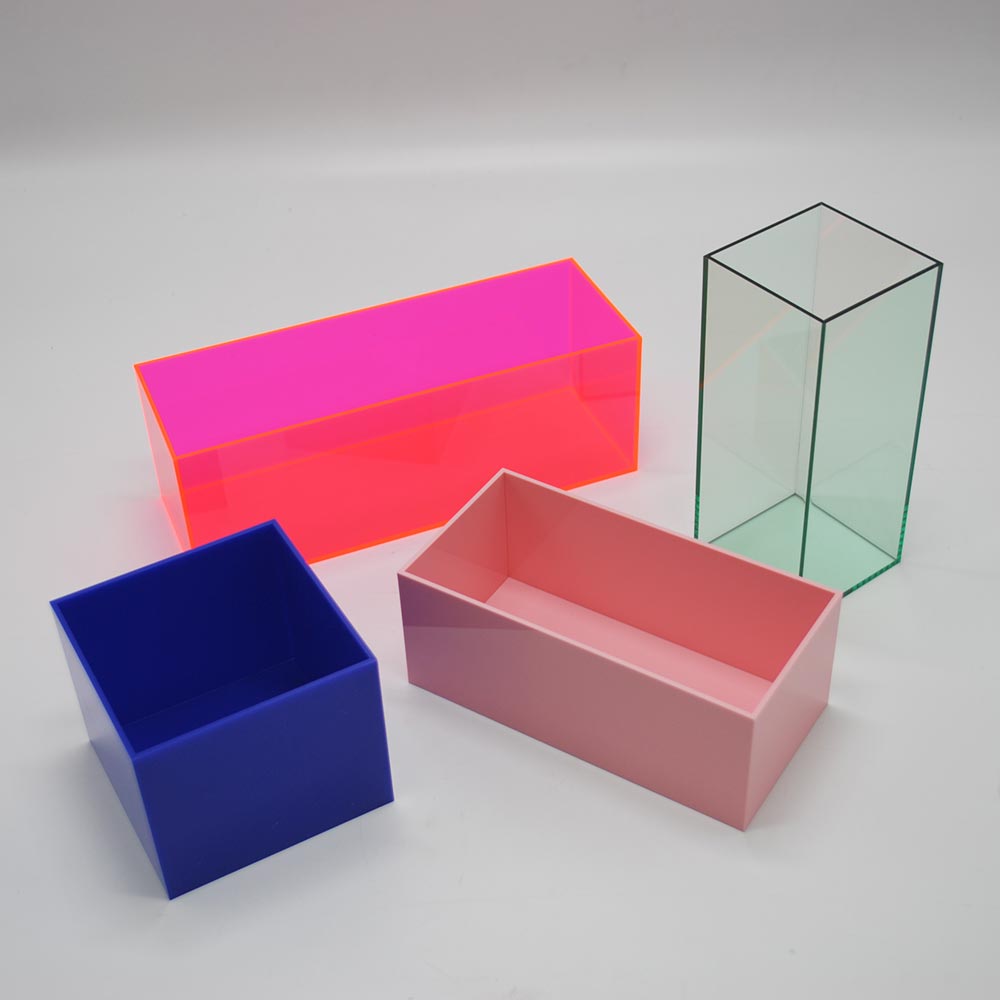
Experiments
Fanfiction or How to Change the Rules
[ Miriam, Alex, Jian ]
Writing a fanfiction is too difficult when you don´t agree with the rules of the game. So why not change the rules first?
https://pad.xpub.nl/p/fanfiction_jian_al_miri
„Do you think that video games are “too sexist”? Fine. Make better ones. Do you worry about the violence and injuries in athletics? Make new rules.“
Shira Chess in "Play Like a Feminist"
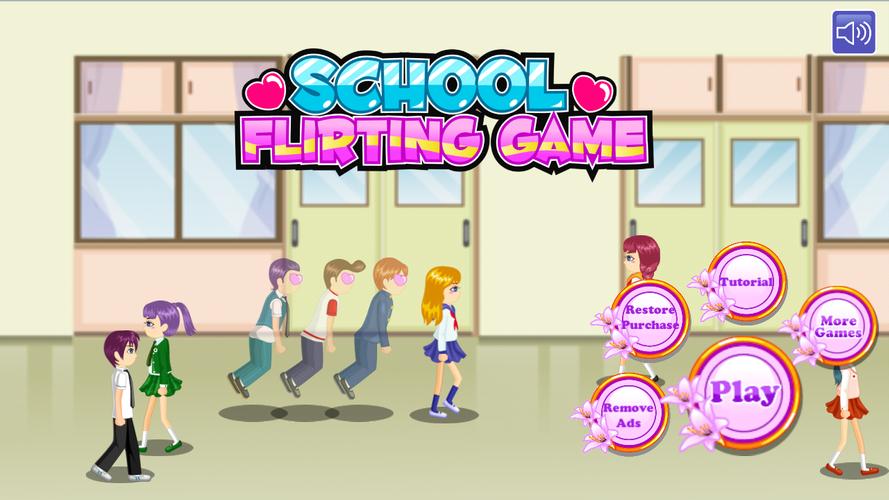
Original Rules vs. new Rules
Flirt with boys, outwit rival girls, avoid mean teachers and collect hearts in this fun Flirting on School game! The more we depict consent, the more normal it becomes. The more we practice consent, the less awkward it feels. Practice consent in this fun Enjoy the School game! Approach your crush(es), talk to your friends, debate with humans, say hi to your teachers and make friends in this fun game! Unfortunately, your time is limited, so you should hurry, because the more guys fall in love with you, the more points you get. Fortunately, you have all the time, so you shouldn´t hurry, because the more respectful you behave around your classmates, the more points you get. Click on the guys who cross your path to make them join the long line of your suitors. Wave at the people who cross your path to invite them to join your conversation. Go up and down the stairs and find every single boy in your school. Go up and down the stairs to look for more students in your school. Sometimes you have to try a little harder and click on them as fast as you can to make them fall in love with you. Sometimes people aren't interested in talking to you. You shouldn't try harder and click on them as fast as you can because they will feel uncomfortable or even harassed. Just ignore the other girls and collect the guys like diamonds so that in the end they accompany you to the altar. There's no point in seeing the other students as rivals, you don't need to collect people like diamonds because your ultimate goal is not the altar. Instead you should try to build meaningful relationships and a community where everyone feels safe. Can you find all the boys in your school and make them only have eyes for you? No pressure! Walk around and meet new people because everyone knows: A stranger is just a friend you haven't met yet! But remember: connect only with the ones who are interested in the conversation. Find out and have fun with Flirting on School, a free online game on Silvergames.com! Control: mouse Find out and have fun with Enjoy the School, a free online game on consciousgames.com! Control: heart and mind
Cocktail Generator – Round 2
Coding the Cocktail Generator
This is a new version of the code, adapted to Aymerics Good Bye Party and to the Epson-Receipt-Printer that works via Ethernet instead of USB. Oh, and this time the alcohol is optional …
from random import choice
import RPi.GPIO as GPIO
import time
from escpos.printer import Network
kitchen = Network("145.24.131.103") #EPSON Receipt Printer. Printer IP Address will be spit out when plugged
GPIO.setmode(GPIO.BCM)
GPIO.setup(18, GPIO.IN, pull_up_down=GPIO.PUD_UP)
import datetime
from datetime import timedelta
now = datetime.datetime.now() + timedelta(hours=1)
alcohol = ["VODKA", "TEQUILA", "RUM", "GIN"]
base = ["ORANGE JUICE", "PINEAPPLE JUICE", "MANGO JUICE", "PASSION FRUIT", "TONIC WATER"]
sour = ["LEMON JUICE", "LIME JUICE"]
sweet = ["AGAVE SIRUP", "MAPLE SYRUP"]
omph = ["1 SLICE GINGER", "2 LEAVES MINT", "2 LEAVES BASIL", "1 SLICE CUCUMBER"]
gadget = ["PALMTREE", "FLAMINGO", "UMBRELLA"]
drink = [
"""
___,
'._. \
_____/'-.\
| / |
|~~~/~~|
\ () /
\.__./
||
_||_
`----` """,
"""
.
. .
|^ .
\O___.____ /
\ . /
\ ,/
[]
[]
[]
--------""",
"""
\
.-\.-.-.-.-.
\ \__ o . /
\/ \ o/
\__/. /
\_ _/
Y
|
_.-- --._
`---------`"""]
while True:
input_state = GPIO.input(18)
if input_state == False:
kitchen.text(' *=*=*=*=*=*=*=*=*=*=*=*=*=*=*=* \n' +
' *=*=*=*=*=*=*=*=*=*=*=*=*=*=*=* \n' +
' * * \n' +
' * GOOD BYE FOR NOW, * \n' +
' * AYMERIC!! * \n' +
' * * \n' +
' *=*=*=*=*=*=*=*=*=*=*=*=*=*=*=* \n' +
' *=*=*=*=*=*=*=*=*=*=*=*=*=*=*=* \n' +
' \n' +
' \n' +
' 150 ml ' + choice(base) + '\n' +
' \n' +
' 1 oz ' + choice(sour) + '\n' +
' \n' +
' 0.5 oz ' + choice(sweet) + '\n' +
' \n' +
' ' + choice(omph) + '\n' +
' \n' +
' 1 ' + choice(gadget) + '\n' +
' \n' +
' \n' +
' *=*=*=*=*=*=*=*=*=*=*=*=*=*=*=* \n' +
' \n' +
' OPTIONAL:' + '\n' +
' 2 oz ' + choice(alcohol)+ '\n' +
' \n' +
' *=*=*=*=*=*=*=*=*=*=*=*=*=*=*=* \n' +
' \n' +
' ' + choice(drink) + '\n' +
' \n' +
' SEE YOU LATER ALLIGATOR, \n' +
' AFTER A WHILE CROCODILE! \n' +
' \n' +
' \n' +
' *=*=*=*=*=*=*=*=*=*=*=*=*=*=*=* \n' +
' *=*=*=*=*=*=*=*=*=*=*=*=*=*=*=* \n' +
' \n' +
' \n' +
' \n' +
' \n' +
' \n')
kitchen.cut() #cut-the-paper command ```
time.sleep(1)
*=*=*=*=*=*=*=*=*=*=*=*=*=*=*=*
*=*=*=*=*=*=*=*=*=*=*=*=*=*=*=*
* *
* GOOD BYE FOR NOW, *
* AYMERIC!! *
* *
*=*=*=*=*=*=*=*=*=*=*=*=*=*=*=*
*=*=*=*=*=*=*=*=*=*=*=*=*=*=*=*
150 ml MANGO JUICE
1 oz LIME JUICE
0.5 oz AGAVE SYRUP
2 LEAVES BASIL
1 UMBRELLA
*=*=*=*=*=*=*=*=*=*=*=*=*=*=*=*
OPTIONAL:
2 oz TEQUILA
*=*=*=*=*=*=*=*=*=*=*=*=*=*=*=*
.
. .
|^ .
\O___.____ /
\ . /
\ ,/
[]
[]
[]
--------
SEE YOU LATER ALLIGATOR,
AFTER A WHILE CROCODILE!
*=*=*=*=*=*=*=*=*=*=*=*=*=*=*=*
*=*=*=*=*=*=*=*=*=*=*=*=*=*=*=*
How to change file on Raspberry Pi
To communicate and change .py-file on raspberry pi:
1. Connect both the raspberry pi and the computer to internet via ethernet (or: connect pi and compuetr to the same network) 2. Open terminal, type: ssh pi@raspberrypi.local (or, if the pi and computer are connected to the same network: ssh pi@ip-address-of-the-pi) 3. Give default password: raspberry 4. List files: ls (Should list only one python file: final.py) 5. To access the file via GNU nano: sudo nano final.py
Change code directly on the Pi (small changes) [ ] change code [ ] confirm with: control + O "Write out" [ ] enter to confirm and control X to go back to terminal
Or change code in python file on your computer (bigger changes) delete the content of the final.py file on the Pi and then copy paste the whole code from the file on your computer: [ ] To copy a file: mv original-file-name.py copied-file-name.py [ ] Removes content of the file: sudo rm final.py [ ] List files: ls (Should list only one python file: final.py) [ ] To access the empty file via GNU nano: sudo nano final.py [ ] paste the new code [ ] confirm with: control + O "Write out" [ ] enter to confirm and control X to go back to terminal
After the changes of the file, reboot raspberry pi: sudo reboot The code should now run without using the terminal (find out why?). [ ] To run the code via the terminal: python3 final.py [ ] To stop the code via the terminal: control + c [ ] To exit the ssh without rebooting the pi: exit
Trying to setup a new Button
Message to Chae:
Lets try a very simple and easy setup that uses the new button, only without its LED light (the LED needs 12V and extra power source, so its too complicated)
1. Take photo of current setup (so that you can always go back to it!) 2. Look at the switch that comes with the new button, it should look like this (Fig. 1) 3. Leave the cable on the pins of the raspberry pi! 4. On each pin you have a female cable + a male cable that connect to the breadboard 5. Pull both males out of the breadboard 6. These two are now connected to the switch following this scheme (Fig. 2 + 3) 7. You can connect them with tape for now to test if it works! 8. The switch now has to be put into the button –it should slide in or something like that and sits behind the LED that we do not use (Fig. 4) 9. Test if it works! If yes, HURRRRAAY! If no, forget about our brillant new button, we will make it work in January and use it at the next event!

